Report from the Canadian Chronic Disease Surveillance System: Heart Disease in Canada, 2018
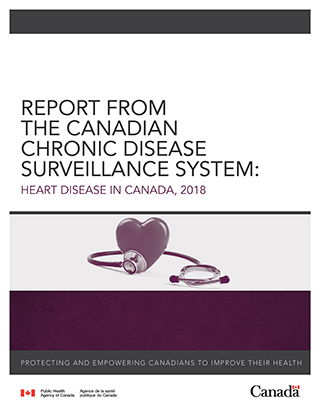
Download the entire report
(PDF format, 2.4 MB, 70 pages)
Organization: Public Health Agency of Canada
Type: Report
Published: May 2018
Cat.: HP35-85/1-2018E-PDF
ISBN: 978-0-660-24021-3
Pub.: 170307
To promote and protect the health of Canadians through leadership, partnership, innovation and action in public health.
-Public Health Agency of Canada
Également disponible en français sous le titre : Rapport du système canadien de surveillance des maladies chroniques : Les maladies du cœur au Canada, 2018
To obtain additional information, please contact:
Public Health Agency of Canada
Address Locator 0900C2
Ottawa, ON K1A 0K9
Tel.: 613-957-2991
Toll free: 1-866-225-0709
Fax: 613-941-5366
TTY: 1-800-465-7735
E-mail: publications@hc-sc.gc.ca
This publication can be made available in alternative formats upon request.
© Her Majesty the Queen in Right of Canada, as represented by the Minister of Health, 2018
Publication date: May 2018
This publication may be reproduced for personal or internal use only without permission provided the source is fully acknowledged.
Cat.: HP35-85/1-2018E-PDF
ISBN: 978-0-660-24021-3
Pub.: 170307
Table of Contents
- Executive summary
- 1. Introduction
- 2. Key findings
- 3. Ischemic heart disease and heart failure relationship
- Closing remarks
- Appendix A: Canadian Chronic Disease Surveillance System
- Appendix B: Heart disease case definitions
- Appendix C: Methods
- Appendix D: Limitations
- Glossary
- Acknowledgements
- Bibliography
Executive summary
Heart diseases
In Canada, heart disease is the second leading cause of death, after cancer, and accounted for almost 20% of all deaths in 2012. Also known as ischemic heart disease or coronary heart disease, heart disease refers to the buildup of plaque in the heart's arteries that could lead to a heart attack, a stroke or heart failure. Heart disease is the most common type of heart conditions in Canada and other industrialized countries, accounting for almost half of all heart-disease-related deaths.
Purpose of this report
This report is the first publication to include administrative health data from the Canadian Chronic Disease Surveillance System to support the national surveillance of ischemic heart disease and acute myocardial infarction (a subset of ischemic heart disease also known as heart attack) among Canadian adults aged 20 years and older as well as heart failure among Canadian adults aged 40 years and older. It features the most recent data available from the surveillance system (fiscal year 2012–2013), as well as trend data spanning over a decade.
Key findings
In 2012–2013, about 2.4 million (or 1 in 12) Canadian adults aged 20 years and older were living with ischemic heart disease, including 578,000 with a history of an acute myocardial infarction. Another 669,600 (3.6%) Canadians adults aged 40 years and older were living with heart failure.
- Heart disease outcomes are improving over time. From 2000–2001 to 2012–2013, age-standardized ischemic heart disease and heart failure incidence and all-cause mortality rates declined, while the prevalence of both conditions remained relatively stable. Respectively, incidence rates declined by 45% and 35% and all-cause mortality rates fell by 24% and 26%. A similar pattern was observed for acute myocardial infarction, although the occurrence increased by about 67% over the study period.
- Rates of death from any cause are higher among those with a heart disease than those without. Canadian adults with ischemic heart disease (IHD) were three times more likely to die of any cause compared to those without the disease in a given year. The outcome was least favorable for younger women and men aged 20 to 39 years old with ischemic heart disease who were about 18 and 11 times more likely to die of any cause, respectively, than individuals of the same age without IHD. Overall, individuals with a history of an acute myocardial infarction and those with heart failure were four and six times more likely to die of any cause than those with neither condition in a given year.
- Heart disease differs by sex. Heart disease appears about 10 years later in women than in men. In addition, age-standardized prevalence and incidence rates of diagnosed ischemic heart disease and heart failure as well as the occurrence of acute myocardial infarction were higher among men than women over the 13-year period. Similarly, age-standardized all-cause mortality rates were higher in men than women, except for acute myocardial infarction where women aged 45 to 74 years old were about 30% more likely to die of any cause than men of the same age in a given year.
Although remarkable advancements in the prevention and management of heart disease have been made in the last few decades, sustained efforts are needed to further prevent the development of heart disease risk factors, ensure early detection and treatment, and close the gap in disease occurrence between women and men. Finally, the absolute number of people living with a heart condition is increasing, thus the need for management and treatment resources for heart disease will continue to be high.
1. Introduction
1.1 Global burden of heart disease
Heart disease is the leading cause of death globally. In 2015, an estimated 8.9 million people died from heart disease, which represent 45% of all non-communicable disease deaths worldwide.Footnote 1 In addition, heart disease is the leading cause of disability-adjusted life years (DALYs) lost due to ill-health, disability or early death worldwide.Footnote 2
Infographic 0.
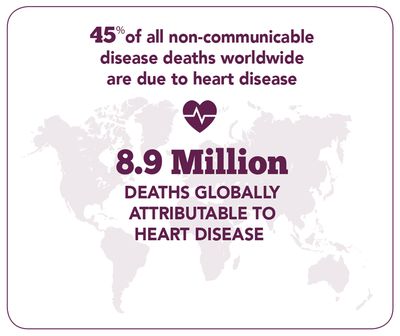
Infographic 0 - Text Description
45% of all non-communicable disease deaths worldwide are due to heart disease. 8.9 million deaths globally are attributable to heart disease.
In Canada, although major improvements in treatment, disease management and public health interventions have been made over the last few decades, heart disease is the second leading cause of death,Footnote 3 after cancer and a leading cause of hospitalization.Footnote 4 Moreover, in Canada, heart disease is the number one cause of years of life lostFootnote 1 due to premature mortality and second leading cause of DALYs lost in 2015.Footnote 2
1.2 Defining heart disease
Also known as coronary heart disease or ischemic heart disease (IHD), heart disease is a condition in which the heart muscle is damaged or does not function properly. Plaque (composed of fat, cholesterol, calcium and other substances) builds up on the inner walls of coronary arteries and, over time, it can harden or rupture. When plaque hardens, coronary arteries get narrower and it reduces the flow of blood to the heart muscle which may cause chest pain or discomfort, called angina. When plaque ruptures, a blood clot can form in a coronary artery and block blood flow to the heart, causing an acute myocardial infarction (AMI), also known as heart attack. Similarly, a stroke may occur when blood flow to the brain is interrupted or reduced. It happens when a brain blood vessel ruptures or when it is blocked.
Heart disease can also lead to heart failure and other types of heart disease, such as cardiac arrhythmias (abnormal heart rhythm).Footnote 5 Heart failure occurs when the pumping action of the heart cannot provide enough blood to the rest of the body. It results in an accumulation of fluid in the body, particularly in the lungs or legs.Footnote 6 The most common cause of heart failure is damage to the heart muscle as a result of acute myocardial infarction.
1.3 Stages in the development of heart disease
Heart disease develops over decades. A number of events occur before it progresses to end-stage heart failure. Behavioural risk factors such as unhealthy diet, physical inactivity, smoking, alcohol use and a number of medical risk conditions (e.g. hypertension, diabetes, obesity and high cholesterol) increase a person's risk of developing heart disease later in life. Without early detection, lifestyle modification and/or treatment, these risk factors may contribute to heart failure or death as depicted in Figure A below.
Figure A. Events leading to heart disease progression
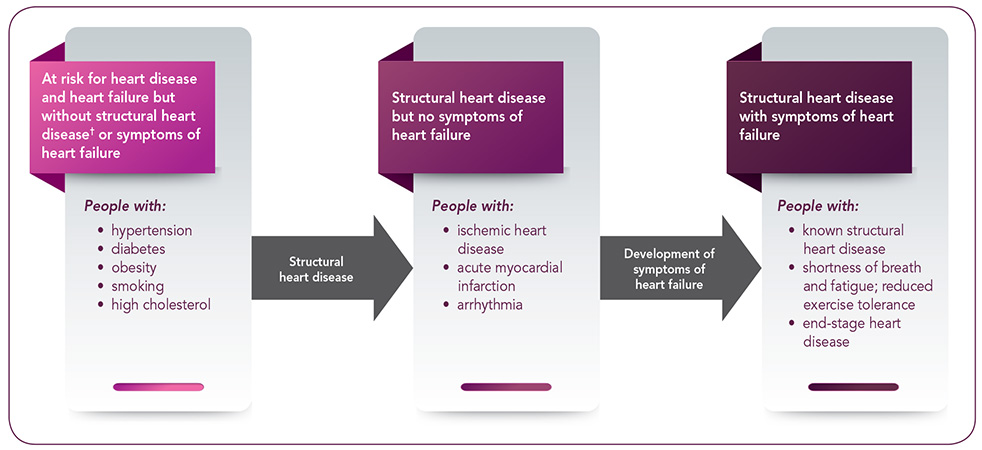
Figure adapted from Jessup M. et alFootnote 7 and Dzau VJ et al.Footnote 8
- Figure A footnote 1
-
Structural heart disease refers to a defect or abnormality in the heart's valves, heart muscle or blood vessels that can be present at birth (congenital) or acquired later in life.
Figure A. Events leading to heart disease progression - Text Description
People at risk for heart disease and heart failure but without structural heart disease or symptoms of heart failure. These include people with hypertension, diabetes, obesity, those who smoke and have high cholesterol. Then heart disease may evolve into structural heart disease without any heart failure symptoms. These would include people with ischemic heart disease, acute myocardial infarction or arrhythmia. Finally, it may evolve into heart disease with symptoms of heart failure. These people would have known structural heart disease, shortness of breath and fatigue as well as reduced exercise tolerance and ultimately, end-stage heart disease.
1.4 Purpose of this report
This is the first report from the Public Health Agency of Canada (PHAC) to include administrative health data from the Canadian Chronic Disease Surveillance System (CCDSS) for the national surveillance of heart disease in Canada. It aims to provide a national picture of the status of heart disease in Canada, in addition to highlighting trends spanning over a decade (2000–2001 to 2012–2013). Using data from the CCDSS, estimates for IHD, as well as AMI [a subset of IHD] and heart failure are described in this report. The CCDSS is a collaborative network of provincial and territorial chronic disease surveillance systems, led by PHAC. Technical and methodological notes about the CCDSS as well as definitions used to identify heart disease cases can be found in Appendices A-D. The data from the CCDSS on IHD, AMI and heart failure, as well as many other chronic conditions can be accessed online through PHAC's Public Health Infobase (https://health-infobase.canada.ca/).
2. Key findings
2.1 Improved cardiovascular health
Based on Canadian Chronic Disease Surveillance System (CCDSS) data from 2000–2001 to 2012–2013, a few common trends were observed for ischemic heart disease (IHD), acute myocardial infarction (AMI) [a subset of IHD] and heart failure. These trends are consistent with those reported in the Public Health Agency of Canada's Tracking Heart Disease and Stroke in Canada report from 2009, which indicated that death rates for heart disease have decreased dramatically from 1969 to 2004.Footnote 6
2.1.1 PrevalenceEndnote i
- The age-standardized prevalence of diagnosed IHD, among individuals aged 20 years and older, increased from 7.1% to 8.1% between 2000–2001 and 2004–2005 and then stabilizes (Figure 1A). The average annual percent change (AAPC) in prevalence is less than one percent from 2000–2001 to 2012–2013. In contrast, the percentage of people with a history of AMIEndnote ii increased from 1.2% in 2000–2001 to 2.0% in 2012–2013, representing an AAPC of 3.7% (Figure 1A).
- The number of people living with IHD continues to increase over time, from about 1.5 million in 2000–2001 to 2.4 million in 2012–2013, including about 578,000 with a history of AMI in 2012–2013 (Figure 1A).
- The age-standardized prevalence of heart failure, among individuals aged 40 years and older, remains stable at about 3.5% (Figure 1B). Similar to IHD, the AAPC in heart failure prevalence is less than one percent from 2000–2001 to 2012–2013. Over the 13-year period, the number of people living with diagnosed heart failure increased from about 467,700 to 669,600.
Infographic 1.

Infographic 1 - Text Description
The number of Canadian adults aged 20 years and older with a history of heart attack (a subset of heart disease) increased from approximately 251,000 to 578,000 between 2000–2001 and 2012–2013.
The proportion of Canadians with a history of heart attack increased by 67% over the same time period. This increase likely reflects that more and more Canadians are surviving heart attacks.
Figure 1A. Prevalence (%Figure 1A footnote † and number) of diagnosed ischemic heart disease (IHD) and occurrence (%Figure 1A footnote † and number) of acute myocardial infarction (AMI) among Canadians aged 20 years and older, CanadaFigure 1A footnote *, 2000–2001 to 2012–2013
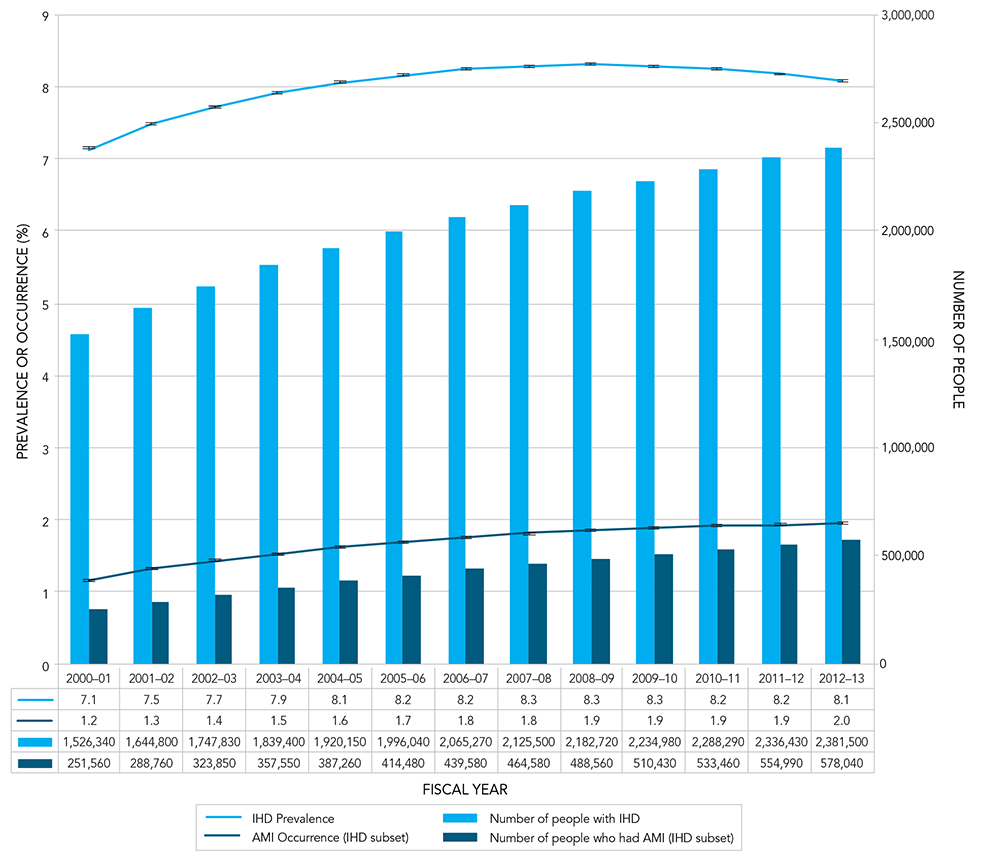
Notes: The 95% confidence interval shows an estimated range of values which is likely to include the true value 19 times out of 20.
Source: Public Health Agency of Canada, using Canadian Chronic Disease Surveillance System data files contributed by provinces and territories, May 2016.
- Figure 1A footnote 1
-
Age-standardized to the 2011 Canadian population.
- Figure 1A footnote 2
-
Data from Yukon were not available.
Figure 1A. Text description follows.
| Fiscal Year | IHD prevalence | 95% Confidence Interval | AMI Occurence (IHD subset) | 95% Confidence Interval | Number of people with IHD | Number of people who had an AMI (IHD subset) |
|---|---|---|---|---|---|---|
| 2000-2001 | 7.1% | 7.1-7.1 | 1.2% | 1.2-1.2 | 1,526,340 | 251,560 |
| 2001-2002 | 7.5% | 7.5-7.5 | 1.3% | 1.3-1.3 | 1,644,800 | 288,760 |
| 2002-2003 | 7.7% | 7.7-7.7 | 1.4% | 1.4-1.4 | 1,747,830 | 323,850 |
| 2003-2004 | 7.9% | 7.9-7.9 | 1.5% | 1.5-1.5 | 1,839,400 | 357,550 |
| 2004-2005 | 8.1% | 8.1-8.1 | 1.6% | 1.6-1.6 | 1,920,150 | 387,260 |
| 2005-2006 | 8.2% | 8.2-8.2 | 1.7% | 1.7-1.7 | 1,996,040 | 414,480 |
| 2006-2007 | 8.2% | 8.2-8.3 | 1.8% | 1.7-1.8 | 2,065,270 | 439,580 |
| 2007-2008 | 8.3% | 8.3-8.3 | 1.8% | 1.8-1.8 | 2,125,500 | 464,580 |
| 2008-2009 | 8.3% | 8.3-8.3 | 1.9% | 1.9-1.9 | 2,182,720 | 488,560 |
| 2009-2010 | 8.3% | 8.3-8.3 | 1.9% | 1.9-1.9 | 2,234,980 | 510,430 |
| 2010-2011 | 8.2% | 8.2-8.3 | 1.9% | 1.9-1.9 | 2,288,290 | 533,460 |
| 2011-2012 | 8.2% | 8.2-8.2 | 1.9% | 1.9-1.9 | 2,336,430 | 554,990 |
| 2012-2013 | 8.1% | 8.1-8.1 | 2.0% | 2.0-2.0 | 2,381,500 | 578,040 |
Notes: The 95% confidence interval shows an estimated range of values which is likely to include the true value 19 times out of 20. Source: Public Health Agency of Canada, using Canadian Chronic Disease Surveillance System data files contributed by provinces and territories, May 2016. |
||||||
Figure 1B. Age-standardizedFigure 1B footnote † prevalence of diagnosed heart failure and number of people with heart failure, among Canadians aged 40 years and older, CanadaFigure 1B footnote *, 2000–2001 to 2012–2013
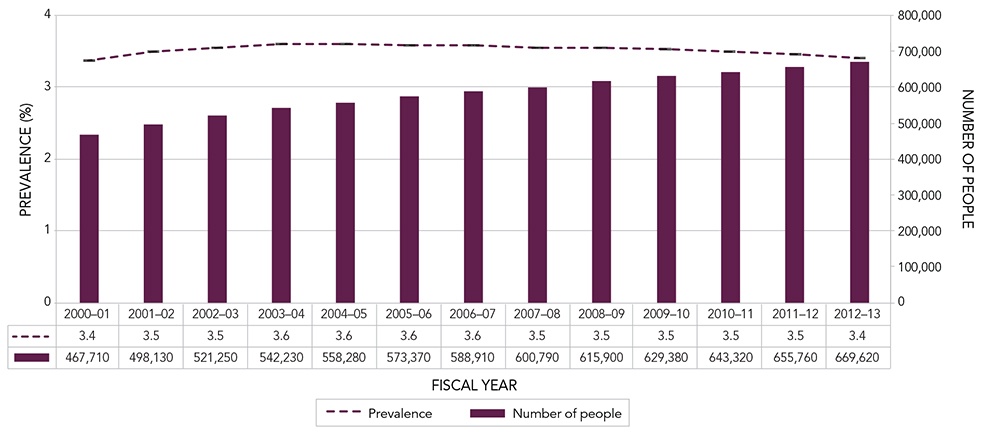
Notes: The 95% confidence interval shows an estimated range of values which is likely to include the true value 19 times out of 20.
Source: Public Health Agency of Canada, using Canadian Chronic Disease Surveillance System data files contributed by provinces and territories, May 2016.
- Figure 1B footnote 1
-
Age-standardized to the 2011 Canadian population.
- Figure 1B footnote 2
-
Data from Yukon were not available.
Figure 1B. Text description follows.
| Fiscal Year | Prevalence | 95% Confidence Interval | Number of people |
|---|---|---|---|
| 2000-2001 | 3.4% | 3.4-3.4 | 467,710 |
| 2001-2002 | 3.5% | 3.5-3.5 | 498,130 |
| 2002-2003 | 3.5% | 3.5-3.6 | 521,250 |
| 2003-2004 | 3.6% | 3.6-3.6 | 542,230 |
| 2004-2005 | 3.6% | 3.6-3.6 | 558,280 |
| 2005-2006 | 3.6% | 3.6-3.6 | 573,370 |
| 2006-2007 | 3.6% | 3.6-3.6 | 588,910 |
| 2007-2008 | 3.5% | 3.5-3.6 | 600,790 |
| 2008-2009 | 3.5% | 3.5-3.6 | 615,900 |
| 2009-2010 | 3.5% | 3.5-3.5 | 629,380 |
| 2010-2011 | 3.5% | 3.5-3.5 | 643,320 |
| 2011-2012 | 3.5% | 3.4-3.5 | 655,760 |
| 2012-2013 | 3.4% | 3.4-3.4 | 669,620 |
Notes: The 95% confidence interval shows an estimated range of values which is likely to include the true value 19 times out of 20. Source: Public Health Agency of Canada, using Canadian Chronic Disease Surveillance System data files contributed by provinces and territories, May 2016. |
|||
2.1.2 Incidence (new cases)
- The age-standardized incidence rate of IHD decreased from 12.3 per 1,000 in 2000–2001 to 6.8 per 1,000 in 2012–2013, with an AAPC of -4.6%. The age-standardized occurrence rate of a first AMI also declined, from 3.0 per 1,000 in 2000–2001 to 2.2 per 1,000 in 2012–2013, with an AAPC of -1.8% (Figure 2A).
- The number of people newly diagnosed with IHD declined from about 221,800 to 158,700 between 2000–2001 and 2012–2013. However, the number of people having a first AMI remained relatively stable at about 62,000 people annually (Figure 2A).
- The age-standardized incidence rate of heart failure declined from 8.1 per 1,000 to 5.3 per 1,000 between 2000–2001 and 2012–2013, with an AAPC of -3.1%. Over the same period, the number of people newly diagnosed with heart failure fell from about 102,800 to 92,900 individuals (Figure 2B).
Infographic 2.
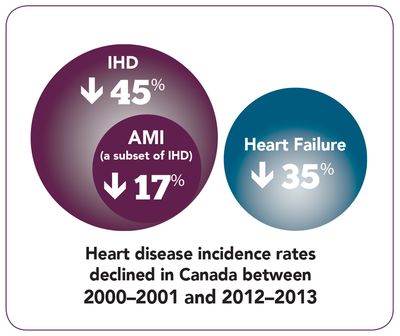
Infographic 2 - Text Description
Heart disease incidence rates declined in Canada between 2000–2001 and 2012–2013. Rates declined by 45% for IHD, 17% for AMI (a subset of IHD) and by 35% for heart failure.
Figure 2A. Incidence (ratesFigure 2A footnote † and number) of diagnosed ischemic heart disease (IHD) and occurrence (ratesFigure 2A footnote †and number) of first acute myocardial infarction (AMI) among Canadians aged 20 years and older, CanadaFigure 2A footnote *, 2000–2001 to 2012–2013
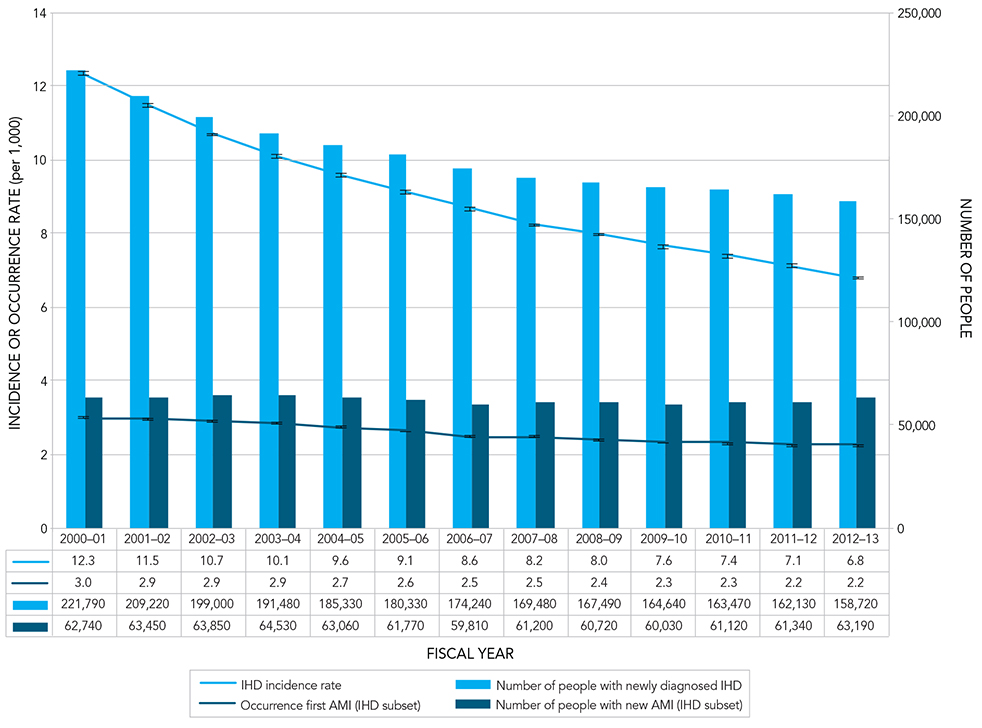
Notes: The 95% confidence interval shows an estimated range of values which is likely to include the true value 19 times out of 20.
Source: Public Health Agency of Canada, using Canadian Chronic Disease Surveillance System data files contributed by provinces and territories, May 2016.
- Figure 2A footnote 1
-
Age-standardized to the 2011 Canadian population.
- Figure 2A footnote 2
-
Data from Yukon were not available.
Figure 2A. Text description follows.
| Fiscal Year | IHD incidence rate | 95% Confidence Interval | Occurrence first AMI (IHD subset) | 95% Confidence Interval | Number of people with newly diagnosed IHD | Number of people with new AMI (IHD subset) |
|---|---|---|---|---|---|---|
| 2000-2001 | 12.3 per 1,000 people | 12.3-12.4 | 3.0 per 1,000 people | 3.0-3.0 | 221,790 | 62,740 |
| 2001-2002 | 11.5 per 1,000 people | 11.4-11.5 | 2.9 per 1,000 people | 2.9-3.0 | 209,220 | 63,450 |
| 2002-2003 | 10.7 per 1,000 people | 10.6-10.7 | 2.9 per 1,000 people | 2.9-2.9 | 199,000 | 63,850 |
| 2003-2004 | 10.1 per 1,000 people | 10.0-10.1 | 2.9 per 1,000 people | 2.8-2.9 | 191,480 | 64,530 |
| 2004-2005 | 9.6 per 1,000 people | 9.5-9.6 | 2.7 per 1,000 people | 2.7-2.8 | 185,330 | 63,060 |
| 2005-2006 | 9.1 per 1,000 people | 9.1-9.2 | 2.6 per 1,000 people | 2.6-2.6 | 180,330 | 61,770 |
| 2006-2007 | 8.6 per 1,000 people | 8.6-8.7 | 2.5 per 1,000 people | 2.5-2.5 | 174,240 | 59,810 |
| 2007-2008 | 8.2 per 1,000 people | 8.2-8.3 | 2.5 per 1,000 people | 2.5-2.5 | 169,480 | 61,200 |
| 2008-2009 | 8.0 per 1,000 people | 7.9-8.0 | 2.4 per 1,000 people | 2.4-2.4 | 167,490 | 60,720 |
| 2009-2010 | 7.6 per 1,000 people | 7.6-7.7 | 2.3 per 1,000 people | 2.3-2.3 | 164,640 | 60,030 |
| 2010-2011 | 7.4 per 1,000 people | 7.3-7.4 | 2.3 per 1,000 people | 2.3-2.3 | 163,470 | 61,120 |
| 2011-2012 | 7.1 per 1,000 people | 7.1-7.1 | 2.2 per 1,000 people | 2.2-2.3 | 162,130 | 61,340 |
| 2012-2013 | 6.8 per 1,000 people | 6.7-6.8 | 2.2 per 1,000 people | 2.2-2.3 | 158,720 | 63,190 |
Notes: The 95% confidence interval shows an estimated range of values which is likely to include the true value 19 times out of 20. Source: Public Health Agency of Canada, using Canadian Chronic Disease Surveillance System data files contributed by provinces and territories, May 2016. |
||||||
Figure 2B. Age-standardizedFigure 2B footnote † incidence rates of diagnosed heart failure and number of people with heart failure, among Canadians aged 40 years and older, CanadaFigure 2B footnote *, 2000–2001 to 2012–2013
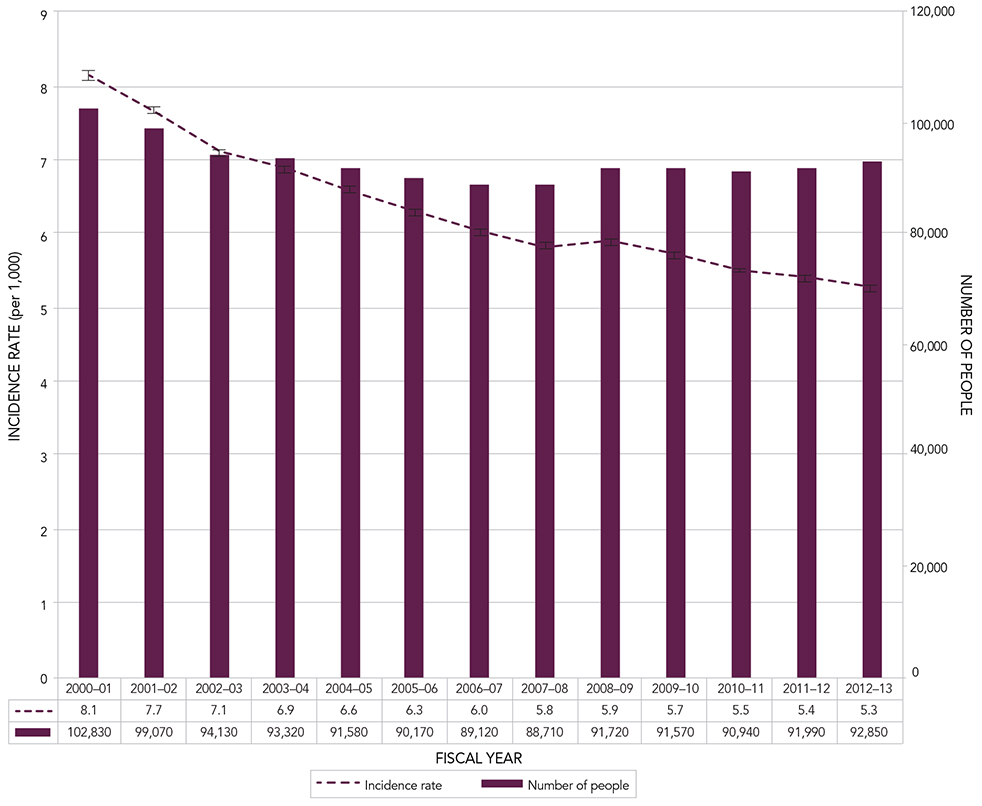
Notes: The 95% confidence interval shows an estimated range of values which is likely to include the true value 19 times out of 20.
Source: Public Health Agency of Canada, using Canadian Chronic Disease Surveillance System data files contributed by provinces and territories, May 2016.
- Figure 2B footnote 1
-
Age-standardized to the 2011 Canadian population.
- Figure 2B footnote 2
-
Data from Yukon were not available.
Figure 2B. Text description follows.
| Fiscal Year | Incidence rate | 95% Confidence Interval | Number of people |
|---|---|---|---|
| 2000-2001 | 8.1 per 1,000 people | 8.1-8.2 | 102,830 |
| 2001-2002 | 7.7 per 1,000 people | 7.6-7.7 | 99,070 |
| 2002-2003 | 7.1 per 1,000 people | 7.1-7.2 | 94,130 |
| 2003-2004 | 6.9 per 1,000 people | 6.8-6.9 | 93,320 |
| 2004-2005 | 6.6 per 1,000 people | 6.5-6.6 | 91,580 |
| 2005-2006 | 6.3 per 1,000 people | 6.2-6.3 | 90,170 |
| 2006-2007 | 6.0 per 1,000 people | 6.0-6.1 | 89,120 |
| 2007-2008 | 5.8 per 1,000 people | 5.8-5.9 | 88,710 |
| 2008-2009 | 5.9 per 1,000 people | 5.8-5.9 | 91,720 |
| 2009-2010 | 5.7 per 1,000 people | 5.7-5.7 | 91,570 |
| 2010-2011 | 5.5 per 1,000 people | 5.5-5.5 | 90,940 |
| 2011-2012 | 5.4 per 1,000 people | 5.4-5.4 | 91,990 |
| 2012-2013 | 5.3 per 1,000 people | 5.2-5.3 | 92,850 |
Notes: The 95% confidence interval shows an estimated range of values which is likely to include the true value 19 times out of 20. Source: Public Health Agency of Canada, using Canadian Chronic Disease Surveillance System data files contributed by provinces and territories, May 2016. |
|||
2.1.3 All-Cause Mortality Rates
Infographic 3.

- The age-standardized all-cause mortality rate among people living with IHD and those with a history of AMI decreased substantially between 2000–2001 and 2012–2013, from 22.5 to 17.1 per 1,000 and from 42.2 to 27.5 per 1,000, respectively, with corresponding AAPCs of -1.3% and -2.9% (Figure 3A).
- On the other hand, the absolute number of deaths has increased over time, from about 86,300 deaths in 2000–2001 to 112,200 deaths in 2012–2013 in those with diagnosed IHD, including a rise in the number of deaths among those with a history of AMI, from about 25,600 deaths to 41,500 deaths (Figure 3A). Overall, all-cause deaths among those with a history of AMI represented over one third of all deaths in those with IHD.
- The age-standardized all-cause mortality rate among people living with heart failure declined from 78.4 to 57.8 per 1,000 between 2000–2001 and 2012–2013, with an AAPC of -2.5%. The number of people with heart failure who died of any cause increased from 67,300 in 2000–2001 to 80,100 in 2012–2013 (Figure 3B).
Infographic 4.
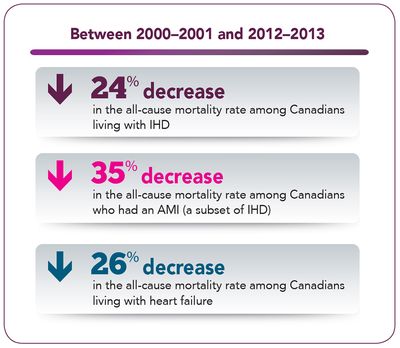
Infographic 4 - Text Description
Between 2000–2001 and 2012–2013, all-cause mortality rates declined by 24% among Canadians living with IHD, by 35% in those who had an AMI (a subset of IHD) and by 26% in those living with heart failure.
Figure 3A. Age-standardizedFigure 3A footnote † all-cause mortality rates and number of deaths among Canadians aged 20 years and older with diagnosed ischemic heart disease (IHD) and those who had an acute myocardial infarction (AMI), CanadaFigure 3A footnote *, 2000–2001 to 2012–2013
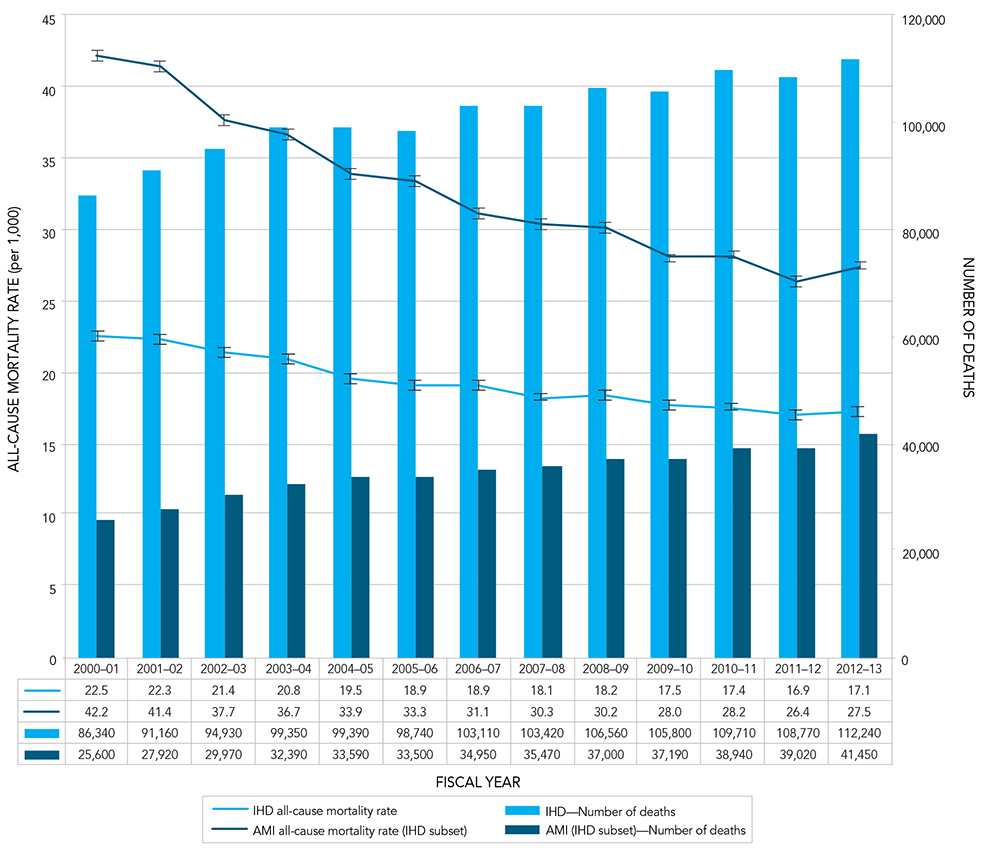
Notes: The 95% confidence interval shows an estimated range of values which is likely to include the true value 19 times out of 20.
Source: Public Health Agency of Canada, using Canadian Chronic Disease Surveillance System data files contributed by provinces and territories, May 2016.
- Figure 3A footnote 1
-
Age-standardized to the 2011 Canadian population.
- Figure 3A footnote 2
-
Data from Yukon were not available.
Figure 3A. Text description follows.
| Fiscal Year | IHD all-cause mortality rate | 95% Confidence Interval | AMI all-cause mortality rate (IHD subset) | 95% Confidence Interval | IHD - Number of deaths | AMI (IHD subset) - Number of deaths |
|---|---|---|---|---|---|---|
| 2000-2001 | 22.5 per 1,000 people | 22.1-23.0 | 42.2 per 1,000 people | 41.0-43.4 | 86,340 | 25,600 |
| 2001-2002 | 22.3 per 1,000 people | 21.9-22.8 | 41.4 per 1,000 people | 40.2-42.7 | 91,160 | 27,920 |
| 2002-2003 | 21.4 per 1,000 people | 21.1-21.8 | 37.7 per 1,000 people | 36.7-38.8 | 94,930 | 29,970 |
| 2003-2004 | 20.8 per 1,000 people | 20.4-21.2 | 36.7 per 1,000 people | 35.6-37.8 | 99,350 | 32,390 |
| 2004-2005 | 19.5 per 1,000 people | 19.2-19.8 | 33.9 per 1,000 people | 33.0-34.9 | 99,390 | 33,590 |
| 2005-2006 | 18.9 per 1,000 people | 18.6-19.3 | 33.3 per 1,000 people | 32.3-34.4 | 98,740 | 33,500 |
| 2006-2007 | 18.9 per 1,000 people | 18.6-19.3 | 31.1 per 1,000 people | 30.2-32.1 | 103,110 | 34,950 |
| 2007-2008 | 18.1 per 1,000 people | 17.8-18.4 | 30.3 per 1,000 people | 29.4-31.3 | 103,420 | 35,470 |
| 2008-2009 | 18.2 per 1,000 people | 17.9-18.6 | 30.2 per 1,000 people | 29.2-31.2 | 106,560 | 37,000 |
| 2009-2010 | 17.5 per 1,000 people | 17.2-17.8 | 28.0 per 1,000 people | 27.1-29.0 | 105,800 | 37,190 |
| 2010-2011 | 17.4 per 1,000 people | 17.1-17.7 | 28.2 per 1,000 people | 27.3-29.2 | 109,710 | 38,940 |
| 2011-2012 | 16.9 per 1,000 people | 16.6-17.2 | 26.4 per 1,000 people | 25.5-27.3 | 108,770 | 39,020 |
| 2012-2013 | 17.1 per 1,000 people | 16.8-17.5 | 27.5 per 1,000 people | 26.5-28.5 | 112,240 | 41,450 |
Notes: The 95% confidence interval shows an estimated range of values which is likely to include the true value 19 times out of 20. Source: Public Health Agency of Canada, using Canadian Chronic Disease Surveillance System data files contributed by provinces and territories, May 2016. |
||||||
Figure 3B. Age-standardizedFigure 3B footnote † all-cause mortality rates and number of deaths among Canadians aged 40 years and older with diagnosed heart failure, CanadaFigure 3B footnote *, 2000–2001 to 2012–2013
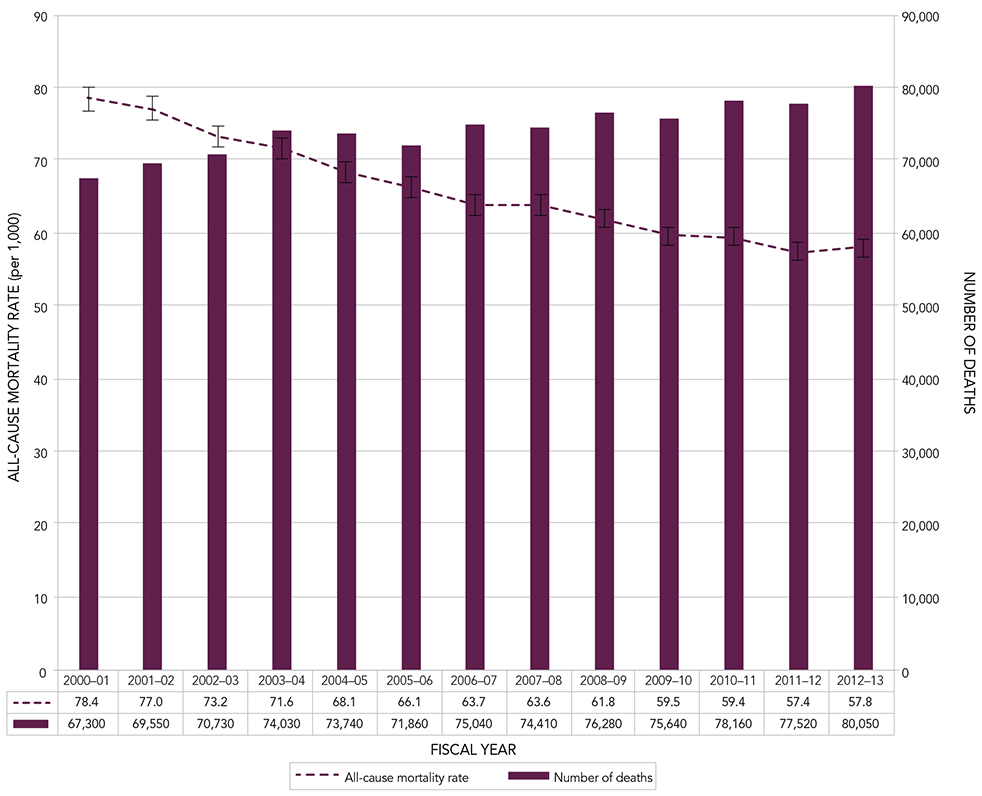
Notes: The 95% confidence interval shows an estimated range of values which is likely to include the true value 19 times out of 20.
Source: Public Health Agency of Canada, using Canadian Chronic Disease Surveillance System data files contributed by provinces and territories, May 2016.
- Figure 3B footnote 1
-
Age-standardized to the 2011 Canadian population.
- Figure 3B footnote 2
-
Data from Yukon were not available.
Figure 3B. Text description follows.
| Fiscal Year | All-cause mortality rate | 95% Confidence Interval | Number of deaths |
|---|---|---|---|
| 2000-2001 | 78.4 per 1,000 people | 76.8-80.1 | 67,300 |
| 2001-2002 | 77.0 per 1,000 people | 75.4-78.6 | 69,550 |
| 2002-2003 | 73.2 per 1,000 people | 71.6-74.8 | 70,730 |
| 2003-2004 | 71.6 per 1,000 people | 70.1-73.1 | 74,030 |
| 2004-2005 | 68.1 per 1,000 people | 66.7-69.6 | 73,740 |
| 2005-2006 | 66.1 per 1,000 people | 64.6-67.5 | 71,860 |
| 2006-2007 | 63.7 per 1,000 people | 62.4-65.1 | 75,040 |
| 2007-2008 | 63.6 per 1,000 people | 62.3-65.0 | 74,410 |
| 2008-2009 | 61.8 per 1,000 people | 60.5-63.1 | 76,280 |
| 2009-2010 | 59.5 per 1,000 people | 58.3-60.8 | 75,640 |
| 2010-2011 | 59.4 per 1,000 people | 58.2-60.7 | 78,160 |
| 2011-2012 | 57.4 per 1,000 people | 56.2-58.6 | 77,520 |
| 2012-2013 | 57.8 per 1,000 people | 56.6-59.1 | 80,050 |
Canadian adults with heart disease have higher mortality rates compared to those without heart disease
- Compared to those without IHD, AMI or heart failure, individuals with the disease of interest are more likely to die of any cause in a given year.
- Age-standardized all-cause mortality rates were almost three times higher, on average, among Canadian adults with diagnosed IHD compared to those without in a given year (Figure 4A).
- Compared to those without a prior history of AMI, those with a history of AMI were about four times more likely to die of any cause in 2012–2013 (Figure 4B). The gap between those with and without a history of AMI has reduced over time, since the rate ratio was as high as 4.7 in the early 2000s.
- In a given year, Canadians aged 40 years and older with diagnosed heart failure were, on average, six times more likely to die of any cause than those without heart failure (Figure 4C).
Infographic 5.
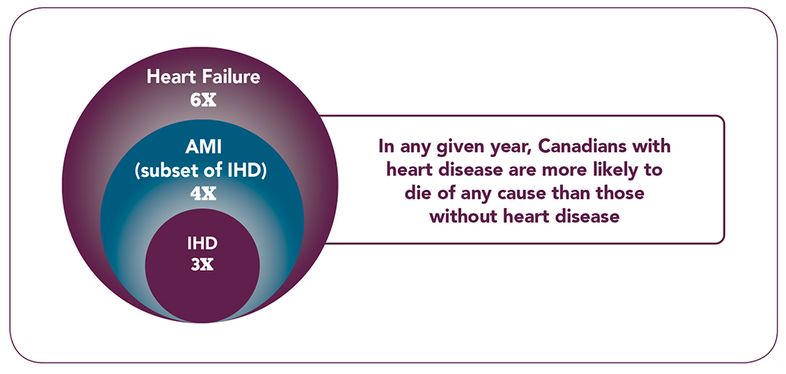
Infographic 5 - Text Description
In any given year, Canadians with IHD, Canadians who had an AMI and those with heart failure are three, four and six times more likely to die of any cause than those without these diseases, respectively.
Figure 4A. Age-standardizedFigure 4A footnote † all-cause mortality rates and rate ratios among Canadians aged 20 years and older with and without ischemic heart disease (IHD), CanadaFigure 4A footnote *, 2000–2001 to 2012–2013
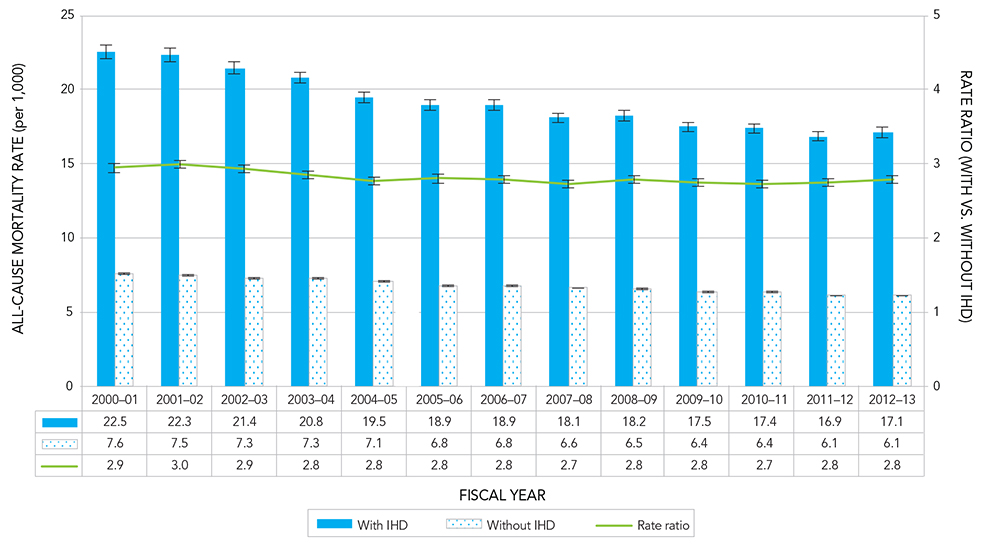
Notes: The 95% confidence interval shows an estimated range of values which is likely to include the true value 19 times out of 20.
Source: Public Health Agency of Canada, using Canadian Chronic Disease Surveillance System data files contributed by provinces and territories, May 2016.
- Figure 4A footnote 1
-
Age-standardized to the 2011 Canadian population.
- Figure 4A footnote 2
-
Data from Yukon were not available.
Figure 4A. Text description follows.
| Fiscal Year | With IHD | 95% Confidence Interval | Without IHD | 95% Confidence Interval | Rate ratio | 95% Confidence Interval |
|---|---|---|---|---|---|---|
| 2000-2001 | 22.5 per 1,000 people | 22.1-23.0 | 7.6 per 1,000 people | 7.6-7.7 | 2.9 | 2.9 - 3.0 |
| 2001-2002 | 22.3 per 1,000 people | 21.9-22.8 | 7.5 per 1,000 people | 7.4-7.5 | 3.0 | 2.9 - 3.1 |
| 2002-2003 | 21.4 per 1,000 people | 21.1-21.8 | 7.3 per 1,000 people | 7.3-7.4 | 2.9 | 2.9 - 3.0 |
| 2003-2004 | 20.8 per 1,000 people | 20.4-21.2 | 7.3 per 1,000 people | 7.3-7.3 | 2.8 | 2.8 -2.9 |
| 2004-2005 | 19.5 per 1,000 people | 19.2-19.8 | 7.1 per 1,000 people | 7.0-7.1 | 2.8 | 2.7 -2.8 |
| 2005-2006 | 18.9 per 1,000 people | 18.6-19.3 | 6.8 per 1,000 people | 6.7-6.8 | 2.8 | 2.7 -2.9 |
| 2006-2007 | 18.9 per 1,000 people | 18.6-19.3 | 6.8 per 1,000 people | 6.8-6.8 | 2.8 | 2.7 -2.8 |
| 2007-2008 | 18.1 per 1,000 people | 17.8-18.4 | 6.6 per 1,000 people | 6.6-6.7 | 2.7 | 2.7 -2.8 |
| 2008-2009 | 18.2 per 1,000 people | 17.9-18.6 | 6.5 per 1,000 people | 6.5-6.6 | 2.8 | 2.7 -2.8 |
| 2009-2010 | 17.5 per 1,000 people | 17.2-17.8 | 6.4 per 1,000 people | 6.3-6.4 | 2.8 | 2.7 -2.8 |
| 2010-2011 | 17.4 per 1,000 people | 17.1-17.7 | 6.4 per 1,000 people | 6.3-6.4 | 2.7 | 2.7 -2.8 |
| 2011-2012 | 16.9 per 1,000 people | 16.6-17.2 | 6.1 per 1,000 people | 6.1-6.2 | 2.8 | 2.7 -2.8 |
| 2012-2013 | 17.1 per 1,000 people | 16.8-17.5 | 6.1 per 1,000 people | 6.1-6.2 | 2.8 | 2.7 -2.8 |
Figure 4B. Age-standardizedFigure 4B footnote † all-cause mortality rates and rate ratios among Canadians aged 20 years and older with and without acute myocardial infarction (AMI), CanadaFigure 4B footnote *, 2000–2001 to 2012–2013
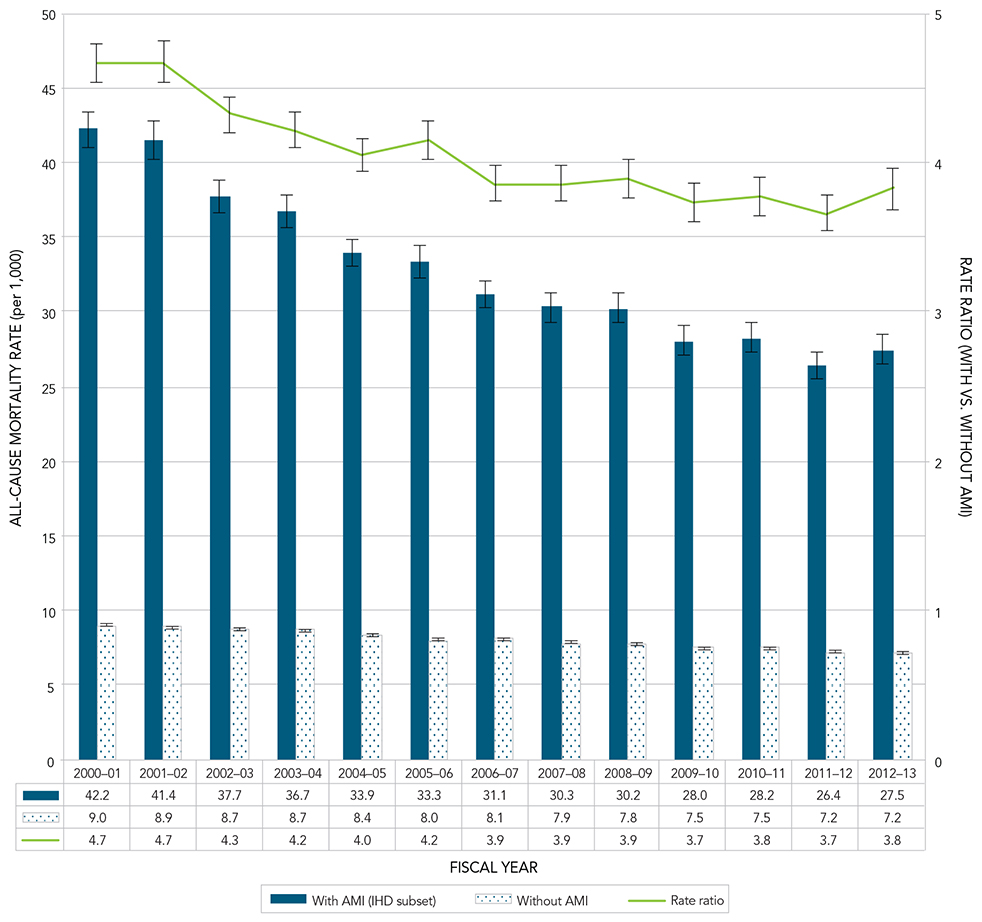
Notes: The 95% confidence interval shows an estimated range of values which is likely to include the true value 19 times out of 20.
Source: Public Health Agency of Canada, using Canadian Chronic Disease Surveillance System data files contributed by provinces and territories, May 2016.
- Figure 4B footnote 1
-
Age-standardized to the 2011 Canadian population.
- Figure 4B footnote 2
-
Data from Yukon were not available.
Figure 4B. Text description follows.
| Fiscal Year | With AMI (IHD subset) | 95% Confidence Interval | Without AMI | 95% Confidence Interval | Rate ratio | 95% Confidence Interval |
|---|---|---|---|---|---|---|
| 2000-2001 | 42.2 per 1,000 people | 41.0-43.4 | 9.0 per 1,000 people | 9.0-9.1 | 4.7 | 4.5 - 4.8 |
| 2001-2002 | 41.4 per 1,000 people | 40.2-42.7 | 8.9 per 1,000 people | 8.8-8.9 | 4.7 | 4.5 - 4.8 |
| 2002-2003 | 37.7 per 1,000 people | 36.7-38.8 | 8.7 per 1,000 people | 8.7-8.8 | 4.3 | 4.2 - 4.4 |
| 2003-2004 | 36.7 per 1,000 people | 35.6-37.8 | 8.7 per 1,000 people | 8.7-8.7 | 4.2 | 4.1 - 4.3 |
| 2004-2005 | 33.9 per 1,000 people | 33.0-34.9 | 8.4 per 1,000 people | 8.3-8.4 | 4.0 | 3.9 - 4.2 |
| 2005-2006 | 33.3 per 1,000 people | 32.3-34.4 | 8.0 per 1,000 people | 8.0-8.1 | 4.2 | 4.0 - 4.3 |
| 2006-2007 | 31.1 per 1,000 people | 30.2-32.1 | 8.1 per 1,000 people | 8.0-8.1 | 3.9 | 3.7 - 4.0 |
| 2007-2008 | 30.3 per 1,000 people | 29.4-31.3 | 7.9 per 1,000 people | 7.8-7.9 | 3.9 | 3.7 - 4.0 |
| 2008-2009 | 30.2 per 1,000 people | 29.2-31.2 | 7.8 per 1,000 people | 7.7-7.8 | 3.9 | 3.8 - 4.0 |
| 2009-2010 | 28.0 per 1,000 people | 27.1-29.0 | 7.5 per 1,000 people | 7.5-7.5 | 3.7 | 3.6 - 3.9 |
| 2010-2011 | 28.2 per 1,000 people | 27.3-29.2 | 7.5 per 1,000 people | 7.5-7.5 | 3.8 | 3.6 - 3.9 |
| 2011-2012 | 26.4 per 1,000 people | 25.5-27.3 | 7.2 per 1,000 people | 7.2-7.2 | 3.7 | 3.5 - 3.8 |
| 2012-2013 | 27.5 per 1,000 people | 26.5-28.5 | 7.2 per 1,000 people | 7.2-7.2 | 3.8 | 3.7 - 4.0 |
Notes: The 95% confidence interval shows an estimated range of values which is likely to include the true value 19 times out of 20. Source: Public Health Agency of Canada, using Canadian Chronic Disease Surveillance System data files contributed by provinces and territories, May 2016. |
||||||
Figure 4C. Age-standardizedFigure 4C footnote † all-cause mortality rates and rate ratios among Canadians aged 40 years and older with and without heart failure, CanadaFigure 4C footnote *, 2000–2001 to 2012–2013
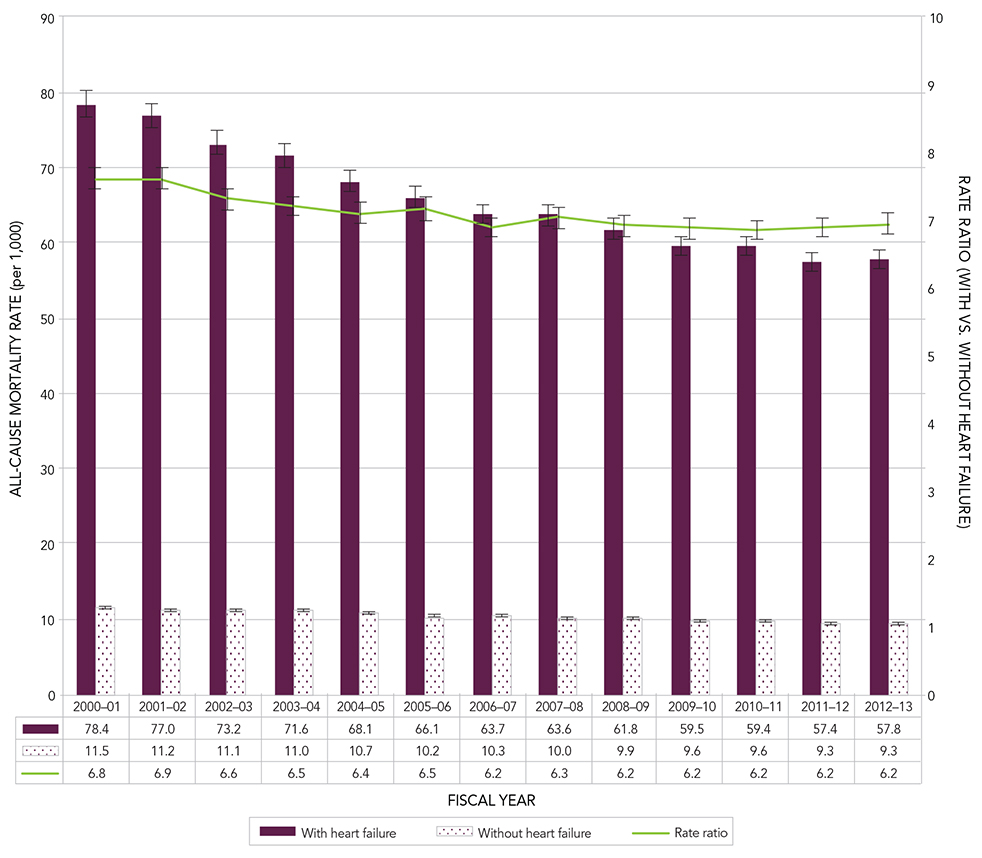
Notes: The 95% confidence interval shows an estimated range of values which is likely to include the true value 19 times out of 20.
Source: Public Health Agency of Canada, using Canadian Chronic Disease Surveillance System data files contributed by provinces and territories, May 2016.
- Figure 4C footnote 1
-
Age-standardized to the 2011 Canadian population.
- Figure 4C footnote 2
-
Data from Yukon were not available.
Figure 4C. Text description follows.
| Fiscal Year | With heart failure | 95% Confidence Interval | Without heart failure | 95% Confidence Interval | Rate ratio | 95% Confidence Interval |
|---|---|---|---|---|---|---|
| 2000-2001 | 78.4 per 1,000 people | 76.8-80.1 | 11.5 per 1,000 people | 11.4-11.5 | 6.8 | 6.7-7.0 |
| 2001-2002 | 77.0 per 1,000 people | 75.4-78.6 | 11.2 per 1,000 people | 11.2-11.3 | 6.9 | 6.7-7.0 |
| 2002-2003 | 73.2 per 1,000 people | 71.6-74.8 | 11.1 per 1,000 people | 11.1-11.2 | 6.6 | 6.4-6.7 |
| 2003-2004 | 71.6 per 1,000 people | 70.1-73.1 | 11.0 per 1,000 people | 11.0-11.1 | 6.5 | 6.3-6.6 |
| 2004-2005 | 68.1 per 1,000 people | 66.7-69.6 | 10.7 per 1,000 people | 10.6-10.7 | 6.4 | 6.3-6.5 |
| 2005-2006 | 66.1 per 1,000 people | 64.6-67.5 | 10.2 per 1,000 people | 10.2-10.3 | 6.5 | 6.3-6.6 |
| 2006-2007 | 63.7 per 1,000 people | 62.4-65.1 | 10.3 per 1,000 people | 10.2-10.3 | 6.2 | 6.1-6.3 |
| 2007-2008 | 63.6 per 1,000 people | 62.3-65.0 | 10.0 per 1,000 people | 10.0-10.1 | 6.3 | 6.2-6.5 |
| 2008-2009 | 61.8 per 1,000 people | 60.5-63.1 | 9.9 per 1,000 people | 9.9-10.0 | 6.2 | 6.1-6.4 |
| 2009-2010 | 59.5 per 1,000 people | 58.3-60.8 | 9.6 per 1,000 people | 9.6-9.7 | 6.2 | 6.1-6.3 |
| 2010-2011 | 59.4 per 1,000 people | 58.2-60.7 | 9.6 per 1,000 people | 9.6-9.7 | 6.2 | 6.0-6.3 |
| 2011-2012 | 57.4 per 1,000 people | 56.2-58.6 | 9.3 per 1,000 people | 9.2-9.3 | 6.2 | 6.1-6.3 |
| 2012-2013 | 57.8 per 1,000 people | 56.6-59.1 | 9.3 per 1,000 people | 9.2-9.3 | 6.2 | 6.1-6.4 |
Notes: The 95% confidence interval shows an estimated range of values which is likely to include the true value 19 times out of 20. Source: Public Health Agency of Canada, using Canadian Chronic Disease Surveillance System data files contributed by provinces and territories, May 2016. |
||||||
Multiple factors explain improved cardiovascular health
Between 2000–2001 and 2012–2013, age-standardized incidence (occurrence in the case of AMI) and all-cause mortality rates have declined greatly among those with IHD and heart failure and those having had an AMI.
Using a validated mortality model, Ford E. et al. quantified the respective contribution of major risk factors and medical treatments to the decline in mortality from coronary heart disease between 1980 and 2000, among American adults aged 25 to 84 years old. About 47% of this decline in mortality was attributed to treatments, including medications or rehabilitation, after an AMI. Approximately 44% of the decline was also attributed to changes in risk factors, namely decreases in total cholesterol, systolic blood pressure and smoking.Footnote 9 Similar studies conducted in Western countries found that trends in risk factors explained 44% to 76% of the decline whereas treatments explained 23% to 47%.Footnote 10
Use of aspirin, antihypertensive medications and cholesterol-lowering medications (such as statins) reduce the risk of developing heart disease.Footnote 11,Footnote 12 In addition, the effectiveness of cardiac drugs to relieve symptoms and prevent recurrent AMI and premature death has been well documented.Footnote 13,Footnote 14,Footnote 15 Improvements in cardiac care and use of surgical treatments, mainly coronary artery bypass surgery, has also been shown to reduce all-cause mortality rates and ischemic heart disease events.Footnote 16
In the INTERHEART study, it was found that nine risk factors (smoking, high cholesterol, hypertension, diabetes, abdominal obesity, psychosocial factors, low consumption of fruits and vegetables, regular alcohol consumption and physical inactivity) accounted for 90% of the risk of developing AMI.Footnote 17 Together, smoking and high cholesterol alone accounted for two thirds of the risk worldwide.
In Canada, the proportion of people aged 15 years and older who self-reported smoking (daily or occasionally) decreased from 25.2% in 1999 to 13.0% in 2015.18 However, based on directly measured data, the proportion of people aged 18 to 79 years who have elevated cholesterol remains high at 18.7%, with a greater proportion of men (29.8%) than women (7.8%) affected.Footnote 18
The decline in the incidence of hypertension in Canada has likely contributed in part to the decline in IHD and heart failure incidence and all-cause mortality. For instance, from 2000–2001 to 2012–2013, agestandardized incidence rate of diagnosed hypertension decreased from 32.1 to 21.8 per 1,000.Footnote 19 Moreover, Canada has one of the highest proportions of hypertension control in the world, with about 68% of hypertensive adults being treated and controlled.Footnote 20
On the other hand, the absolute number of people living with IHD and heart failure and those with a history of AMI increased, indicating better survival, mostly due to increased awareness of warning signs and risk factors for heart disease and improvements in risk factor reduction, disease management and treatment.Footnote 9,Footnote 21
The absolute number of deaths increased in those with IHD and heart failure and those who had an AMI, a trend which may be due to population growth and aging. Similar patterns are observed in high-income regions throughout the world, with the increase in cardiovascular disease deaths being attributed to the aging of the population (55%) and population growth (25%).Footnote 22
2.2. Heart disease in men and women
2.2.1 Prevalence
- The age-standardized prevalence of IHD and heart failure and AMI occurrence were higher among men than women over the surveillance period (Figures 5A and 5B). This difference by sex was more pronounced for AMI, where the age-standardized occurrence was about 2.5 times higher among men than women, on average, from 2000–2001 to 2012–2013. This difference has slowly increased over time.
- IHD and heart failure prevalence as well as AMI occurrence increased with age for both women and men. The gap between the sexes narrows with age (Figures 6A and 6B).
Figure 5A. Prevalence (%Figure 5A footnote † and number) of diagnosed ischemic heart disease (IHD) and occurrence (%Figure 5A footnote † and number) of acute myocardial infarction (AMI) among Canadians aged 20 years and older, by sex, CanadaFigure 5A footnote *, 2000–2001 to 2012–2013
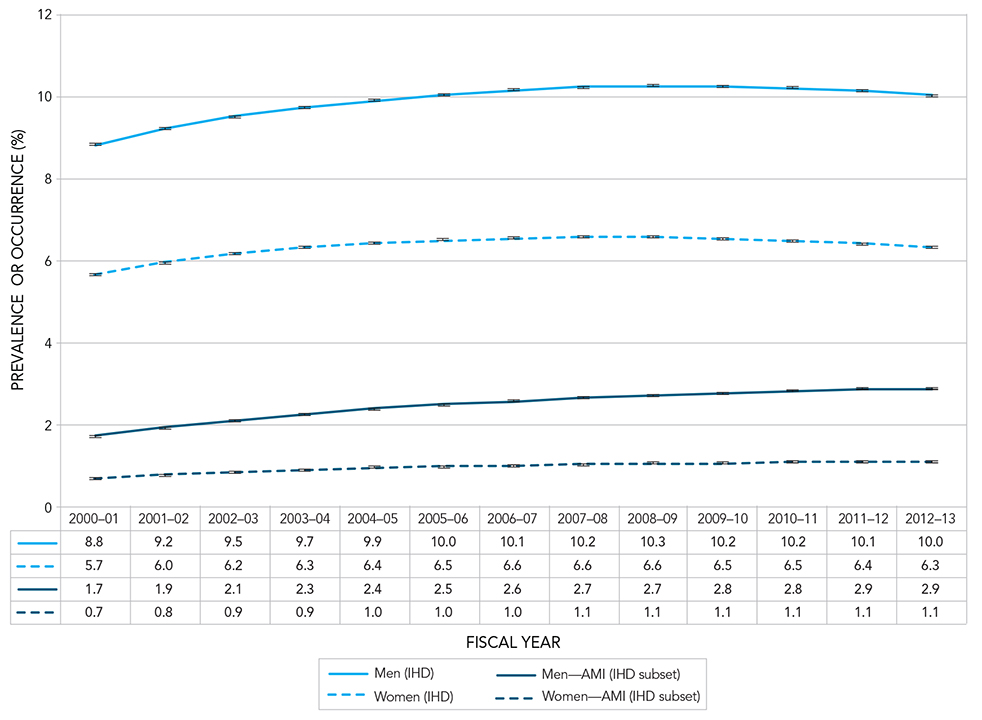
Notes: The 95% confidence interval shows an estimated range of values which is likely to include the true value 19 times out of 20.
Source: Public Health Agency of Canada, using Canadian Chronic Disease Surveillance System data files contributed by provinces and territories, May 2016.
- Figure 5A footnote 1
-
Age-standardized to the 2011 Canadian population.
- Figure 5A footnote 2
-
Data from Yukon were not available.
Figure 5A. Text description follows.
| Fiscal Year | Men (IHD) | 95% Confidence Interval | Women (IHD) | 95% Confidence Interval | Men–AMI (IHD subset) | 95% Confidence Interval | Women–AMI (IHD subset) | 95% Confidence Interval |
|---|---|---|---|---|---|---|---|---|
| 2000-2001 | 8.8% | 8.8-8.9 | 5.7% | 5.6-5.7 | 1.7% | 1.7-1.7 | 0.7% | 0.7-0.7 |
| 2001-2002 | 9.2% | 9.2-9.2 | 6.0% | 5.9-6.0 | 1.9% | 1.9-1.9 | 0.8% | 0.8-0.8 |
| 2002-2003 | 9.5% | 9.5-9.5 | 6.2% | 6.2-6.2 | 2.1% | 2.1-2.1 | 0.9% | 0.9-0.9 |
| 2003-2004 | 9.7% | 9.7-9.7 | 6.3% | 6.3-6.3 | 2.2% | 2.3-2.3 | 0.9% | 0.9-0.9 |
| 2004-2005 | 9.9% | 9.9-9.9 | 6.4% | 6.4-6.5 | 2.4% | 2.4-2.4 | 1.0% | 1.0-1.0 |
| 2005-2006 | 10.0% | 10.0-10.1 | 6.5% | 6.5-6.5 | 2.5% | 2.5-2.5 | 1.0% | 1.0-1.1 |
| 2006-2007 | 10.1% | 10.1-10.2 | 6.6% | 6.5-6.6 | 2.6% | 2.6-2.6 | 1.0% | 1.0-1.2 |
| 2007-2008 | 10.2% | 10.2-10.2 | 6.6% | 6.5-6.6 | 2.7% | 2.7-2.7 | 1.1% | 1.0-1.1 |
| 2008-2009 | 10.3% | 10.2-10.3 | 6.6% | 6.6-6.6 | 2.7% | 2.7-2.8 | 1.1% | 1.1-1.1 |
| 2009-2010 | 10.2% | 10.2-10.3 | 6.5% | 6.5-6.5 | 2.8% | 2.8-2.8 | 1.1% | 1.1-1.1 |
| 2010-2011 | 10.2% | 10.2-10.2 | 6.5% | 6.5-6.5 | 2.8% | 2.8-2.8 | 1.1% | 1.1-1.1 |
| 2011-2012 | 10.1% | 10.1-10.1 | 6.4% | 6.4-6.4 | 2.9% | 2.9-2.9 | 1.1% | 1.1-1.1 |
| 2012-2013 | 10.0% | 10.0-10.0 | 6.3% | 6.3-6.3 | 2.9% | 2.9-2.9 | 1.1% | 1.1-1.1 |
Notes: The 95% confidence interval shows an estimated range of values which is likely to include the true value 19 times out of 20. Source: Public Health Agency of Canada, using Canadian Chronic Disease Surveillance System data files contributed by provinces and territories, May 2016. |
||||||||
Figure 5B. Age-standardizedFigure 5B footnote † prevalence of diagnosed heart failure among Canadians aged 40 years and older, by sex, CanadaFigure 5B footnote *, 2000–2001 to 2012–2013
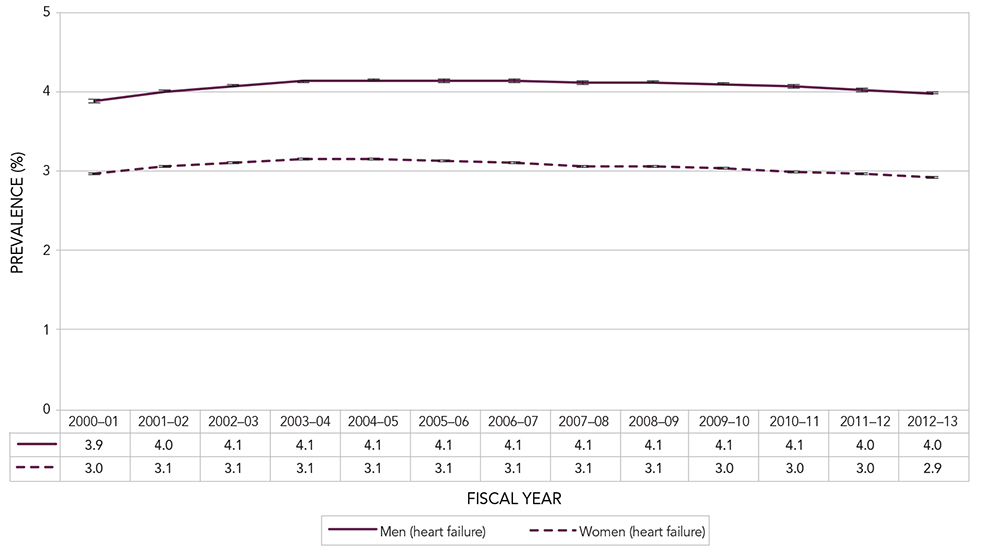
Notes: The 95% confidence interval shows an estimated range of values which is likely to include the true value 19 times out of 20.
Source: Public Health Agency of Canada, using Canadian Chronic Disease Surveillance System data files contributed by provinces and territories, May 2016.
- Figure 5B footnote 1
-
Age-standardized to the 2011 Canadian population.
- Figure 5B footnote 2
-
Data from Yukon were not available.
Figure 5B. Text description follows.
| Fiscal Year | Men (heart failure) | 95% Confidence Interval | Women (heart failure) | 95% Confidence Interval |
|---|---|---|---|---|
| 2000-2001 | 3.9% | 3.9-3.9 | 3.0% | 2.9-3.0 |
| 2001-2002 | 4.0% | 4.0-4.0 | 3.1% | 3.1-3.1 |
| 2002-2003 | 4.1% | 4.1-4.1 | 3.1% | 3.1-3.1 |
| 2003-2004 | 4.1% | 4.1-4.1 | 3.1% | 3.1-3.2 |
| 2004-2005 | 4.1% | 4.1-4.2 | 3.1% | 3.1-3.2 |
| 2005-2006 | 4.1% | 4.1-4.1 | 3.1% | 3.1-3.1 |
| 2006-2007 | 4.1% | 4.1-4.1 | 3.1% | 3.1-3.1 |
| 2007-2008 | 4.1% | 4.1-4.1 | 3.1% | 3.1-3.1 |
| 2008-2009 | 4.1% | 4.1-4.1 | 3.1% | 3.1-3.1 |
| 2009-2010 | 4.1% | 4.1-4.1 | 3.0% | 3.0-3.0 |
| 2010-2011 | 4.1% | 4.0-4.1 | 3.0% | 3.0-3.0 |
| 2011-2012 | 4.0% | 4.0-4.0 | 3.0% | 2.9-3.0 |
| 2012-2013 | 4.0% | 4.0-4.0 | 2.9% | 2.9-2.9 |
Notes: The 95% confidence interval shows an estimated range of values which is likely to include the true value 19 times out of 20. Source: Public Health Agency of Canada, using Canadian Chronic Disease Surveillance System data files contributed by provinces and territories, May 2016. |
||||
Figure 6A. Prevalence of diagnosed ischemic heart disease (IHD) and occurrence of acute myocardial infarction (AMI) among Canadians aged 20 years and older, by age group and sex, CanadaFigure 6A footnote *, 2000–2001 to 2012–2013
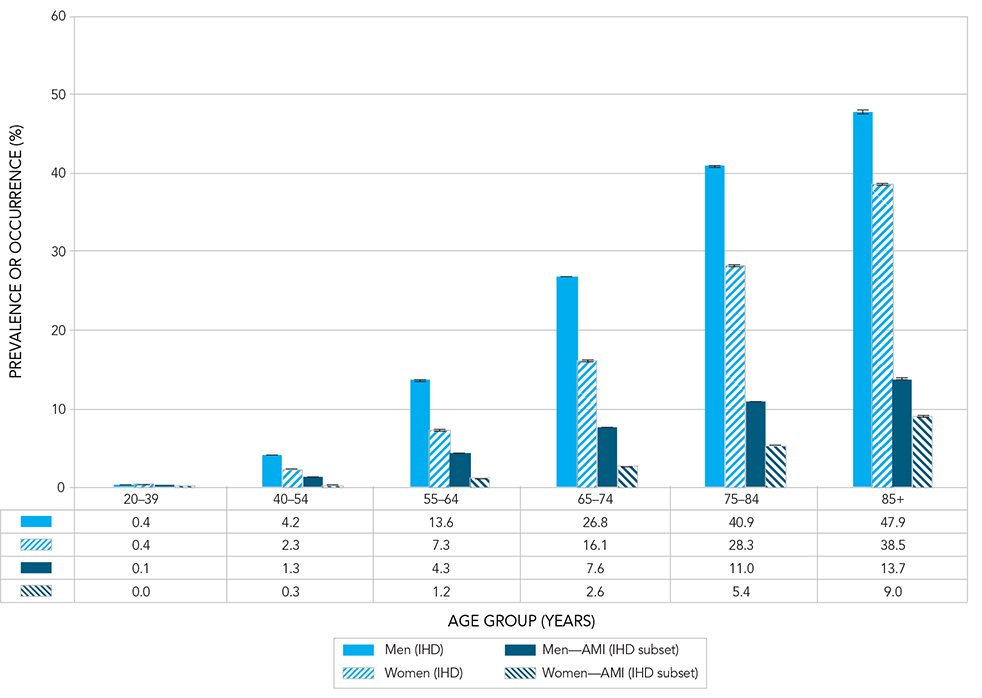
Notes: The 95% confidence interval shows an estimated range of values which is likely to include the true value 19 times out of 20.
Source: Public Health Agency of Canada, using Canadian Chronic Disease Surveillance System data files contributed by provinces and territories, May 2016.
- Figure 6A footnote 1
-
Data from Yukon were not available.
Figure 6A. Text description follows.
| Age Group (Years) | Men (IHD) | 95% Confidence Interval | Women (IHD) | 95% Confidence Interval | Men – AMI (IHD subset) | 95% Confidence Interval | Women – AMI (IHD Subset) | 95% Confidence Interval |
|---|---|---|---|---|---|---|---|---|
| 20–39 | 0.4% | 0.4-0.4 | 0.4% | 0.4-0.4 | 0.1% | 0.1-0.1 | 0.0% | 0.0-0.0 |
| 40-54 | 4.2% | 4.1-4.2 | 2.3% | 2.3-2.3 | 1.3% | 1.2-1.3 | 0.3% | 0.3-0.3 |
| 55-64 | 13.6% | 13.6-13.7 | 7.3% | 7.3-7.4 | 4.3% | 4.3-4.3 | 1.2% | 1.2-1.2 |
| 65-74 | 26.8% | 26.7-26.9 | 16.1% | 16.0-16.1 | 7.6% | 7.6-7.7 | 2.6% | 2.6-2.7 |
| 75-84 | 40.9% | 40.8-41.0 | 28.3% | 28.2-28.4 | 11.0% | 10.9-11.0 | 5.4% | 5.3-5.4 |
| 85+ | 47.9% | 47.6-48.1 | 38.5% | 38.3-38.7 | 13.7% | 13.6-13.9 | 9.0% | 9.0-9.1 |
Notes: The 95% confidence interval shows an estimated range of values which is likely to include the true value 19 times out of 20. Source: Public Health Agency of Canada, using Canadian Chronic Disease Surveillance System data files contributed by provinces and territories, May 2016. |
||||||||
Figure 6B. Prevalence of diagnosed heart failure among Canadians aged 40 years and older, by age group and sex, CanadaFigure 6B footnote *, 2012–2013
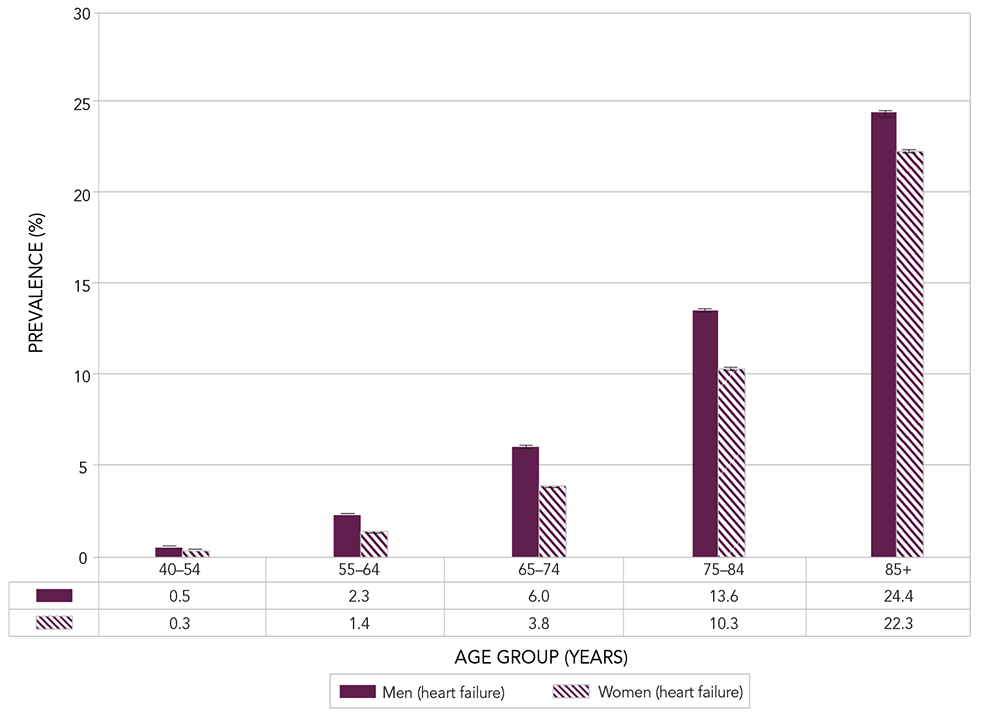
Notes: The 95% confidence interval shows an estimated range of values which is likely to include the true value 19 times out of 20.
Source: Public Health Agency of Canada, using Canadian Chronic Disease Surveillance System data files contributed by provinces and territories, May 2016.
- Figure 6B footnote 1
-
Data from Yukon were not available.
Figure 6B. Text description follows.
| Age Group (Years) | Men (heart failure) | 95% Confidence Interval | Women (heart failure) | 95% Confidence Interval |
|---|---|---|---|---|
| 40-54 | 0.5% | 0.5-0.5 | 0.3% | 0.3-0.3 |
| 55-64 | 2.3% | 2.3-2.3 | 1.4% | 1.3-1.4 |
| 65-74 | 6.0% | 6.0-6.1 | 3.8% | 3.8-3.8 |
| 75-84 | 13.6% | 13.5-13.6 | 10.3% | 10.3-10.4 |
| 85+ | 24.4% | 24.2-24.5 | 22.3% | 22.2-22.4 |
2.2.2 Incidence (new cases)
- Age-standardized incidence rates of IHD and heart failure and occurrence rates of first AMI were higher among men than women across the 13-year period (Figures 7A and 7B). The difference by sex was more pronounced for AMI, with rates about 2.1 times higher, on average, among men than among women.
- IHD and heart failure incidence rates as well as occurrence rates of first AMI increased with age for both women and men (Figures 8A and 8B). Women tend to develop heart disease about 10 years later than men, but the gap between the sexes decreases as they get older.
Figure 7A. Incidence (ratesFigure 7A footnote † of diagnosed ischemic heart disease (IHD) and occurrence (ratesFigure 7A footnote † of first acute myocardial infarction (AMI) among Canadians aged 20 years and older, by sex, CanadaFigure 7A footnote *, 2000–2001 to 2012–2013
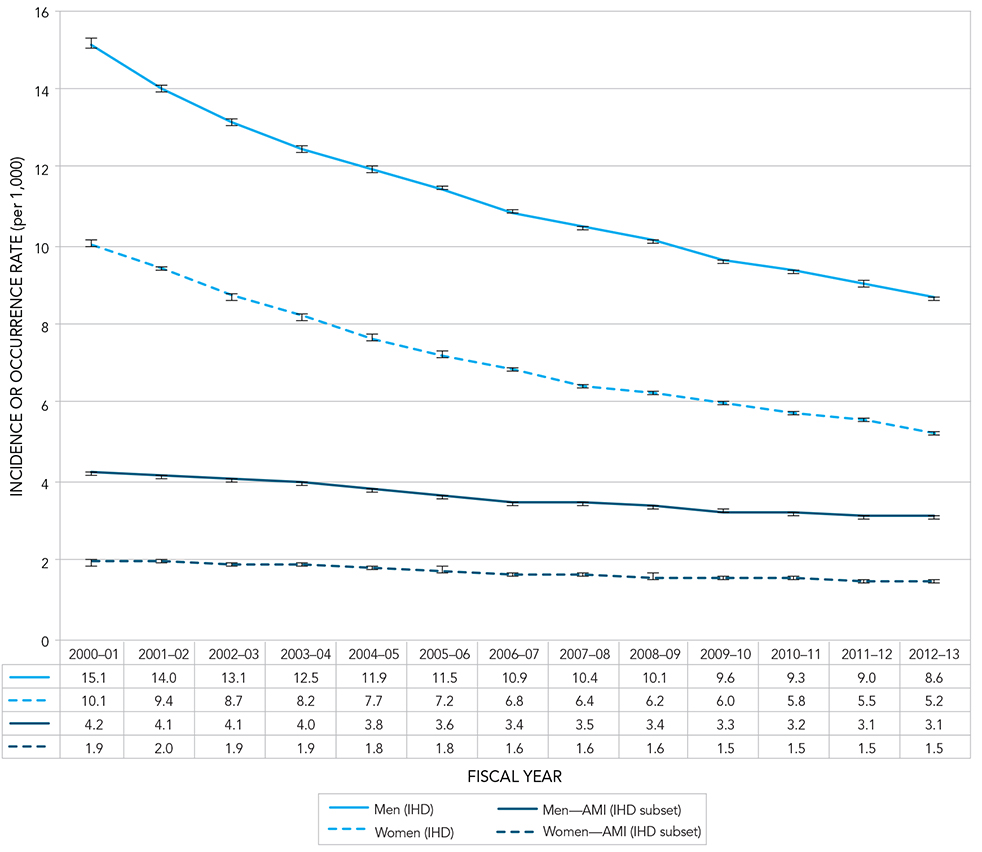
Notes: The 95% confidence interval shows an estimated range of values which is likely to include the true value 19 times out of 20.
Source: Public Health Agency of Canada, using Canadian Chronic Disease Surveillance System data files contributed by provinces and territories, May 2016.
- Figure 7A footnote 1
-
Age-standardized to the 2011 Canadian population.
- Figure 7A footnote 2
-
Data from Yukon were not available.
Figure 7A. Text description follows.
| Fiscal Year | Men (IHD) | 95% Confidence Interval | Women (IHD) | 95% Confidence Interval | Men – AMI (IHD subset) | 95% Confidence Interval | Women – AMI (IHD subset) | 95% Confidence Interval |
|---|---|---|---|---|---|---|---|---|
| 2000-2001 | 15.1 per 1,000 people | 15.1-15.2 | 10.1 per 1,000 people | 10.0-10.1 | 4.2 per 1,000 people | 4.2-4.3 | 1.9 per 1,000 people | 1.9-2.0 |
| 2001-2002 | 14.0 per 1,000 people | 13.9-14.1 | 9.4 per 1,000 people | 9.4-9.5 | 4.1 per 1,000 people | 4.1-4.2 | 2.0 per 1,000 people | 1.9-2.0 |
| 2002-2003 | 13.1 per 1,000 people | 13.1-13.2 | 8.7 per 1,000 people | 8.6-8.7 | 4.1 per 1,000 people | 4.0-4.1 | 1.9 per 1,000 people | 1.9-1.9 |
| 2003-2004 | 12.5 per 1,000 people | 12.4-12.5 | 8.2 per 1,000 people | 8.1-8.2 | 4.0 per 1,000 people | 4.0-4.0 | 1.9 per 1,000 people | 1.9-1.9 |
| 2004-2005 | 11.9 per 1,000 people | 11.9-12.0 | 7.7 per 1,000 people | 7.6-7.7 | 3.8 per 1,000 people | 3.8-3.9 | 1.8 per 1,000 people | 1.8-1.8 |
| 2005-2006 | 11.5 per 1,000 people | 11.4-11.5 | 7.2 per 1,000 people | 7.2-7.3 | 3.6 per 1,000 people | 3.6-3.7 | 1.8 per 1,000 people | 1.7-1.8 |
| 2006-2007 | 10.9 per 1,000 people | 10.8-10.9 | 6.8 per 1,000 people | 6.8-6.9 | 3.4 per 1,000 people | 3.4-3.5 | 1.6 per 1,000 people | 1.6-1.7 |
| 2007-2008 | 10.4 per 1,000 people | 10.4-10.5 | 6.4 per 1,000 people | 6.4-6.5 | 3.5 per 1,000 people | 3.4-3.5 | 1.6 per 1,000 people | 1.6-1.6 |
| 2008-2009 | 10.1 per 1,000 people | 10.0-10.2 | 6.2 per 1,000 people | 6.2-6.3 | 3.4 per 1,000 people | 3.3-3.4 | 1.6 per 1,000 people | 1.5-1.5 |
| 2009-2010 | 9.6 per 1,000 people | 9.5-9.7 | 6.0 per 1,000 people | 6.0-6.1 | 3.3 per 1,000 people | 3.2-3.3 | 1.5 per 1,000 people | 1.5-1.5 |
| 2010-2011 | 9.3 per 1,000 people | 9.3-9.4 | 5.8 per 1,000 people | 5.7-5.8 | 3.2 per 1,000 people | 3.2-3.2 | 1.5 per 1,000 people | 1.5-1.5 |
| 2011-2012 | 9.0 per 1,000 people | 9.0-9.1 | 5.5 per 1,000 people | 5.5-5.6 | 3.1 per 1,000 people | 3.1-3.1 | 1.5 per 1,000 people | 1.5-1.5 |
| 2012-2013 | 8.6 per 1,000 people | 8.6-8.7 | 5.2 per 1,000 people | 5.2-5.3 | 3.1 per 1,000 people | 3.1-3.1 | 1.5 per 1,000 people | 1.5-1.5 |
Notes: The 95% confidence interval shows an estimated range of values which is likely to include the true value 19 times out of 20. Source: Public Health Agency of Canada, using Canadian Chronic Disease Surveillance System data files contributed by provinces and territories, May 2016. |
||||||||
Figure 7B. Age-standardizedFigure 7B footnote † incidence rates of diagnosed heart failure among Canadians aged 40 years and older, by sex, CanadaFigure 7B footnote *, 2000–2001 to 2012–2013
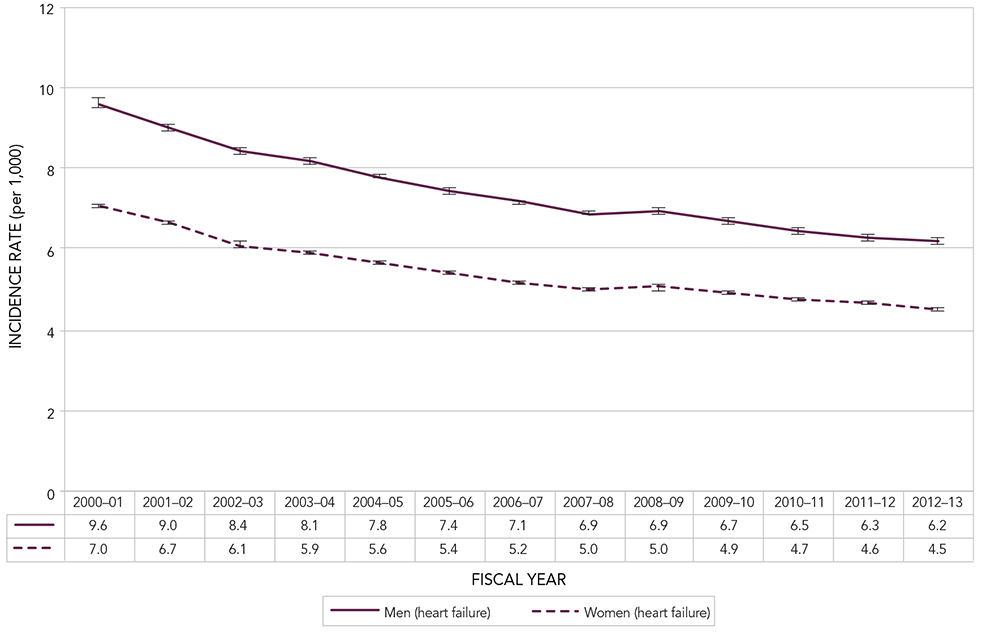
Notes: The 95% confidence interval shows an estimated range of values which is likely to include the true value 19 times out of 20.
Source: Public Health Agency of Canada, using Canadian Chronic Disease Surveillance System data files contributed by provinces and territories, May 2016.
- Figure 7B footnote 1
-
Age-standardized to the 2011 Canadian population.
- Figure 7B footnote 2
-
Data from Yukon were not available.
Figure 7B. Text description follows.
| Fiscal Year | Men (heart failure) | 95% Confidence Interval | Women (heart failure) | 95% Confidence Interval |
|---|---|---|---|---|
| 2000-2001 | 9.6 per 1,000 people | 9.5-9.7 | 7.0 per 1,000 people | 7.0-7.1 |
| 2001-2002 | 9.0 per 1,000 people | 8.9-9.1 | 6.7 per 1,000 people | 6.6-6.7 |
| 2002-2003 | 8.4 per 1,000 people | 8.3-8.5 | 6.1 per 1,000 people | 6.0-6.2 |
| 2003-2004 | 8.1 per 1,000 people | 8.1-8.2 | 5.9 per 1,000 people | 5.8-5.9 |
| 2004-2005 | 7.8 per 1,000 people | 7.7-7.9 | 5.6 per 1,000 people | 5.6-5.7 |
| 2005-2006 | 7.4 per 1,000 people | 7.3-7.5 | 5.4 per 1,000 people | 5.4-5.5 |
| 2006-2007 | 7.1 per 1,000 people | 7.1-7.2 | 5.2 per 1,000 people | 5.1-5.2 |
| 2007-2008 | 6.9 per 1,000 people | 6.8-7.0 | 5.0 per 1,000 people | 4.9-5.0 |
| 2008-2009 | 6.9 per 1,000 people | 6.9-7.0 | 5.0 per 1,000 people | 5.0-5.1 |
| 2009-2010 | 6.7 per 1,000 people | 6.6-6.8 | 4.9 per 1,000 people | 4.9-4.9 |
| 2010-2011 | 6.5 per 1,000 people | 6.4-6.5 | 4.7 per 1,000 people | 4.7-4.8 |
| 2011-2012 | 6.3 per 1,000 people | 6.2-6.3 | 4.6 per 1,000 people | 4.6-4.7 |
| 2012-2013 | 6.2 per 1,000 people | 6.1-6.3 | 4.5 per 1,000 people | 4.4-4.5 |
Notes: The 95% confidence interval shows an estimated range of values which is likely to include the true value 19 times out of 20. Source: Public Health Agency of Canada, using Canadian Chronic Disease Surveillance System data files contributed by provinces and territories, May 2016. |
||||
Figure 8A. Incidence rates of diagnosed ischemic heart disease (IHD) and occurrence rates of first acute myocardial infarction (AMI) among Canadians aged 20 years and older, by age group and sex, CanadaFigure 8A footnote *, 2012–2013
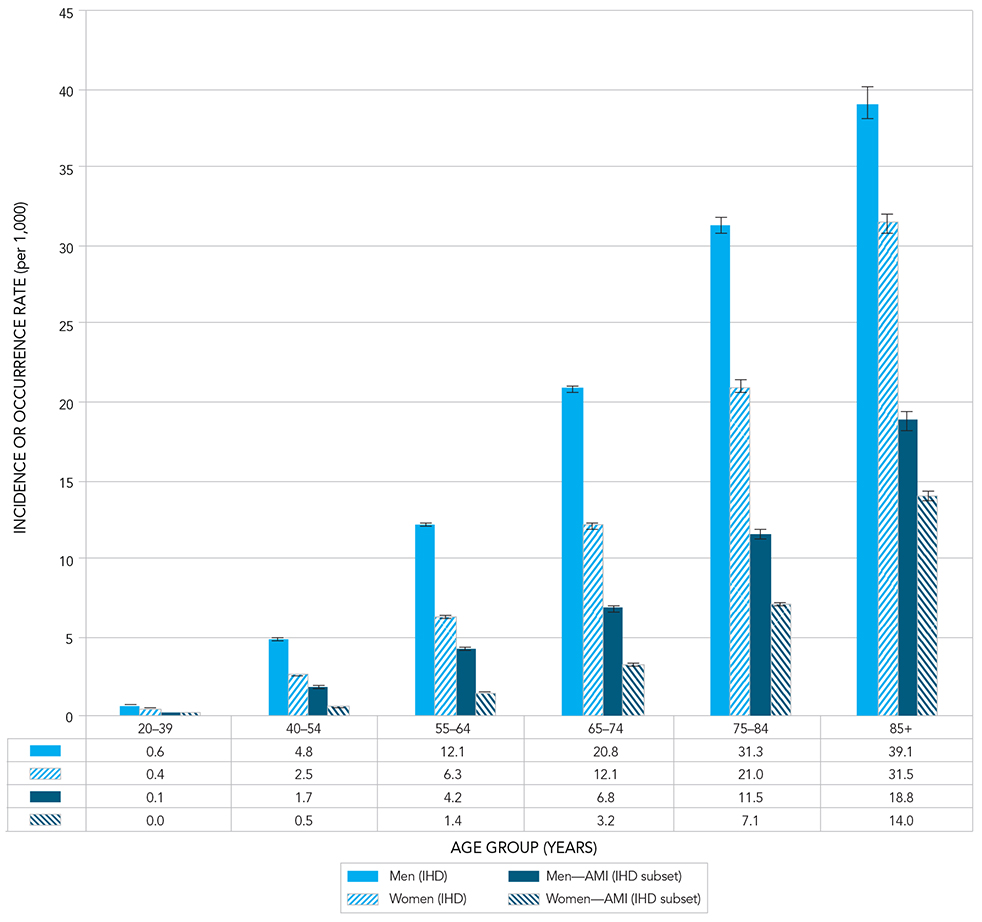
Notes: The 95% confidence interval shows an estimated range of values which is likely to include the true value 19 times out of 20.
Source: Public Health Agency of Canada, using Canadian Chronic Disease Surveillance System data files contributed by provinces and territories, May 2016.
- Figure 8A footnote 1
-
Data from Yukon were not available.
Figure 8A. Text description follows.
| Age Group (Years) | Men (IHD) | 95% Confidence Interval | Women (IHD) | 95% Confidence Interval | Men – AMI (IHD subset) | 95% Confidence Interval | Women – AMI (IHD subset) | 95% Confidence Interval |
|---|---|---|---|---|---|---|---|---|
| 20–39 | 0.6 per1,000 | 0.6-0.7 | 0.4 per 1,000 people | 0.4-0.4 | 0.1 per 1,000 people | 0.1-0.1 | 0.0 per 1,000 people | 0.0-0.0 |
| 40-54 | 4.8 per 1,000 people | 4.8-4.9 | 2.5 per 1,000 people | 2.5-2.6 | 1.7 per 1,000 people | 1.7-1.8 | 0.5 per 1,000 people | 0.5-0.5 |
| 55-64 | 12.1 per 1,000 people | 12.0-12.3 | 6.3 per 1,000 people | 6.2-6.4 | 4.2 per 1,000 people | 4.1-4.3 | 1.4 per 1,000 people | 1.4-1.5 |
| 65-74 | 20.8 per 1,000 people | 20.6-21.1 | 12.1 per 1,000 people | 11.9-12.3 | 6.8 per 1,000 people | 6.6-6.9 | 3.2 per 1,000 people | 3.1-3.3 |
| 75-84 | 31.3 per 1,000 people | 30.8-31.8 | 21.0 per 1,000 people | 20.6-21.3 | 11.5 per 1,000 people | 11.3-11.8 | 7.1 per 1,000 people | 6.9-7.3 |
| 85+ | 39.1 per 1,000 people | 38.1-40.1 | 31.5 per 1,000 people | 30.9-32.0 | 18.8 per 1,000 people | 18.2-19.3 | 14.0 per 1,000 people | 13.7-14.3 |
Notes: The 95% confidence interval shows an estimated range of values which is likely to include the true value 19 times out of 20. Source: Public Health Agency of Canada, using Canadian Chronic Disease Surveillance System data files contributed by provinces and territories, May 2016. |
||||||||
Figure 8B. Incidence rates of diagnosed heart failure among Canadians aged 40 years and older, by age group and sex, CanadaFigure 8B footnote *, 2012–2013
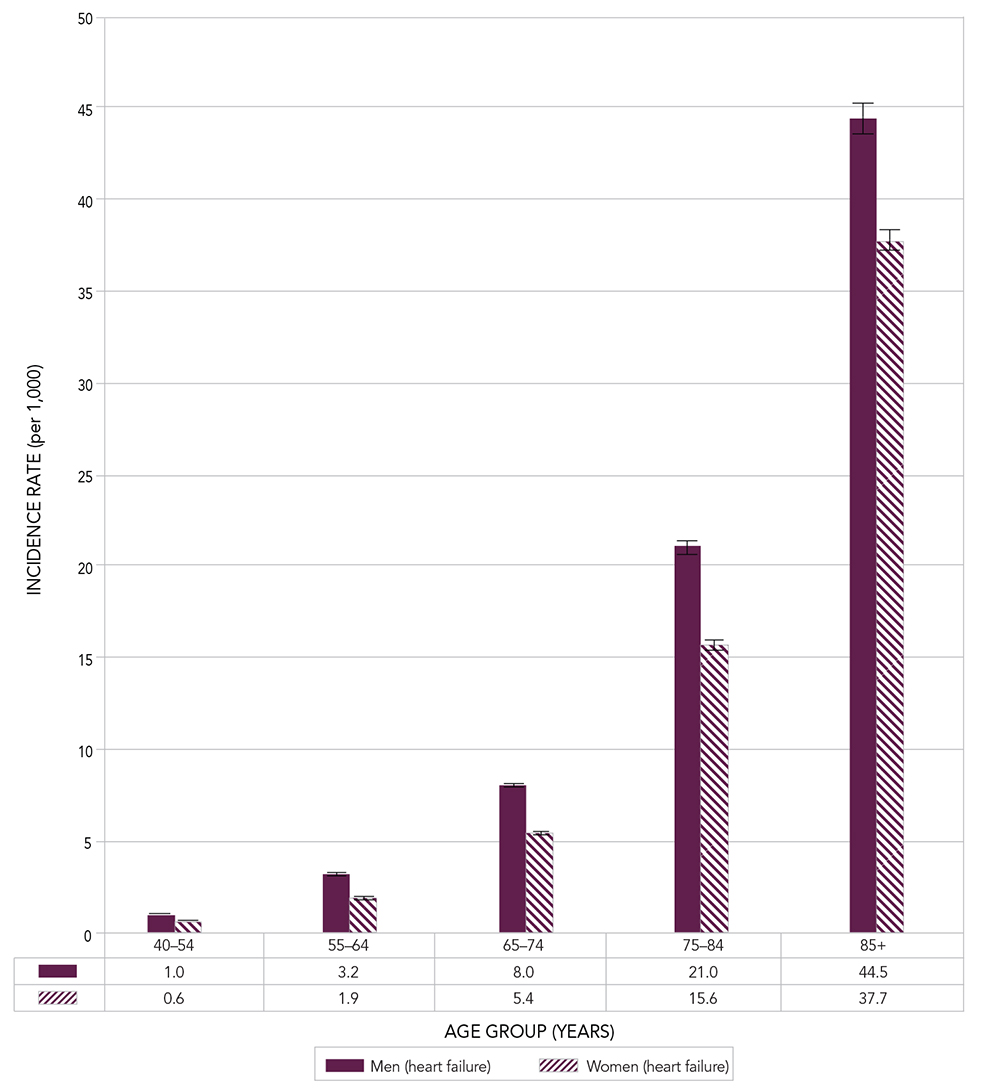
Notes: The 95% confidence interval shows an estimated range of values which is likely to include the true value 19 times out of 20.
Source: Public Health Agency of Canada, using Canadian Chronic Disease Surveillance System data files contributed by provinces and territories, May 2016.
- Figure 8B footnote 1
-
Data from Yukon were not available.
Figure 8B. Text description follows.
| Age Group (Years) | Men (IHD) | 95% Confidence Interval | Women (IHD) | 95% Confidence Interval |
|---|---|---|---|---|
| 40-54 | 1.0 per 1,000 people | 1.0-1.0 | 0.6 per 1,000 people | 0.6-0.6 |
| 55-64 | 3.2 per 1,000 people | 3.2-3.3 | 1.9 per 1,000 people | 1.8-1.9 |
| 65-74 | 8.0 per 1,000 people | 7.9-8.2 | 5.4 per 1,000 people | 5.3-5.5 |
| 75-84 | 21.0 per 1,000 people | 20.7-21.4 | 15.6 per 1,000 people | 15.4-15.9 |
| 85+ | 44.5 per 1,000 people | 43.6-45.3 | 37.7 per 1,000 people | 37.2-38.3 |
Notes: The 95% confidence interval shows an estimated range of values which is likely to include the true value 19 times out of 20. Source: Public Health Agency of Canada, using Canadian Chronic Disease Surveillance System data files contributed by provinces and territories, May 2016. |
||||
2.2.3 All-Cause Mortality Rates
- Overall, age-standardized all-cause mortality rates among those with diagnosed IHD were slightly higher among men than women from 2000–2001 to 2012–2013 (Figure 9A). Relative declines of 22.3% and 25.9% were seen for women and men, respectively, over the 13-year period.
- For those with a prior history of AMI, all-cause mortality rates were higher in women than men in any given year. The age-standardized rate per 1,000 fell from 51.3 to 31.7 among women and from 40.2 to 26.3 among men between 2000–2001 and 2012–2013, with relative decreases of 38.2% and 34.7%, respectively (Figure 9A).
- As for heart failure, women and men had similar age-standardized all-cause mortality rates over time, as indicated by overlapping confidence intervals (Figure 9B). Rates fell for both women and men over time, with relative decreases of 24.2% and 28.2%, respectively.
Figure 9A. Age-standardizedFigure 9A footnote † all-cause mortality rates among Canadians aged 20 years and older with diagnosed ischemic heart disease (IHD) and acute myocardial infarction (AMI), by sex, CanadaFigure 9A footnote *, 2000–2001 to 2012–2013
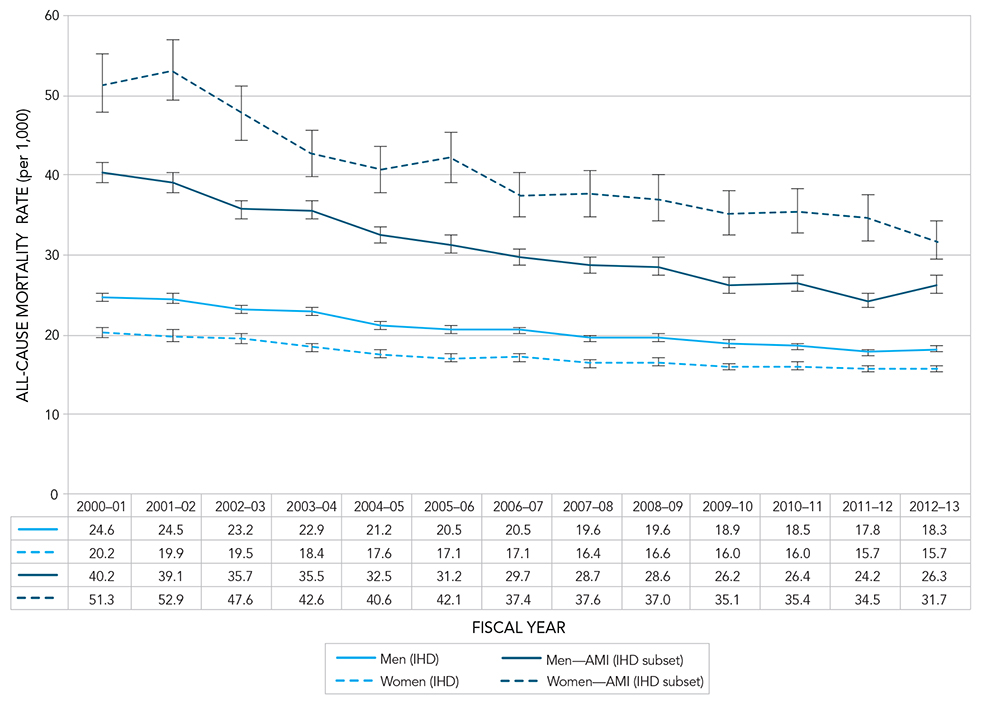
Notes: The 95% confidence interval shows an estimated range of values which is likely to include the true value 19 times out of 20.
Source: Public Health Agency of Canada, using Canadian Chronic Disease Surveillance System data files contributed by provinces and territories, May 2016.
- Figure 9A footnote 1
-
Age-standardized to the 2011 Canadian population.
- Figure 9A footnote 2
-
Data from Yukon were not available.
Figure 9A. Text description follows.
| Fiscal Year | Men (IHD) | 95% Confidence Interval | Women (IHD) | 95% Confidence Interval | Men – AMI (IHD subset) | 95% Confidence Interval | Women – AMI (IHD subset) | 95% Confidence Interval |
|---|---|---|---|---|---|---|---|---|
| 2000-2001 | 24.6 per 1,000 people | 24.1-25.2 | 20.2 per 1,000 people | 19.6-21.0 | 40.2 per 1,000 people | 39.0-41.6 | 51.3 per 1,000 people | 47.9-55.1 |
| 2001-2002 | 24.5 per 1,000 people | 24.0-25.1 | 19.9 per 1,000 people | 19.2-20.6 | 39.1 per 1,000 people | 37.9-40.4 | 52.2 per 1,000 people | 49.3-56.9 |
| 2002-2003 | 23.2 per 1,000 people | 22.7-23.8 | 19.5 per 1,000 people | 18.9-20.1 | 35.7 per 1,000 people | 34.6-36.8 | 47.6 per 1,000 people | 44.4-51.2 |
| 2003-2004 | 22.9 per 1,000 people | 22.4-23.4 | 18.4 per 1,000 people | 17.9-19.0 | 35.5 per 1,000 people | 34.4-36.7 | 42.6 per 1,000 people | 39.9-45.6 |
| 2004-2005 | 21.2 per 1,000 people | 20.7-21.6 | 17.6 per 1,000 people | 17.1-18.1 | 32.5 per 1,000 people | 31.5-33.6 | 40.6 per 1,000 people | 37.9-43.6 |
| 2005-2006 | 20.5 per 1,000 people | 20.1-21.0 | 17.1 per 1,000 people | 16.6-17.6 | 31.2 per 1,000 people | 30.1-32.4 | 42.1 per 1,000 people | 39.1-45.4 |
| 2006-2007 | 20.5 per 1,000 people | 20.1-21.0 | 17.1 per 1,000 people | 16.6-17.6 | 29.7 per 1,000 people | 28.7-30.8 | 37.4 per 1,000 people | 34.9-40.2 |
| 2007-2008 | 19.6 per 1,000 people | 19.1-20.0 | 16.4 per 1,000 people | 16.0-16.9 | 28.7 per 1,000 people | 27.7-29.8 | 37.6 per 1,000 people | 34.8-40.6 |
| 2008-2009 | 19.6 per 1,000 people | 19.1-20.1 | 16.6 per 1,000 people | 16.1-17.1 | 28.6 per 1,000 people | 27.5-29.7 | 37.0 per 1,000 people | 34.2-40.0 |
| 2009-2010 | 18.9 per 1,000 people | 18.4-19.3 | 16.0 per 1,000 people | 15.5-16.4 | 26.2 per 1,000 people | 25.3-27.2 | 35.1 per 1,000 people | 32.5-38.1 |
| 2010-2011 | 18.5 per 1,000 people | 18.1-19.0 | 16.0 per 1,000 people | 15.6-16.5 | 26.4 per 1,000 people | 25.4-27.4 | 35.4 per 1,000 people | 32.8-38.3 |
| 2011-2012 | 17.8 per 1,000 people | 17.4-18.2 | 15.7 per 1,000 people | 15.3-16.2 | 24.2 per 1,000 people | 23.3-25.1 | 34.5 per 1,000 people | 31.8-37.6 |
| 2012-2013 | 18.3 per 1,000 people | 17.8-18.7 | 15.7 per 1,000 people | 15.3-16.2 | 26.3 per 1,000 people | 25.2-27.4 | 31.7 per 1,000 people | 29.4-34.3 |
Notes: The 95% confidence interval shows an estimated range of values which is likely to include the true value 19 times out of 20. Source: Public Health Agency of Canada, using Canadian Chronic Disease Surveillance System data files contributed by provinces and territories, May 2016. |
||||||||
Figure 9B. Age-standardizedFigure 9B footnote † all-cause mortality rates among Canadians aged 40 years and older with diagnosed heart failure, by sex, CanadaFigure 9B footnote *, 2000–2001 to 2012–2013
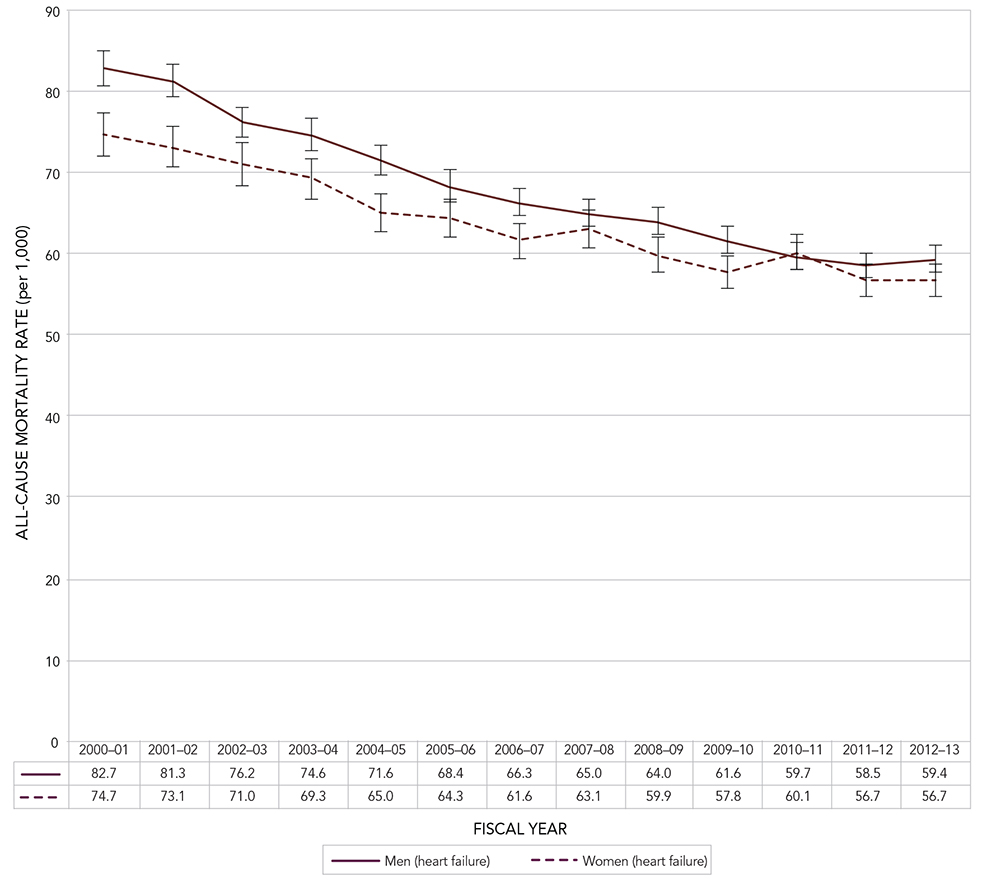
Notes: The 95% confidence interval shows an estimated range of values which is likely to include the true value 19 times out of 20.
Source: Public Health Agency of Canada, using Canadian Chronic Disease Surveillance System data files contributed by provinces and territories, May 2016.
- Figure 9B footnote 1
-
Age-standardized to the 2011 Canadian population.
- Figure 9B footnote 2
-
Data from Yukon were not available.
Figure 9B. Text description follows.
| Fiscal Year | Men (heart failure) | 95% Confidence Interval | Women (heart failure) | 95% Confidence Interval |
|---|---|---|---|---|
| 2000-2001 | 82.7 per 1,000 people | 80.7-84.9 | 74.7 per 1,000 people | 72.2-77.5 |
| 2001-2002 | 81.3 per 1,000 people | 79.3-83.5 | 73.1 per 1,000 people | 70.6-75.8 |
| 2002-2003 | 76.2 per 1,000 people | 74.2-78.2 | 71.0 per 1,000 people | 68.5-73.7 |
| 2003-2004 | 74.6 per 1,000 people | 72.8-76.6 | 69.3 per 1,000 people | 66.9-71.9 |
| 2004-2005 | 71.6 per 1,000 people | 69.8-73.5 | 65.0 per 1,000 people | 62.7-67.4 |
| 2005-2006 | 68.4 per 1,000 people | 66.6-70.3 | 64.3 per 1,000 people | 62.0-66.7 |
| 2006-2007 | 66.3 per 1,000 people | 64.7-68.1 | 61.6 per 1,000 people | 59.5-63.8 |
| 2007-2008 | 65.0 per 1,000 people | 63.3-66.8 | 63.1 per 1,000 people | 60.8-65.5 |
| 2008-2009 | 64.0 per 1,000 people | 62.4-65.8 | 59.9 per 1,000 people | 57.8-62.0 |
| 2009-2010 | 61.6 per 1,000 people | 60.0-63.4 | 57.8 per 1,000 people | 55.8-59.8 |
| 2010-2011 | 59.7 per 1,000 people | 58.2-61.4 | 60.1 per 1,000 people | 58.0-62.3 |
| 2011-2012 | 58.5 per 1,000 people | 57.0-60.1 | 56.7 per 1,000 people | 54.8-58.7 |
| 2012-2013 | 59.4 per 1,000 people | 57.8-61.1 | 56.7 per 1,000 people | 54.8-58.7 |
Notes: The 95% confidence interval shows an estimated range of values which is likely to include the true value 19 times out of 20. Source: Public Health Agency of Canada, using Canadian Chronic Disease Surveillance System data files contributed by provinces and territories, May 2016. |
||||
- Overall in 2012–2013, men with diagnosed IHD were, on average, 1.2 times more likely to die of any cause than women with diagnosed IHD (Figure 10A) during the year. Younger women and men, aged 20 to 39 years, with diagnosed IHD were about 17.6 and 10.9 times more likely to die, respectively, than those without the disease (Figure 10A). As age increased, mortality rate ratios decreased considerably; it was down to 1.7 for both women and men aged 85 years and older.
- Overall, in 2012–2013, women with a prior AMI were, on average, 1.3 times more likely to die of any cause compared with men who had a prior AMI. Higher mortality rates observed among women aged 45 to 74 years old drive this difference (Figure 10B).
- In 2012–2013, women aged 20 to 44 years with a prior AMI were about 27.6 times more likely to die of any cause compared to those without. This result should be interpreted with caution however since the confidence interval is wide in this age group. Men of the same age with a prior AMI were about 15.6 times more likely to die of any cause than men without in 2012–2013. As age increased, mortality rate ratios decreased to the point that both women and men had similar rate ratios (Figure 10B).
- In 2011–2012, all-cause mortality rates 365 days following a hospitalization with a recorded history of AMI were higher in women than in men aged 20 to 74 years old. Rates ranged respectively from 60.0 to 194.7 per 1,000 and from 20.9 to 175.0 per 1,000. Starting at age 75, men had higher rates than women (Figure 10C).
- Starting at age 65, all-cause mortality rates were higher among men with diagnosed heart failure than among women of the same age with the disease in 2012–2013 (Figure 10D).
- In 2012–2013, women and men aged 40 to 54 years old with diagnosed heart failure were 27.3 and 16.5 times more likely to die of any cause during the year, respectively, than those without the disease. As age increased, mortality rate ratios decreased down to 2.6 for both women and men aged 85 years and older (Figure 10D).
Figure 10A. All-cause mortality rates and rate ratios among Canadians aged 20 years and older with diagnosed ischemic heart disease (IHD) compared to those without, by age group and sex, CanadaFigure 10A footnote *, 2000–2001 to 2012–2013
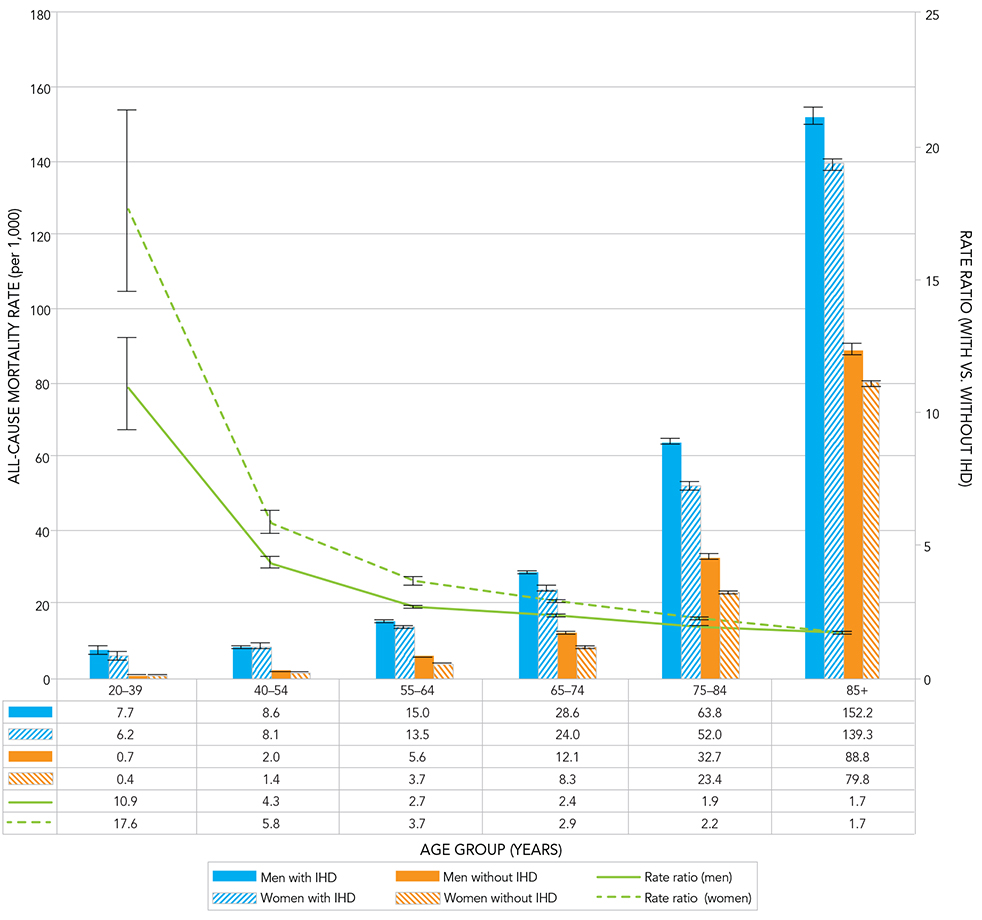
Notes: The 95% confidence interval shows an estimated range of values which is likely to include the true value 19 times out of 20.
Source: Public Health Agency of Canada, using Canadian Chronic Disease Surveillance System data files contributed by provinces and territories, May 2016.
- Figure 10A footnote 1
-
Data from Yukon were not available.
Figure 10A. Text description follows.
| Age group | Men with IHD | 95% Confidence Interval | Women with IHD | 95% Confidence Interval | Men without IHD | 95% Confidence Interval | Women without IHD | 95% Confidence Interval | Rate ratio (men) | 95% Confidence Interval | Rate ratio (women) | 95% Confidence Interval |
|---|---|---|---|---|---|---|---|---|---|---|---|---|
| 20–39 | 7.7 per 1,000 people | 6.6-9.0 | 6.2 per 1,000 people | 5.1-7.5 | 0.7 per 1,000 people | 0.7-0.7 | 0.4 per 1,000 people | 0.3-0.4 | 10.9 | 9.3 - 12.8 | 17.6 | 14.5 - 21.3 |
| 40-54 | 8.6 per 1,000 people | 8.2-9.1 | 8.1 per 1,000 people | 7.5-8.7 | 2.0 per 1,000 people | 1.9-2.0 | 1.4 per 1,000 people | 1.4-1.4 | 4.3 | 4.1 - 4.6 | 5.8 | 5.4 - 6.3 |
| 55-64 | 15.0 per 1,000 people | 14.6-15.4 | 13.5 per 1,000 people | 13.0-14.1 | 5.6 per 1,000 people | 5.5-5.7 | 3.7 per 1,000 people | 3.6-3.8 | 2.7 | 2.6 - 2.8 | 3.7 | 3.5 - 3.8 |
| 65-74 | 28.6 per 1,000 people | 28.1-29.1 | 24.0 per 1,000 people | 23.4-24.6 | 12.1 per 1,000 people | 11.8-12.3 | 8.3 per 1,000 people | 8.2-8.5 | 2.4 | 2.3 - 2.4 | 2.9 | 2.8 - 3.0 |
| 75-84 | 63.8 per 1,000 people | 62.9-64.7 | 52.0 per 1,000 people | 51.2-52.9 | 32.7 per 1,000 people | 32.2-33.3 | 23.4 per 1,000 people | 23.0-23.8 | 1.9 | 1.9 - 2.0 | 2.2 | 2.2 - 2.3 |
| 85+ | 152.2 per 1,000 people | 150.1-154.2 | 139.3 per 1,000 people | 137.8-140.9 | 88.8 per 1,000 people | 87.3-90.3 | 79.8 per 1,000 people | 78.9-80.8 | 1.7 | 1.7 - 1.8 | 1.7 | 1.7 - 1.8 |
Notes: The 95% confidence interval shows an estimated range of values which is likely to include the true value 19 times out of 20. Source: Public Health Agency of Canada, using Canadian Chronic Disease Surveillance System data files contributed by provinces and territories, May 2016. |
||||||||||||
Figure 10B. All-cause mortality rates and rate ratios among Canadians aged 20 years and older who had an acute myocardial infarction (AMI) compared to those without, by age group and sex, CanadaFigure 10B footnote *, 2012–2013
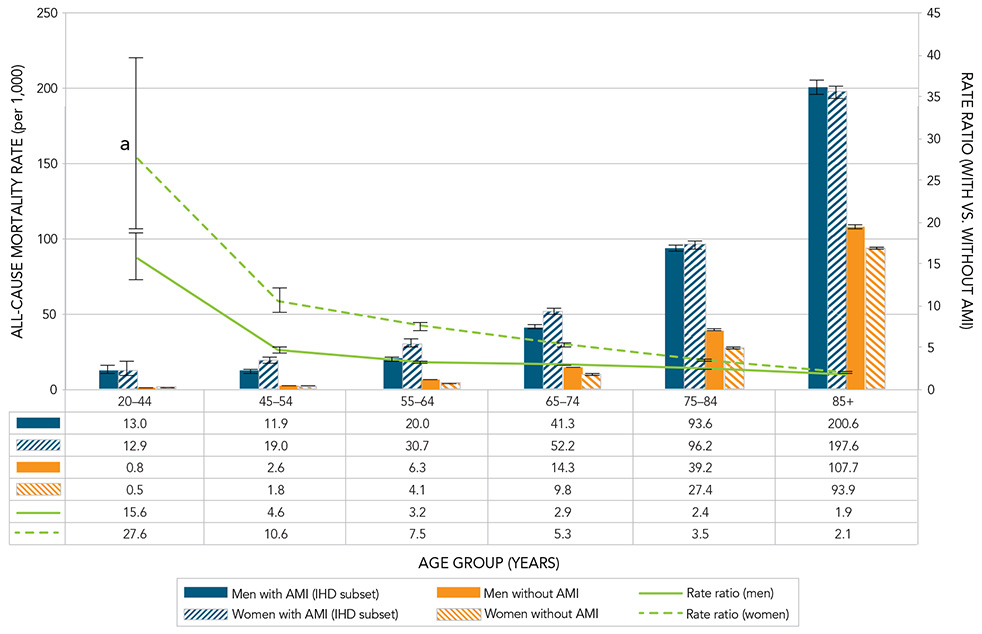
Notes: The 95% confidence interval shows an estimated range of values which is likely to include the true value 19 times out of 20.
Source: Public Health Agency of Canada, using Canadian Chronic Disease Surveillance System data files contributed by provinces and territories, May 2016.
- Figure 10B footnote 1
-
Data from Yukon were not available.
- Figure 10B footnote 2
-
Interpret with caution, coefficient of variation between 16.6% and 33.3%.
Figure 10B. Text description follows.
| Age group | Men with AMI (IHD subset) | 95% Confidence Interval | Women with AMI (IHD subset) | 95% Confidence Interval | Men without AMI | 95% Confidence Interval | Women without AMI | 95% Confidence Interval | Rate ratio (men) | 95% Confidence Interval | Rate ratio (women) | 95% Confidence Interval |
|---|---|---|---|---|---|---|---|---|---|---|---|---|
| 20-44 | 13.0 per 1,000 people | 10.8-15.6 | 12.9 per 1,000 people | 8.7-18.5 | 0.8 per 1,000 people | 0.8-0.9 | 0.5 per 1,000 people | 0.5-0.5 | 15.6 | 13.0-18.7 | 27.6Long description 10B footnote a | 19.3-39.6 |
| 45-54 | 11.9 per 1,000 people | 10.9-13.0 | 19.0 per 1,000 people | 16.6-21.7 | 2.6 per 1,000 people | 2.5-2.6 | 1.8 per 1,000 people | 1.7-1.8 | 4.6 | 4.3-5.1 | 10.6 | 9.3-12.2 |
| 55-64 | 20.0 per 1,000 people | 19.2-20.9 | 30.7 per 1,000 people | 28.7-32.9 | 6.3 per 1,000 people | 6.2-6.4 | 4.1 per 1,000 people | 4.0-4.2 | 3.2 | 3.0-3.3 | 7.5 | 7.0-8.0 |
| 65-74 | 41.3 per 1,000 people | 40.1-42.5 | 52.2 per 1,000 people | 50.0-54.4 | 14.3 per 1,000 people | 14.1-14.5 | 9.8 per 1,000 people | 9.6-9.9 | 2.9 | 2.8-3.0 | 5.3 | 5.1-5.6 |
| 75-84 | 93.6 per 1,000 people | 91.6-95.7 | 96.2 per 1,000 people | 93.5-98.9 | 39.2 per 1,000 people | 38.7-39.7 | 27.4 per 1,000 people | 27.1-27.8 | 2.4 | 2.3-2.4 | 3.5 | 3.4-3.6 |
| 85+ | 200.6 per 1,000 people | 196.2-205.0 | 197.6 per 1,000 people | 193.7-201.5 | 107.7 per 1,000 people | 106.4-109.0 | 93.9 per 1,000 people | 93.1-94.8 | 1.9 | 1.8-1.9 | 2.1 | 2.1-2.2 |
Notes: The 95% confidence interval shows an estimated range of values which is likely to include the true value 19 times out of 20. Source: Public Health Agency of Canada, using Canadian Chronic Disease Surveillance System data files contributed by provinces and territories, May 2016. |
||||||||||||
Figure 10C. All-cause mortality rates within 365 days of a hospital admission with a recorded history of acute myocardial infarction (AMI), among Canadians aged 20 years and older, by age group and sex, CanadaFigure 10C footnote *, 2011–2012
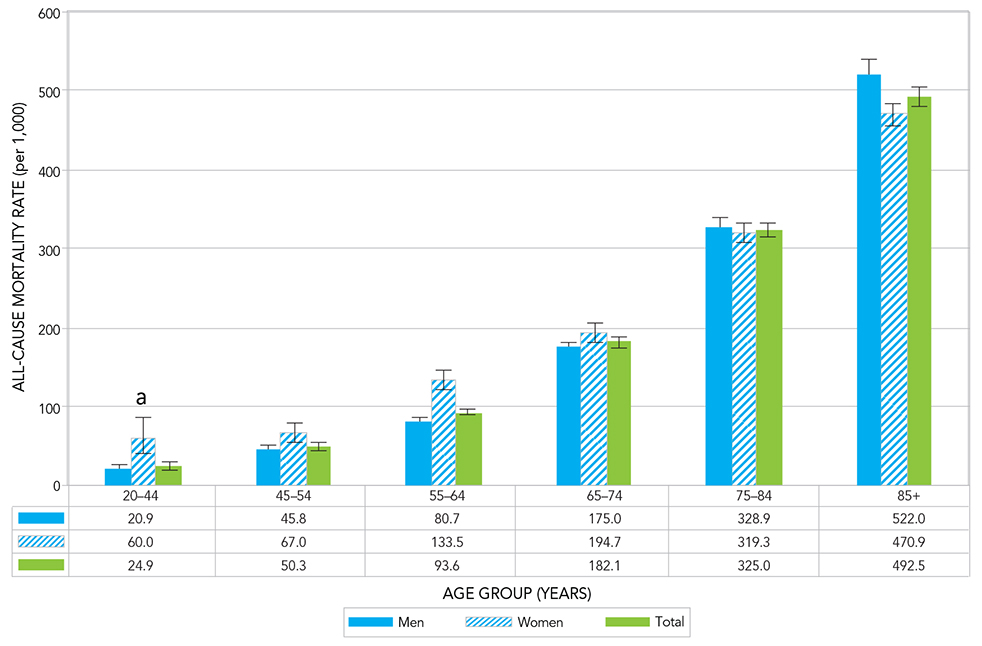
Notes: The 95% confidence interval shows an estimated range of values which is likely to include the true value 19 times out of 20.
Source: Public Health Agency of Canada, using Canadian Chronic Disease Surveillance System data files contributed by provinces and territories, May 2016.
- Figure 10C footnote 1
-
Data from Yukon were not available.
Figure 10C. Text description follows.
| Age group | Men | 95% Confidence Interval | Women | 95% Confidence Interval | Total | 95% Confidence Interval |
|---|---|---|---|---|---|---|
| 20-44 | 20.9 per 1,000 people | 15.0-28.5 | 60.0 per 1,000 peopleLong description 10C footnote a | 40.5-85.7 | 24.9 per 1,000 people | 19.0-32.0 |
| 45-54 | 45.8 per 1,000 people | 40.8-51.3 | 67.0 per 1,000 people | 55.6-80.2 | 50.3 per 1,000 people | 45.6-55.3 |
| 55-64 | 80.7 per 1,000 people | 75.5-86.2 | 133.5 per 1,000 people | 122.2-145.6 | 93.6 per 1,000 people | 88.8-98.7 |
| 65-74 | 175.0 per 1,000 people | 167.3-183.0 | 194.7 per 1,000 people | 183.4-206.5 | 182.1 per 1,000 people | 175.7-188.7 |
| 75-84 | 328.9 per 1,000 people | 318.1-340.0 | 319.3 per 1,000 people | 307.1-331.9 | 325.0 per 1,000 people | 316.8-333.2 |
| 85+ | 522.0 per 1,000 people | 504.1-540.4 | 470.9 per 1,000 people | 456.5-485.7 | 492.5 per 1,000 people | 481.3-504.0 |
Notes: The 95% confidence interval shows an estimated range of values which is likely to include the true value 19 times out of 20. Source: Public Health Agency of Canada, using Canadian Chronic Disease Surveillance System data files contributed by provinces and territories, May 2016. |
||||||
Figure 10D. All-cause mortality rates and rate ratios among Canadians aged 40 years and older with diagnosed heart failure compared to those without, by age group and sex, CanadaFigure 10D footnote *, 2012–2013
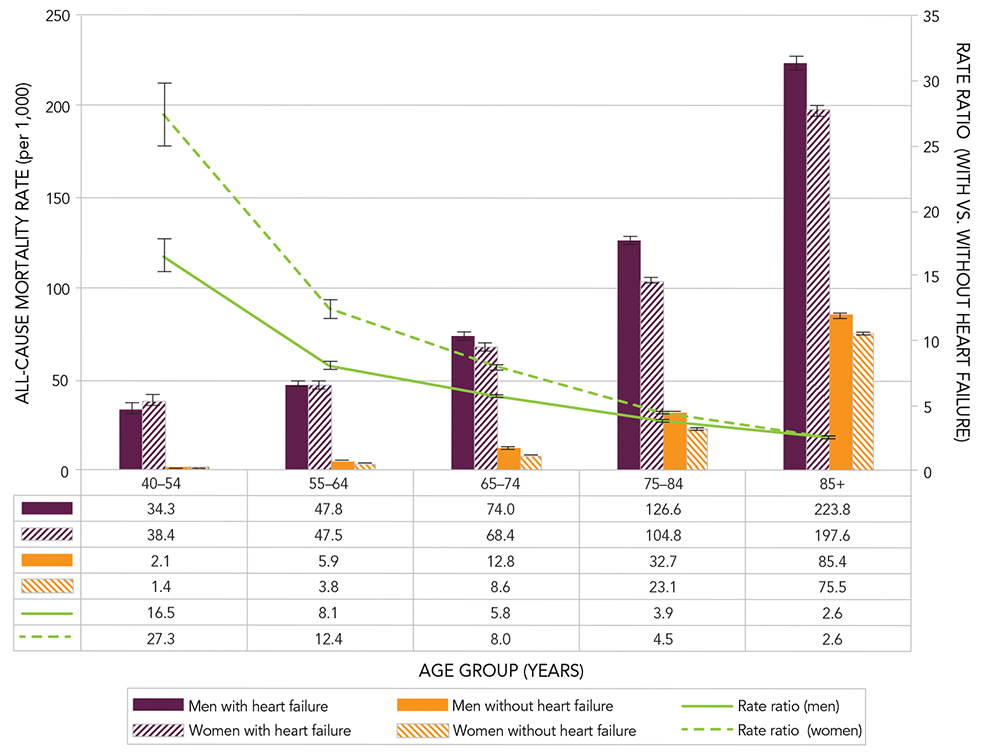
Notes: The 95% confidence interval shows an estimated range of values which is likely to include the true value 19 times out of 20.
Source: Public Health Agency of Canada, using Canadian Chronic Disease Surveillance System data files contributed by provinces and territories, May 2016.
- Figure 10D footnote 1
-
Data from Yukon were not available.
Figure 10D. Text description follows.
| Age group | Men with heart failure | 95% Confidence Interval | Women with heart failure | 95% Confidence Interval | Men without heart failure | 95% Confidence Interval | Women without heart failure | 95% Confidence Interval | Rate ratio (men) | 95% Confidence Interval | Rate ratio (women) | 95% Confidence Interval |
|---|---|---|---|---|---|---|---|---|---|---|---|---|
| 40-54 | 34.3 per 1,000 people | 31.9-36.9 | 38.4 per 1,000 people | 35.2-41.9 | 2.1 per 1,000 people | 2.0-2.1 | 1.4 per 1,000 people | 1.4-1.4 | 27.3 | 24.9-29.8 | 16.5 | 15.3-17.8 |
| 55-64 | 47.8 per 1,000 people | 46.0-49.7 | 47.5 per 1,000 people | 45.2-49.9 | 5.9 per 1,000 people | 5.8-6.0 | 3.8 per 1,000 people | 3.7-3.9 | 12.4 |
11.8-13.1 | 8.1 |
7.8-8.4 |
| 65-74 | 74.0 per 1,000 people | 72.2-75.8 | 68.4 per 1,000 people | 66.3-70.5 | 12.8 per 1,000 people | 12.6-13.0 | 8.6 per 1,000 people | 8.4-8.7 | 8.0 |
7.7-8.3 | 5.8 |
5.6-6.0 |
| 75-84 | 126.6 per 1,000 people | 124.5-128.8 | 104.8 per 1,000 people | 102.8-106.8 | 32.7 per 1,000 people | 32.3-33.2 | 23.1 per 1,000 people | 22.7-23.4 | 4.5 |
4.4-4.7 | 3.9 |
3.8-4.0 |
| 85+ | 223.8 per 1,000 people | 220.4-227.4 | 197.6 per 1,000 people | 195.1-200.1 | 85.4 per 1,000 people | 84.2-86.7 | 75.5 per 1,000 people | 74.7-76.3 | 2.6 |
2.6-2.7 | 2.6 |
2.6-2.7 |
Notes: The 95% confidence interval shows an estimated range of values which is likely to include the true value 19 times out of 20. Source: Public Health Agency of Canada, using Canadian Chronic Disease Surveillance System data files contributed by provinces and territories, May 2016. |
||||||||||||
Factors contributing to the sex differences in heart disease
As shown in Figure 8A, women have incident heart disease about ten years later than men. Such a lag has been documented in the Framingham Heart Study.Footnote 23,Footnote 24 Evidence indicates that sex hormones, namely estrogens, provide a cardioprotective effect to women before menopauseFootnote 25,Footnote 26,Footnote 27,Footnote 28 which may explain the lower incidence rates observed in younger women compared to men or postmenopausal women of the same age. This protective effect disappears shortly after menopause,Footnote 24 at which time drop in sex hormones occurs and the risk of coronary heart disease rises sharply.
The mechanism explaining this protective effect has yet to be fully understood. The burden of risk factors that women carry after menopause, such as a rise in cholesterol levels and a high prevalence of hypertension and diabetes, has been shown to make women more vulnerable to heart disease.Footnote 24
Moreover, heart conditions may be more difficult to diagnose in women because they sometimes have fewer typical symptoms compared with men, which may contribute to the sex-specific gap. Although chest pain is the most common symptom of AMI in both sexes, women are more likely than men to present to the hospital without chest pain or with mild chest pain. As a result, women are more likely to be misdiagnosed.Footnote 29,Footnote 30 Longer delays in seeking medical care have also been documented in women and may contribute to poorer outcomes for women than men, such as higher in-hospital mortality.Footnote 29 Complications such as major bleeding during hospitalization have also been studied and women, especially younger women, were at greater risk than men of having such complications.Footnote 31
These factors likely also contribute to the higher all-cause mortality rates observed in women younger than 75 years old compared with men of the same age who had a prior AMI, as shown in Figure 10B and Figure 10C above. Studies have found similar results, with younger women having higher mortality than men after a myocardial infarction.Footnote 32,Footnote 33,Footnote 34 Even after adjusting for comorbidities and cardiovascular risk factors, Champney et al. found that women aged less than 70 years old still had a greater risk of death (approximately 20%) compared to men in the same age group.Footnote 33
In the CCDSS, this difference in all-cause mortality among women and men with IHD (or those who had an AMI) disappeared after the age of 75 years. In fact, elderly men have higher all-cause mortality rates than women of the same age. Women's longer life expectancyFootnote 35 and greater use of health services in general in older age, including visiting a general practitioner, may contribute to the pattern observed.Footnote 36
With men being more likely than women to be newly diagnosed with IHD and heart failure, it is important to continue to raise awareness of the heart disease burden in men. Better detection of heart disease in women of all ages is also of high importance because of the high fatality rate associated with their first AMIFootnote 21 and poorer outcomes and risk of complications in general.
Infographic 6.
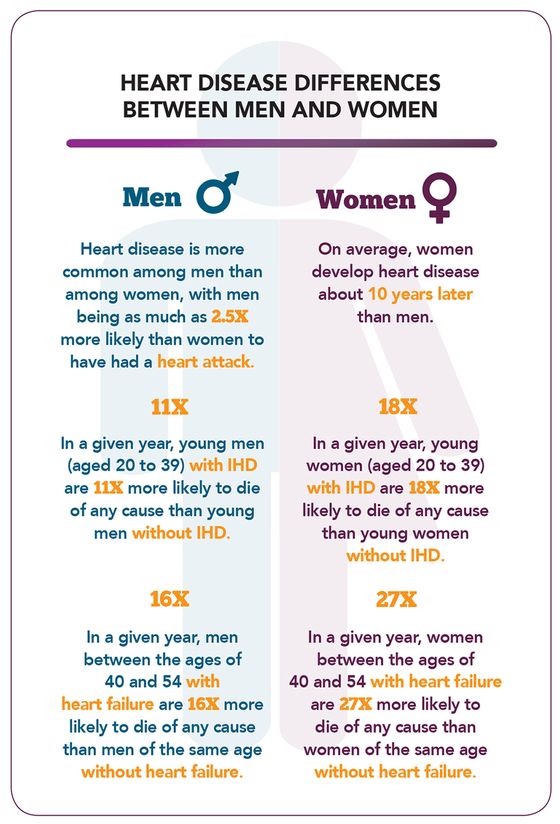
Infographic 6 - Text Description
Heart disease differences between men and women. Heart disease is more common among men than among women, with men being as much as two and a half times more likely than women to have had a heart attack. In a given year, young men (aged 20 to 39) with IHD are 11 times more likely to die of any cause than young men without IHD. In a given year, men between the ages of 40 and 54 with heart failure are 16 times more likely to die of any cause than men of the same age without heart failure.
On average, women develop heart disease about 10 years later than men. In a given year, young women (aged 20 to 39) with IHD are 18 times more likely to die of any cause than young women without IHD. In a given year, women between the ages of 40 and 54 with heart failure are 27 times more likely to die of any cause than women of the same age without heart failure.
2.3 Pan-Canadian perspective
Across Canada, estimates vary widely by province/territory and by condition. Unless otherwise specified, all differences from the national average presented herein are statistically significant.
2.3.1 Prevalence
- In 2012–2013, age-standardized ischemic heart disease (IHD) prevalence ranged from a low of 4.6% in Nunavut to a high of 9.7% in Nova Scotia (Figure 11).
- Age-standardized acute myocardial infarction (AMI) occurrence ranged from a low of 1.1% in Nunavut to a high of 2.6% in Newfoundland and Labrador (Figure 12).
- Age-standardized heart failure prevalence ranged from a low of 3.2% in Quebec, New Brunswick and Nova Scotia to a high of 6.4% in Nunavut (Figure 13).
Figure 11. Age-standardizedFigure 11 footnote † prevalence of diagnosed ischemic heart disease, among Canadians aged 20 years and older, by province or territoryFigure 11 footnote *, 2012–2013
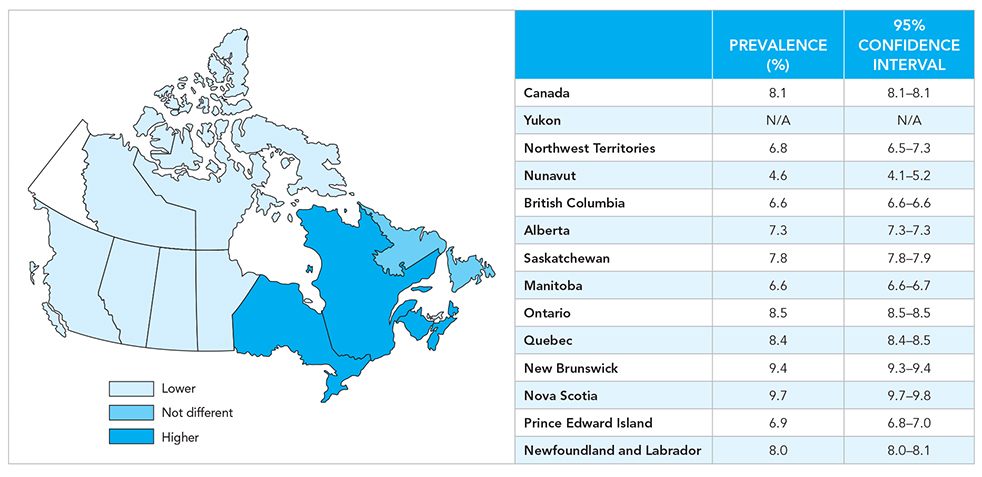
Notes: The 95% confidence interval shows an estimated range of values which is likely to include the true value 19 times out of 20.
Source: Public Health Agency of Canada, using Canadian Chronic Disease Surveillance System data files contributed by provinces and territories, May 2016.
- Figure 11 footnote 1
-
Age-standardized to the 2011 Canadian population.
- Figure 11 footnote 2
-
Data from Yukon were not available.
Figure 11. Text description follows.
| Province or territoryLong description 11 footnote * | Prevalence (%) | 95% Confidence Interval |
|---|---|---|
| Canada | 8.1% | 8.1-8.1 |
| Yukon | N/A | N/A |
| Northwest Territories | 6.8% | 6.5-7.3 |
| Nunavut | 4.6% | 4.1-5.2 |
| British Columbia | 6.6% | 6.6-6.6 |
| Alberta | 7.3% | 7.3-7.3 |
| Saskatchewan | 7.8% | 7.8-7.9 |
| Manitoba | 6.6% | 6.6-6.7 |
| Ontario | 8.5% | 8.5-8.5 |
| Quebec | 8.4% | 8.4-8.5 |
| New Brunswick | 9.4% | 9.3-9.4 |
| Nova Scotia | 9.7% | 9.7-9.8 |
| Prince Edward Island | 6.9% | 6.8-7.0 |
| Newfoundland and Labrador | 8.0% | 8.0-8.1 |
Notes: The 95% confidence interval shows an estimated range of values which is likely to include the true value 19 times out of 20. Source: Public Health Agency of Canada, using Canadian Chronic Disease Surveillance System data files contributed by provinces and territories, May 2016. |
||
Figure 12. Age-standardizedFigure 12 footnote † occurrence of acute myocardial infarction, among Canadians aged 20 years and older, by province or territoryFigure 12 footnote *, 2012–2013
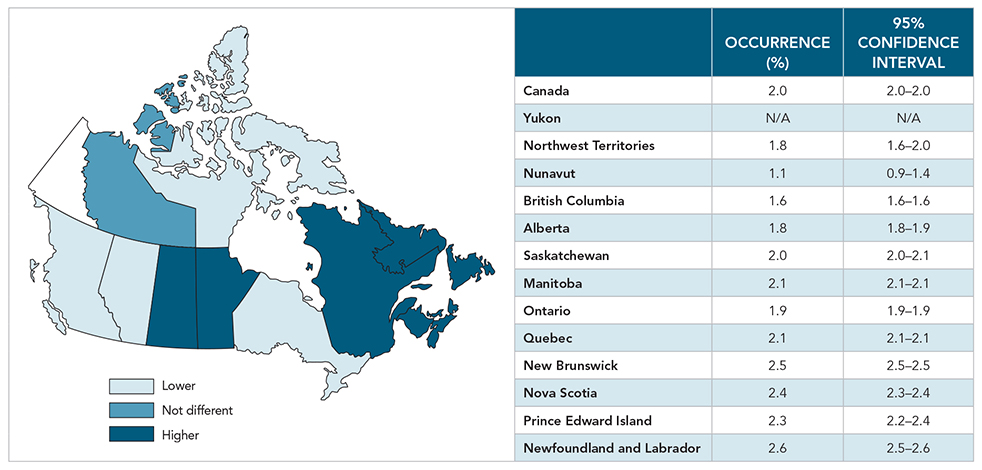
Notes: The 95% confidence interval shows an estimated range of values which is likely to include the true value 19 times out of 20.
Source: Public Health Agency of Canada, using Canadian Chronic Disease Surveillance System data files contributed by provinces and territories, May 2016.
- Figure 12 footnote 1
-
Age-standardized to the 2011 Canadian population.
- Figure 12 footnote 2
-
Data from Yukon were not available.
Figure 12. Text description follows.
| Province or territoryLong description 12 footnote * | Occurrence (%) | 95% Confidence Interval |
|---|---|---|
| Canada | 2.0% | 2.0-2.0 |
| Yukon | N/A | N/A |
| Northwest Territories | 1.8% | 1.6-2.0 |
| Nunavut | 1.1% | 0.9-1.4 |
| British Columbia | 1.6% | 1.6-1.6 |
| Alberta | 1.8% | 1.8-1.9 |
| Saskatchewan | 2.0% | 2.0-2.1 |
| Manitoba | 2.1% | 2.1-2.1 |
| Ontario | 1.9% | 1.9-1.9 |
| Quebec | 2.1% | 2.1-2.1 |
| New Brunswick | 2.5% | 2.5-2.5 |
| Nova Scotia | 2.4% | 2.3-2.4 |
| Prince Edward Island | 2.3% | 2.2-2.4 |
| Newfoundland and Labrador | 2.6% | 2.5-2.6 |
Notes: The 95% confidence interval shows an estimated range of values which is likely to include the true value 19 times out of 20. Source: Public Health Agency of Canada, using Canadian Chronic Disease Surveillance System data files contributed by provinces and territories, May 2016. |
||
Figure 13. Age-standardizedFigure 13 footnote † prevalence of diagnosed heart failure, among Canadians aged 40 years and older, by province or territoryFigure 13 footnote *, 2012–2013
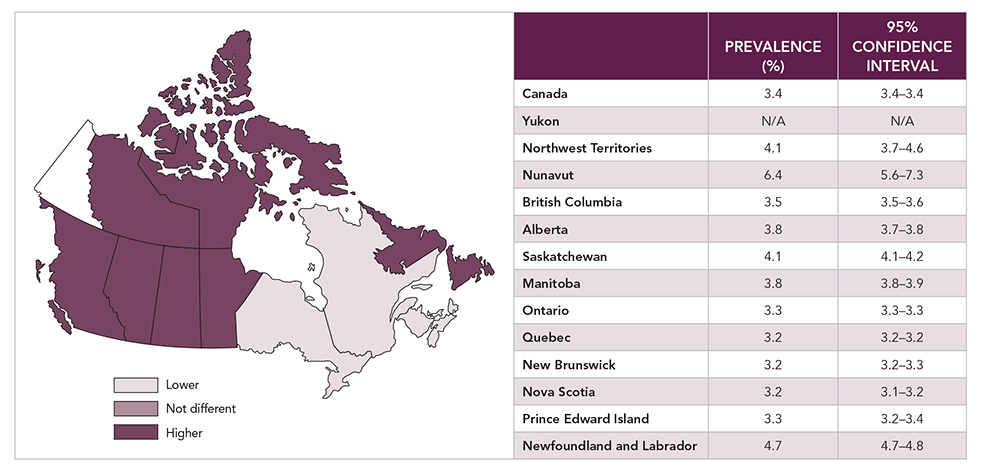
Notes: The 95% confidence interval shows an estimated range of values which is likely to include the true value 19 times out of 20.
Source: Public Health Agency of Canada, using Canadian Chronic Disease Surveillance System data files contributed by provinces and territories, May 2016.
- Figure 13 footnote 1
-
Age-standardized to the 2011 Canadian population.
- Figure 13 footnote 2
-
Data from Yukon were not available.
Figure 13. Text description follows.
| Province or territoryLong description 13 footnote * | Prevalence (%) | 95% Confidence Interval |
|---|---|---|
| Canada | 3.4% | 3.4-3.4 |
| Yukon | N/A | N/A |
| Northwest Territories | 4.1% | 3.7-4.6 |
| Nunavut | 6.4% | 5.6-7.3 |
| British Columbia | 3.5% | 3.5-3.6 |
| Alberta | 3.8% | 3.7-3.8 |
| Saskatchewan | 4.1% | 4.1-4.2 |
| Manitoba | 3.8% | 3.8-3.9 |
| Ontario | 3.3% | 3.3-3.3 |
| Quebec | 3.2% | 3.2-3.2 |
| New Brunswick | 3.2% | 3.2-3.3 |
| Nova Scotia | 3.2% | 3.1-3.2 |
| Prince Edward Island | 3.3% | 3.2-3.4 |
| Newfoundland and Labrador | 4.7% | 4.7-4.8 |
Notes: The 95% confidence interval shows an estimated range of values which is likely to include the true value 19 times out of 20. Source: Public Health Agency of Canada, using Canadian Chronic Disease Surveillance System data files contributed by provinces and territories, May 2016. |
||
2.3.2 Incidence (new cases)
- In 2012–2013, age-standardized IHD incidence rates ranged from a low of 4.5 per 1,000 in Nunavut to a high of 8.2 per 1,000 in New Brunswick (Figure 14). Rates in New Brunswick, Quebec and Alberta were higher than the national average.
- As for AMI, age-standardized rates ranged from 1.9 per 1,000 in British Columbia to 2.9 per 1,000 in Nova Scotia (Figure 14).
- Age-standardized heart failure incidence rates ranged from 4.8 per 1,000 in Nova Scotia and Newfoundland and Labrador to 11.3 per 1,000 in Nunavut, but the latter should be interpreted with caution due to variability in the rates. Heart failure incidence rates were higher in British Columbia, Alberta, Saskatchewan and Manitoba while rates in Ontario, Quebec and Nova Scotia were lower than the Canadian average (Figure 15). Rates in the other provinces and territories were not statistically different than Canada as a whole.
Figure 14. Incidence (rateFigure 14 footnote †) of diagnosed ischemic heart disease and occurrence (rateFigure 14 footnote †) of first acute myocardial infarction (AMI), among Canadians aged 20 years and older, by province or territoryFigure 14 footnote *, 2012–2013
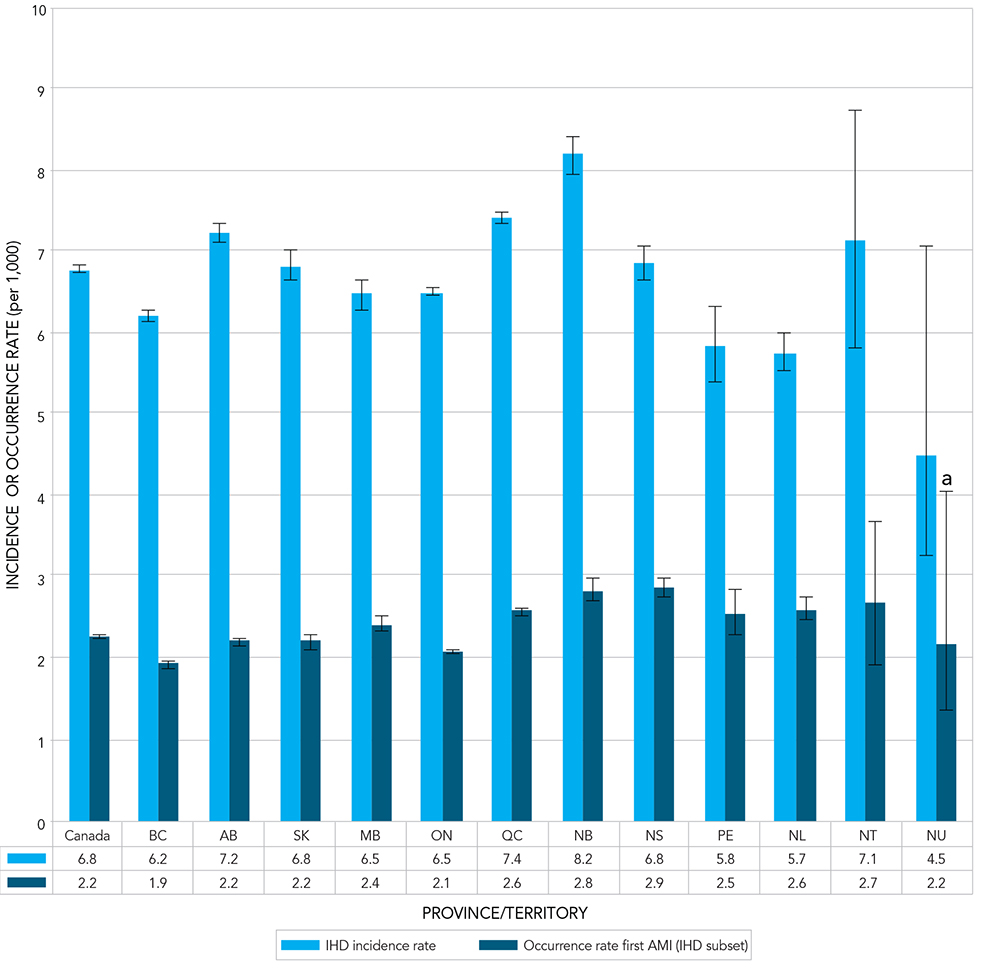
a Interpret with caution, coefficient of variation between 16.6% and 33.3%.
Notes: The 95% confidence interval shows an estimated range of values which is likely to include the true value 19 times out of 20. BC: British Columbia, AB: Alberta, SK: Saskatchewan, MB: Manitoba, ON: Ontario, QC: Quebec, NB: New Brunswick, NS: Nova Scotia, PE: Prince Edward Island, NL: Newfoundland and Labrador, NT: Northwest Territories, NU: Nunavut.
Source: Public Health Agency of Canada, using Canadian Chronic Disease Surveillance System data files contributed by provinces and territories, May 2016.
- Figure 14 footnote 1
-
Age-standardized to the 2011 Canadian population.
- Figure 14 footnote 2
-
Data from Yukon were not available.
Figure 14. Text description follows.
| Province or territoryLong description 14 footnote * | IHD incidence rate | 95% Confidence Interval | Occurrence rate first AMI (IHD subset) | 95% Confidence Interval |
|---|---|---|---|---|
| Canada | 6.8 per 1,000 people | 6.7-6.8 | 2.2 per 1,000 people | 2.2-2.3 |
| British Columbia | 6.2 per 1,000 people | 6.1-6.3 | 1.9 per 1,000 people | 1.9-2.0 |
| Alberta | 7.2 per 1,000 people | 7.1-7.3 | 2.2 per 1,000 people | 2.1-2.3 |
| Saskatchewan | 6.8 per 1,000 people | 6.6-7.0 | 2.2 per 1,000 people | 2.1-2.3 |
| Manitoba | 6.5 per 1,000 people | 6.3-6.6 | 2.4 per 1,000 people | 2.3-2.5 |
| Ontario | 6.5 per 1,000 people | 6.4-6.6 | 2.1 per 1,000 people | 2.0-2.1 |
| Quebec | 7.4 per 1,000 people | 7.3-7.5 | 2.6 per 1,000 people | 2.5-2.6 |
| New Brunswick | 8.2 per 1,000 people | 7.9-8.4 | 2.8 per 1,000 people | 2.7-3.0 |
| Nova Scotia | 6.8 per 1,000 people | 6.7-7.0 | 2.9 per 1,000 people | 2.8-3.0 |
| Prince Edward Island | 5.8 per 1,000 people | 5.4-6.3 | 2.5 per 1,000 people | 2.3-2.8 |
| Newfoundland and Labrador | 5.7 per 1,000 people | 5.5-6.0 | 2.6 per 1,000 people | 2.4-2.7 |
| Northwest Territories | 7.1 per 1,000 people | 5.8-8.7 | 2.7 per 1,000 people | 1.9-3.7 |
| Nunavut | 4.5 per 1,000 people | 3.3-7.0 | 2.2 per 1,000 peopleLong description 14 footnote a | 1.3-4.1 |
Notes: The 95% confidence interval shows an estimated range of values which is likely to include the true value 19 times out of 20. Source: Public Health Agency of Canada, using Canadian Chronic Disease Surveillance System data files contributed by provinces and territories, May 2016. |
||||
Figure 15. Age-standardizedFigure 15 footnote † incidence of diagnosed heart failure, among Canadians aged 40 years and older, by province or territoryFigure 15 footnote *, 2012–2013
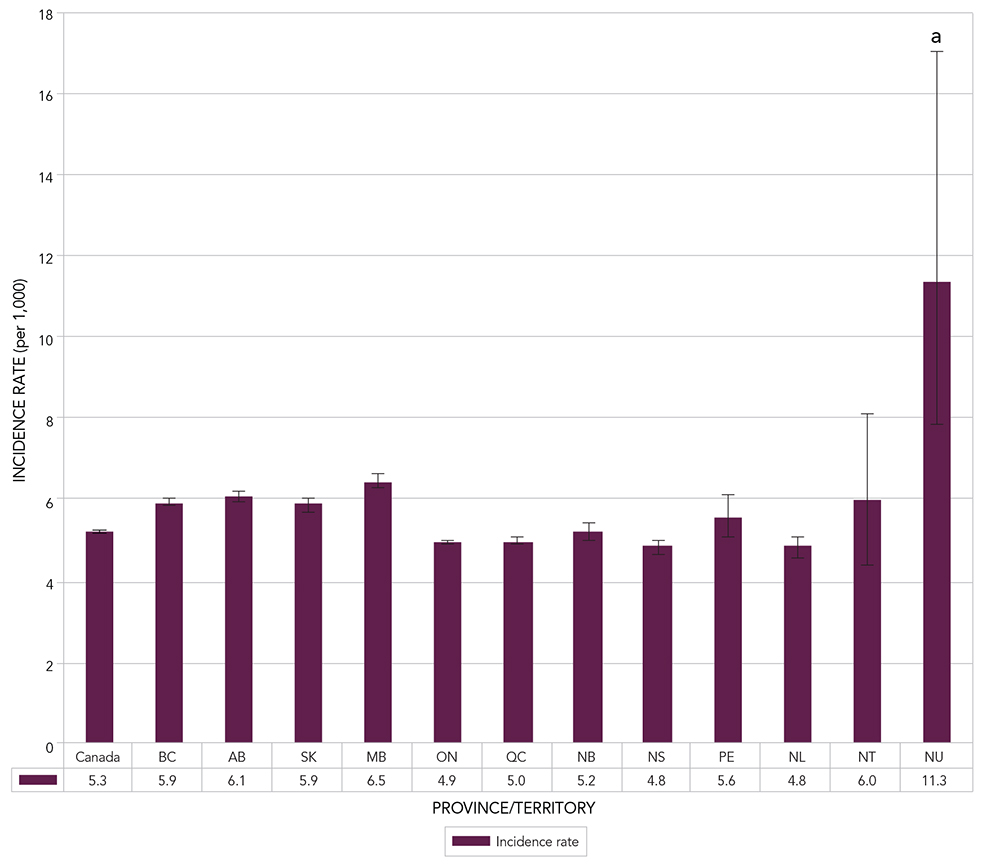
a Interpret with caution, coefficient of variation between 16.6% and 33.3%.
Notes: The 95% confidence interval shows an estimated range of values which is likely to include the true value 19 times out of 20. BC: British Columbia, AB: Alberta, SK: Saskatchewan, MB: Manitoba, ON: Ontario, QC: Quebec, NB: New Brunswick, NS: Nova Scotia, PE: Prince Edward Island, NL: Newfoundland and Labrador, NT: Northwest Territories, NU: Nunavut.
Source: Public Health Agency of Canada, using Canadian Chronic Disease Surveillance System data files contributed by provinces and territories, May 2016.
- Figure 15 footnote 1
-
Age-standardized to the 2011 Canadian population.
- Figure 15 footnote 2
-
Data from Yukon were not available.
Figure 15. Text description follows.
| Province or territoryLong description 15 footnote * | Incidence rate | 95% Confidence Interval |
|---|---|---|
| Canada | 5.3 per 1,000 people | 5.2-5.3 |
| British Columbia | 5.9 per 1,000 people | 5.8-6.0 |
| Alberta | 6.1 per 1,000 people | 5.9-6.2 |
| Saskatchewan | 5.9 per 1,000 people | 5.7-6.1 |
| Manitoba | 6.5 per 1,000 people | 6.3-6.7 |
| Ontario | 4.9 per 1,000 people | 4.9-5.0 |
| Quebec | 5.0 per 1,000 people | 4.9-5.0 |
| New Brunswick | 5.2 per 1,000 people | 5.0-5.5 |
| Nova Scotia | 4.8 per 1,000 people | 4.7-5.0 |
| Prince Edward Island | 5.6 per 1,000 people | 5.1-6.1 |
| Newfoundland and Labrador | 4.8 per 1,000 people | 4.6-5.1 |
| Northwest Territories | 6.0 per 1,000 people | 4.4-8.1 |
| Nunavut | 11.3 per 1,000 peopleLong description 15 footnote a | 7.8-17.0 |
Notes: The 95% confidence interval shows an estimated range of values which is likely to include the true value 19 times out of 20. Source: Public Health Agency of Canada, using Canadian Chronic Disease Surveillance System data files contributed by provinces and territories, May 2016. |
||
The differences observed for IHD and AMI across provinces and territories may relate to differences in the distribution of risk factors known to contribute to the development of heart disease such as smoking, low level of physical activity, alcohol abuse, low consumption of fruits and vegetables, obesity, diabetes and hypertension. These risk factors have been documented to be high in the Atlantic provinces.Footnote 6 However, differences in detection and treatment practices, as well as differences in data coding, remuneration models and shadow billing practices also likely play a role in the patterns observed. Even though differences are statistically significant, methodological differences may explain the patterns observed in addition to actual differences in the health status of the populations.
Heart failure estimates were higher in British Columbia, Alberta, Saskatchewan and Manitoba and lower in Quebec, New Brunswick and Nova Scotia, a pattern that is not consistent with that observed for IHD and AMI. This may relate to differences in billing methods and clinical practices as highlighted previously and warrants further investigation.
3. Ischemic heart disease and heart failure relationship
3.1 Heart disease risk factors and treatments
The underlying mechanism of ischemic heart disease (IHD) is atherosclerosis, which refers to the build-up of plaque (fat and other materials) on the inner walls of coronary arteries. Atherosclerosis can lead to blockages of the coronary arteries and restrict the flow of blood to the heart muscle.
Risk factors for IHD include high cholesterol, smoking, high blood pressure (hypertension), diabetes, abdominal obesity, and lack of regular physical activity.Footnote 17 Unhealthy diet and excessive alcohol consumption have also been shown to increase the risk of IHD.Footnote 17 Treatment options for IHD include lifestyle management, medications, and procedures such as percutaneous coronary intervention or coronary artery bypass graft surgery.
IHD can lead to acute myocardial infarction (AMI) which refers to deprivation of blood supply to a part of the heart muscle for a long enough period of time to cause tissue death. The most common reason for an AMI is thrombus formation (blood clot) in vessels with plaque. Typical symptoms of an AMI may include chest pain, often radiating to the left arm and left side of the neck, shortness of breath, sweating, and palpitations.
Left untreated, IHD may lead to heart failure over time. Heart failure is a clinical syndrome and refers to the inability of the heart to pump an adequate volume of blood throughout the body. In other words, the heart is not pumping as well as it should. The most common cause of heart failure is damage to the heart muscle as a result of heart disease.Footnote 37 Other factors may also increase the risk of heart failure including, but not limited to, higher body mass index, abdominal fat accumulation, elevated blood cholesterol, elevated fasting blood glucose, elevated systolic blood pressure, cigarette smoking, and valvular heart disease.Footnote 37,Footnote 38 Symptoms of heart failure may include shortness of breath, swelling of the legs, and a low energy level.Footnote 38 The management of heart failure includes medications, restriction of fluid intake, and a low salt diet.Footnote 38
3.2 Ischemic heart disease and heart failure comorbidity
Examining the comorbidity of IHD and heart failure in the Canadian Chronic Disease Surveillance System in 2012–2013 overall, it was found that among those with diagnosed heart failure, about 71.0% of individuals aged 40 years and older also had IHD compared to only about 10.5% in those without heart failure. The age-specific prevalence of IHD among those with and without heart failure is shown in Figure 16. The prevalence of IHD among those with and without heart failure increased with age, but the difference between the two groups declined with age.
Over time, the age-standardized prevalence ratio of IHD among those with and without heart failure decreased from 6.9 in 2000–2001 to 5.7 in 2012–2013 (Figure 17). A similar decline is seen for both women and men. This trend suggests that the difference in IHD prevalence between those with and without heart failure is getting smaller over time.
Overall, in 2012–2013, among those aged 40 years and older with diagnosed IHD, about 20.3% also had heart failure compared to only 1.2% in those aged 40 years and older without IHD. The age-specific prevalence of heart failure among those with and without IHD is shown in Figure 18. The prevalence of heart failure among those with and without IHD increased with age and the difference between the two groups declined with age.
The age-standardized prevalence ratio of heart failure among those with and without IHD decreased over time from 9.3 in 2000–2001 to 8.8 in 2012–2013. The prevalence ratio remained constant in men over the observation period, but declined from 9.2 to 8.2 in women (Figure 19).
Infographic 7.
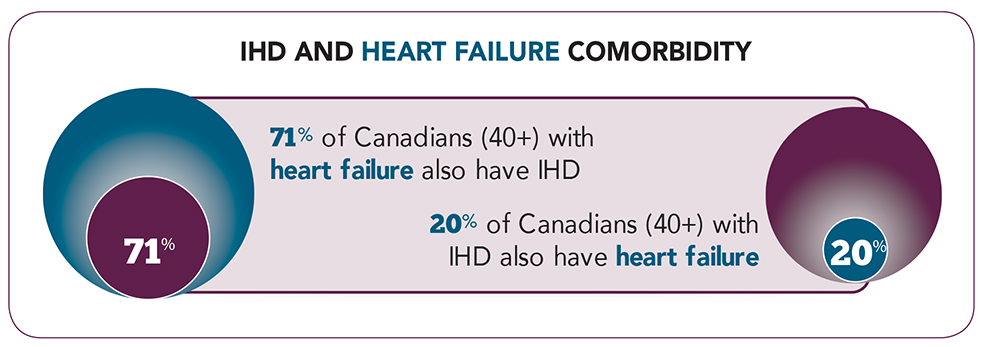
Infographic 7 - Text Description
IHD and heart failure comorbidity. 71% of Canadians aged 40 years and older with heart failure also have IHD while 20% of Canadians aged 40 years and older with IHD have heart failure.
Figure 16. Prevalence of diagnosed ischemic heart disease (IHD) among Canadians aged 40 years and older with and without diagnosed heart failure (HF), by age group, CanadaFigure 16 footnote *, 2012–2013
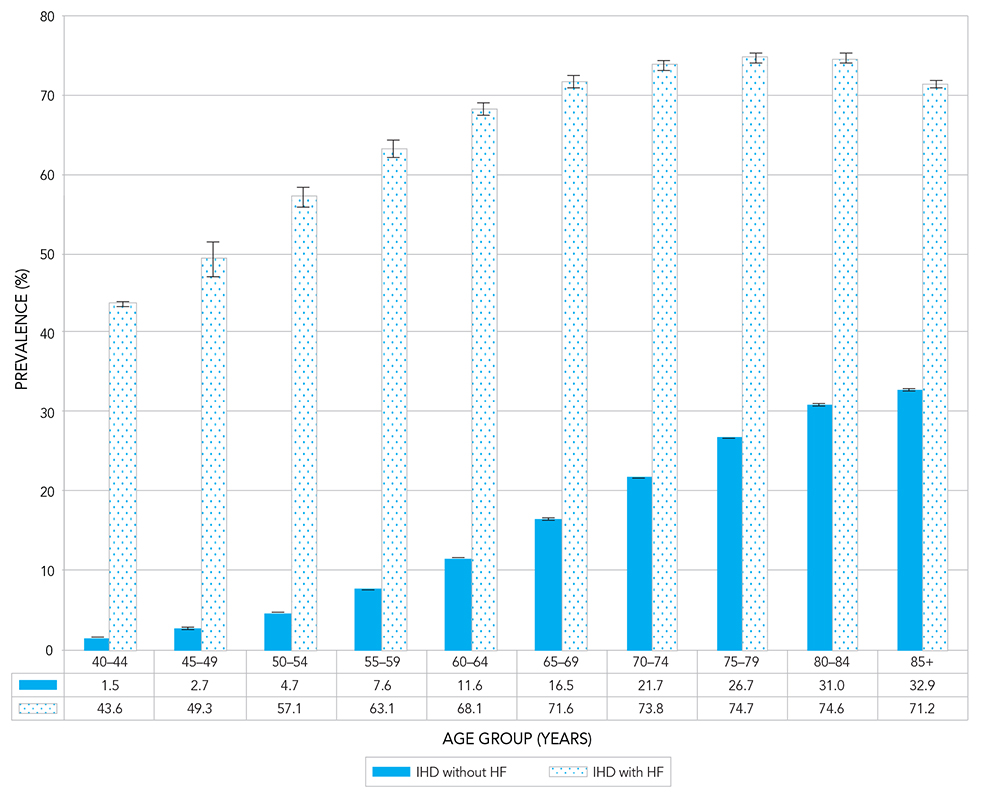
Notes: The 95% confidence interval shows an estimated range of values which is likely to include the true value 19 times out of 20.
Source: Public Health Agency of Canada, using Canadian Chronic Disease Surveillance System data files contributed by provinces and territories, May 2016.
- Figure 16 footnote 1
-
Data from Yukon were not available.
Figure 16. Text description follows.
| Age group (Years) | IHD with HF | 95% Confidence Interval | IHD without HF | 95% Confidence Interval |
|---|---|---|---|---|
| 40-44 | 43.6% | 41.5-45.8 | 1.5% | 1.4-1.5 |
| 45-49 | 49.3% | 47.9-50.6 | 2.7% | 2.7-2.7 |
| 50-54 | 57.1% | 56.1-58.1 | 4.7% | 4.6-4.7 |
| 55-59 | 63.1% | 62.3- 64.0 | 7.6% | 7.6-7.6 |
| 60-64 | 68.1% | 67.4- 68.9 | 11.6% | 11.5-11.6 |
| 65-69 | 71.6% | 70.9-72.2 | 16.5% | 16.4-16.5 |
| 70-74 | 73.8% | 73.2-74.4 | 21.7% | 21.6-21.8 |
| 75-79 | 74.7% | 74.2-75.3 | 26.7% | 26.6-26.8 |
| 80-84 | 74.6% | 74.1-75.1 | 31.0% | 30.8-31.1 |
| 85+ | 71.2% | 70.8-71.6 | 32.9% | 32.7-33.0 |
Notes: The 95% confidence interval shows an estimated range of values which is likely to include the true value 19 times out of 20. Source: Public Health Agency of Canada, using Canadian Chronic Disease Surveillance System data files contributed by provinces and territories, May 2016. |
||||
Figure 17. Age-standardizedFigure 17 footnote † prevalence ratio of diagnosed ischemic heart disease among Canadians aged 40 years and older with and without diagnosed heart failure, CanadaFigure 17 footnote *, 2000–2001 to 2012–2013
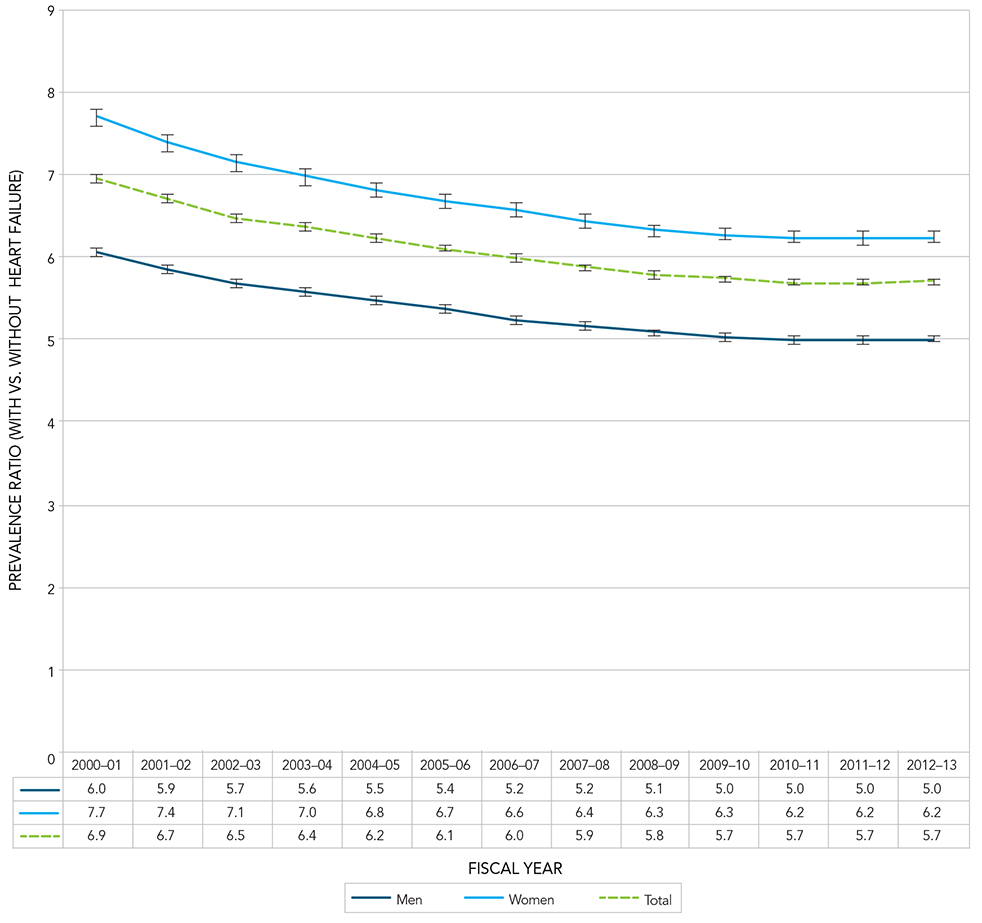
Notes: The 95% confidence interval shows an estimated range of values which is likely to include the true value 19 times out of 20.
Source: Public Health Agency of Canada, using Canadian Chronic Disease Surveillance System data files contributed by provinces and territories, May 2016.
- Figure 17 footnote 1
-
Age-standardized to the 2011 Canadian population.
- Figure 17 footnote 2
-
Data from Yukon were not available.
Figure 17. Text description follows.
| Fiscal Year | Men | 95% Confidence Interval | Women | 95% Confidence Interval | Total | 95% Confidence Interval |
|---|---|---|---|---|---|---|
| 2000-2001 | 6.0 | 6.0-6.1 | 7.7 | 7.6-7.8 | 6.9 | 6.9-7.0 |
| 2001-2002 | 5.9 | 5.8-5.9 | 7.4 | 7.3-7.5 | 6.7 | 6.6-6.8 |
| 2002-2003 | 5.7 | 5.6-5.7 | 7.1 | 7.0-7.2 | 6.5 | 6.4-6.5 |
| 2003-2004 | 5.6 | 5.5-5.6 | 7.0 | 6.9-7.1 | 6.4 | 6.3-6.4 |
| 2004-2005 | 5.5 | 5.4-5.5 | 6.8 | 6.7-6.9 | 6.2 | 6.2-6.3 |
| 2005-2006 | 5.4 | 5.3-5.4 | 6.7 | 6.6-6.8 | 6.1 | 6.1-6.1 |
| 2006-2007 | 5.2 | 5.2-5.3 | 6.6 | 6.5-6.6 | 6.0 | 5.9-6.0 |
| 2007-2008 | 5.2 | 5.1-5.2 | 6.4 | 6.3-6.5 | 5.9 | 5.8-5.9 |
| 2008-2009 | 5.1 | 5.0-5.1 | 6.3 | 6.2-6.4 | 5.8 | 5.7-5.8 |
| 2009-2010 | 5.0 | 5.0-5.1 | 6.3 | 6.2-6.4 | 5.7 | 5.7-5.8 |
| 2010-2011 | 5.0 | 5.0-5.0 | 6.2 | 6.2-6.3 | 5.7 | 5.7-5.7 |
| 2011-2012 | 5.0 | 5.0-5.0 | 6.2 | 6.1-6.3 | 5.7 | 5.6-5.7 |
| 2012-2013 | 5.0 | 5.0-5.1 | 6.2 | 6.2-6.3 | 5.7 | 5.7-5.7 |
Notes: The 95% confidence interval shows an estimated range of values which is likely to include the true value 19 times out of 20. Source: Public Health Agency of Canada, using Canadian Chronic Disease Surveillance System data files contributed by provinces and territories, May 2016. |
||||||
Figure 18. Prevalence of diagnosed heart failure (HF) among Canadians aged 40 years and older with and without diagnosed ischemic heart disease (IHD), by age group, CanadaFigure 18 footnote *, 2012–2013
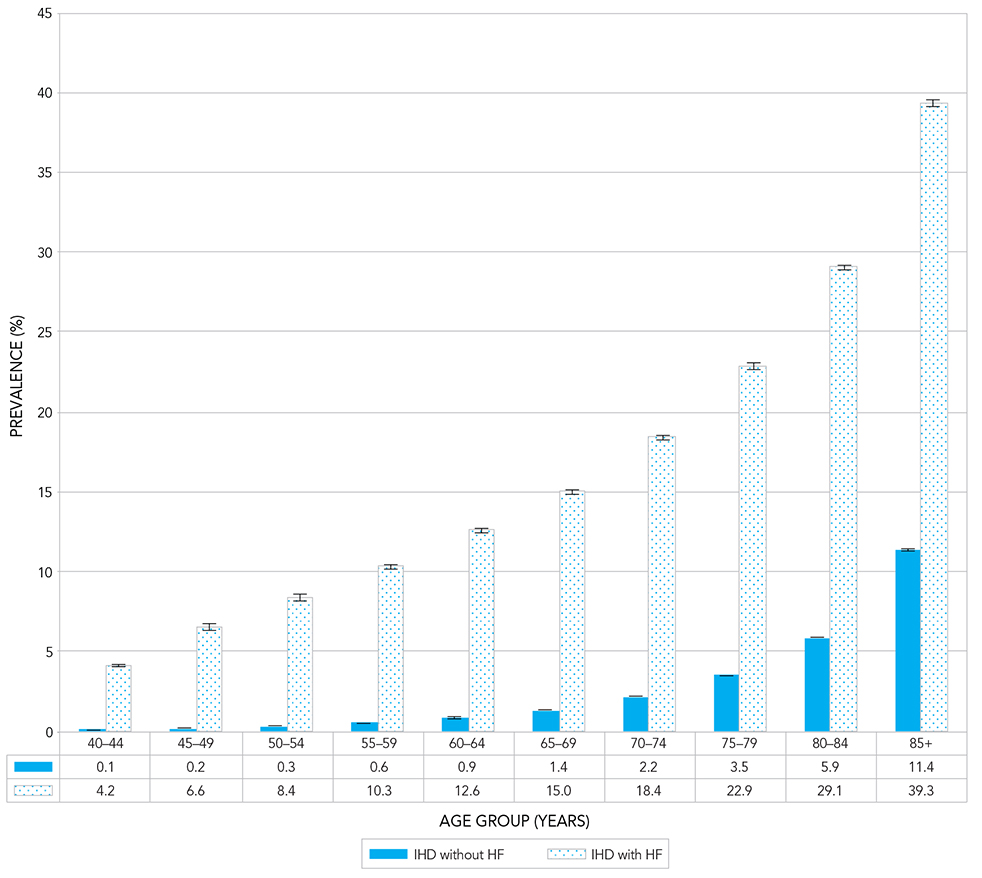
Notes: The 95% confidence interval shows an estimated range of values which is likely to include the true value 19 times out of 20.
Source: Public Health Agency of Canada, using Canadian Chronic Disease Surveillance System data files contributed by provinces and territories, May 2016.
- Figure 18 footnote 1
-
Data from Yukon were not available.
Figure 18. Text description follows.
| Age group (Years) | IDH without HF | 95% Confidence Interval | IDH with HF | 95% Confidence Interval |
|---|---|---|---|---|
| 40-44 | 0.1% | 0.1-0.1 | 4.2% | 4.0-4.4 |
| 45-49 | 0.2% | 0.2-0.2 | 6.6% | 6.4-6.8 |
| 50-54 | 0.3% | 0.3-0.3 | 8.4% | 8.2-8.5 |
| 55-59 | 0.6% | 0.5-0.6 | 10.3% | 10.2-10.5 |
| 60-64 | 0.9% | 0.9-0.9 | 12.6% | 12.5-12.7 |
| 65-69 | 1.4% | 1.3-1.4 | 15.0% | 14.9-15.2 |
| 70-74 | 2.2% | 2.1-2.2 | 18.4% | 18.3-18.6 |
| 75-79 | 3.5% | 3.5-3.6 | 22.9% | 22.7-23.0 |
| 80-84 | 5.9% | 5.8-6.0 | 29.1% | 28.9-29.3 |
| 85+ | 11.4% | 11.3-11.5 | 39.3% | 39.1-39.5 |
Notes: The 95% confidence interval shows an estimated range of values which is likely to include the true value 19 times out of 20. Source: Public Health Agency of Canada, using Canadian Chronic Disease Surveillance System data files contributed by provinces and territories, May 2016. |
||||
Figure 19. Age-standardizedFigure 19 footnote † prevalence ratio of diagnosed heart failure among Canadians aged 40 years and older with and without diagnosed ischemic heart disease (IHD), CanadaFigure 19 footnote *, 2000–2001 to 2012–2013
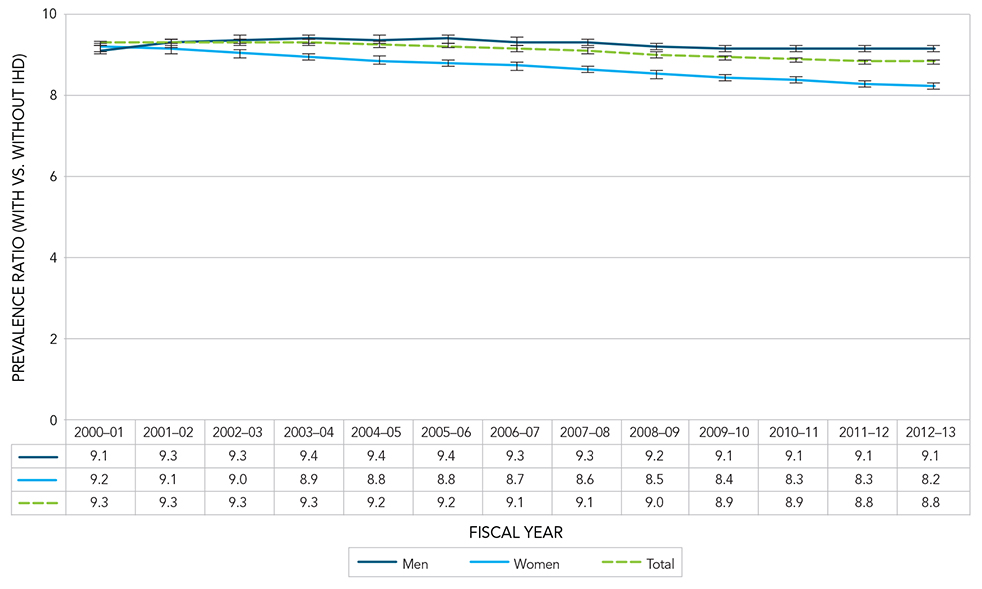
Notes: The 95% confidence interval shows an estimated range of values which is likely to include the true value 19 times out of 20.
Source: Public Health Agency of Canada, using Canadian Chronic Disease Surveillance System data files contributed by provinces and territories, May 2016.
- Figure 19 footnote 1
-
Age-standardized to the 2011 Canadian population.
- Figure 19 footnote 2
-
Data from Yukon were not available.
Figure 19. Text description follows.
| Fiscal Year | Men | 95% Confidence Interval | Women | 95% Confidence Interval | Total | 95% Confidence Interval |
|---|---|---|---|---|---|---|
| 2000-2001 | 9.1 | 9.0-9.2 | 9.2 | 9.1-9.3 | 9.3 | 9.2-9.3 |
| 2001-2002 | 9.3 | 9.2-9.4 | 9.1 | 9.0-9.2 | 9.3 | 9.2-9.4 |
| 2002-2003 | 9.3 | 9.2-9.4 | 9.0 | 8.9-9.1 | 9.3 | 9.2-9.4 |
| 2003-2004 | 9.4 | 9.3-9.5 | 8.9 | 8.8-9.0 | 9.3 | 9.2-9.3 |
| 2004-2005 | 9.4 | 9.3-9.5 | 8.8 | 8.8-8.9 | 9.2 | 9.2-9.3 |
| 2005-2006 | 9.4 | 9.3-9.5 | 8.8 | 8.7-8.9 | 9.2 | 9.1-9.3 |
| 2006-2007 | 9.3 | 9.2-9.4 | 8.7 | 8.6-8.8 | 9.1 | 9.1-9.2 |
| 2007-2008 | 9.3 | 9.2-9.4 | 8.6 | 8.5-8.7 | 9.1 | 9.0-9.1 |
| 2008-2009 | 9.2 | 9.1-9.3 | 8.5 | 8.4-8.6 | 9.0 | 8.9-9.0 |
| 2009-2010 | 9.1 | 9.0-9.2 | 8.4 | 8.3-8.5 | 8.9 | 8.8-9.0 |
| 2010-2011 | 9.1 | 9.0-9.2 | 8.3 | 8.3-8.4 | 8.9 | 8.8-8.9 |
| 2011-2012 | 9.1 | 9.0-9.2 | 8.3 | 8.2-8.3 | 8.8 | 8.8-8.9 |
| 2012-2013 | 9.1 | 9.0-9.2 | 8.2 | 8.2-8.3 | 8.8 | 8.8-8.9 |
Notes: The 95% confidence interval shows an estimated range of values which is likely to include the true value 19 times out of 20. Source: Public Health Agency of Canada, using Canadian Chronic Disease Surveillance System data files contributed by provinces and territories, May 2016. |
||||||
Closing Remarks
The findings included in this report provide an overview of heart disease profiles and trends in Canada. Advancements in the prevention and management of heart disease are reflected by the declining incidence and all-cause mortality rates between 2000–2001 and 2012–2013. Heart disease death rates have declined rapidly over the last few decades. In fact, heart disease, which used to be the leading cause of death in Canada, has now become the second cause of death after cancer, starting in 2007.Footnote 39
Specifically, this report indicates that Canadians with ischemic heart disease (IHD) and heart failure are surviving longer, as shown by the relatively steady prevalence and decreasing incidence and all-cause mortality rates over time. Nonetheless, the burden is substantial, with about 2.4 million Canadian adults living with IHD in 2012–2013, including 578,000 Canadians who had an acute myocardial infarction (AMI), and about 670,000 living with heart failure. The absolute number of Canadians living with these conditions is increasing over time, likely due to the aging of the population, population growth as well as improved survival of those affected. Men are more likely than women to have IHD and heart failure or to have an AMI. However, among those who had an AMI, women younger than 75 years old are more likely to die of any cause than men of the same age in a given year. In addition, the vast majority (71%) of Canadians aged 40 years and older with heart failure also have IHD. Since IHD is the main risk factor for heart failure, prevention of IHD would likely reduce incident heart failure.
Heart disease can be prevented by targeting lifestyle risk factors, such as, smoking, physical inactivity, poor diet, alcohol abuse and risk conditions, namely high cholesterol, obesity, diabetes, and hypertension. The ongoing monitoring of these risk factors and conditions is important in order to inform the development of public health interventions aiming to prevent heart disease and improve disease management.
Infographic 8.

Online Resources
Interactive Data Tools
Heart Disease Information
Appendix A
Canadian Chronic Disease Surveillance System
The Canadian Chronic Disease Surveillance System (CCDSS) is a collaborative network of provincial and territorial chronic disease surveillance systems, led by the Public Health Agency of Canada (PHAC). Its aim is to foster the collection of surveillance data in a consistent and comparable way across all provinces and territories. PHAC uses data from the system to describe epidemiological trends and profiles of chronic diseases and conditions in Canada. The CCDSS has expanded from its initial mandate of diabetes surveillance to include data on several additional chronic diseases and conditions including: hypertension, mental illness, mood and anxiety disorders, asthma, chronic obstructive pulmonary disease, heart failure, ischemic heart disease, acute myocardial infarction, stroke, arthritis, osteoporosis, and some neurological conditions. It is guided by the expertise of the CCDSS Science Committee, with representatives from each province and territory.
The CCDSS identifies chronic disease cases from provincial and territorial administrative health databases, including physician billing claims and hospital discharge abstract records, linked to provincial and territorial health insurance registry records using a unique personal identifier. Data on all residents eligible for provincial or territorial health insurance (about 97% of the Canadian population) are captured in the health insurance registries; thus, the CCDSS coverage is near-universal. Not included in the CCDSS are Canadians covered under federal health programs such as refugee protection claimants, full-time members of the Canadian Forces, eligible veterans, individuals in the Royal Canadian Mounted Police, and federal penitentiary inmates.
Appendix B
Heart disease case definitions
This report features data on insured individuals 'diagnosed' with ischemic heart disease (IHD), including those who had an acute myocardial infarction (AMI), or heart failure. 'Diagnosed' refers to people who have met one of the case definitions defined in Table 1 below.
The disease case definitions were developed based on a review of the literature, validation studies,Footnote 40,Footnote 41 feasibility studies,Footnote 42,Footnote 43 national pilot study results, and recommendations from the Canadian Chronic Disease Surveillance System (CCDSS) Heart Disease Working Group. Hospital discharge abstract records and physician billing claims were used for case ascertainment of IHD and heart failure. Case ascertainment of AMI was based on hospital discharge abstract records only. The recommended case criteria were applied for those who were 20 years of age or older for IHD and AMI, and 40 years of age or older for heart failure. The case date of identification for IHD and heart failure was the date of inpatient hospital separation or the last physician visit, whichever came first. The case date of AMI identification was the date of the hospital admission. The denominator for the rate and proportion calculations in the report was the number of individuals in the provincial and territorial health insurance registries. Individual demographic information (i.e. age, sex, province or territory of residence and date of death, if applicable) is obtained from these registries; age is calculated as of the end of the fiscal year, on March 31.
| Condition (Age) | Case Definition | ICDTable 1 footnote * Codes |
|---|---|---|
| IHD (20+) | At least one hospital separation listing a diagnostic or procedure code for IHD in any diagnostic field |
ICD-9/ICD-9-CMTable 1 footnote †: 410-414 ICD-10-CATable 1 footnote ‡: I20-I25 CCPTable 1 footnote ‡‡: 48.02, 48.03, 48.11-48.19 |
| AMI (20+) | At least one hospital admission listing a diagnostic code of AMI in diagnostic types M, W, X, Y, 1, or 2Table 1 footnote §§ | ICD-9/ICD-9-CM: 410 ICD-10-CA: I21-I22 |
| HF (40+) | At least one hospital separation listing a diagnostic code of HF in any diagnostic field |
ICD-9/ICD-9-CM: 428 ICD-10-CA: I50 |
Appendix C
Methods
All provinces and territories started identifying cases in their databases as of 1995–1996; with the exception of Quebec which began in 1996–1997 and Nunavut which began in 2005–2006. Data from Yukon were not available for this report. Estimates in this report refer to data from fiscal years 2000–2001 to 2012–2013. For the 365-day all-cause AMI mortality indicator, the latest year of data (i.e. 2012–2013) is not included to ensure that individuals who had an AMI have an equal opportunity to be followed up for a full 365-day period.
Given that historical information was not available prior to fiscal year 1995–1996, the first hospitalization with an AMI diagnostic code during the 2000–2001 fiscal year was considered the start of the index episode. Patients who had been hospitalized for an AMI (ICD-9/ICD-9-CM: 410 or ICD-10-CA: I21-I22) in the five years before their admission in 2000–2001 were excluded to avoid classifying previously prevalent cases as incident cases. Occurrence rate of first AMI was approximated by first-time AMI hospitalization. This indicator took into account whether someone had a prior history of hospitalized AMI and only included those who were experiencing their first-time hospitalized AMI during the surveillance period.
The 2011 Canadian standard population was used for age standardization and 95% confidence intervals were computed using an inverse gamma distribution. Where indicated, data with a coefficient of variation between 16.6% and 33.3% should be interpreted with caution. Data with a coefficient of variation greater than 33.3% or cells with less than 10 counts are not reported.
In order to determine whether differences between each respective province/territory estimates and the pan-Canadian estimate were statistically significant, a Z-test was conducted. P-values less than 0.001 were considered statistically significant.
Random rounding was applied to eliminate the possibility of residual disclosure when reporting data with small cell sizes.Footnote 45 Random rounding was applied to all counts presented in the text, tables and figures. For Ontario and Canada, the counts were rounded to the nearest 10. For all the other provinces and territories, the counts were rounded to the nearest 5. Crude estimates were calculated after random rounding while age-standardized estimates were calculated using non-rounded counts. Numbers presented in the text of the report were rounded to the nearest hundred thousand or the nearest hundred, where relevant.
Appendix D
Limitations
The main limitations of the Canadian Chronic Disease Surveillance System (CCDSS) are described below.
First, findings within this report likely underestimate the true burden of heart disease in Canada. Data on other heart conditions such as atrial fibrillation and peripheral vascular disease are not included in the CCDSS.
Second, only data of people who have sought care are included in the CCDSS. Therefore, people who do not seek medical care are not captured; for example, those who are undiagnosed, those who are diagnosed prior to the observation period but do not require regular care because their condition is well managed, or those who die of a heart attack prior to being admitted to the hospital and receiving a diagnosis. More cases could be identified through investigating cause of death in vital statistics, but this data source was not available in all provinces and territories. Sensitivity analyses conducted in Nova Scotia and Quebec found that capturing fatal acute myocardial infarction (AMI) events using vital statistics would increase rates of first-time AMI by 16% in Nova Scotia (unpublished results) and 22% in Quebec.Footnote 46 Thus, trends presented in this report might underestimate the true occurrence of AMI in Canada.
Third, the CCDSS may underestimate the burden of heart disease as it relies partly on the physician billing claims database to identify cases. One of the limitations of this database is that physicians not paid on a fee-for-service basis are not always required to submit medical claims. Other payment schemes include salary, contract, capitation and partial fee-for-service. Alternative payment of physicians is more frequent for some specialties, in remote areas and for some primary health care centres. However, in some jurisdictions, physicians under alternative payment schemes are still expected to remit service information, otherwise known as "shadow billing". Both fee-for-service claims and shadow billing were included where available. Services for non-fee-for-service physicians who do not shadow bill are not captured. Currently, it is not possible to establish the magnitude of this impact at the national scale; further studies are required.
Fourth, as with any surveillance system, there is the potential for false positives (wrongly identifying someone as having the disease when the person does not) and false negatives (wrongly identifying someone as not having the disease when the person does). However, the case definitions used to identify heart disease cases were validated and selected in order to minimize the number of false positives and false negatives.
Finally, some individuals have a valid health insurance number in more than one province or territory during a year because of immigration or emigration and they are included in each of the provincial or territorial insured population.
Glossary
- Acute myocardial infarction (AMI):
- A manifestation of ischemic heart disease, AMI refers to a reduction or sudden loss of blood supply to a part of the heart muscle leading to tissue death.
- Age-standardized rate or proportion:
- A rate or proportion adjusted for the differences in population age structure between the study population and a reference population. Age-standardized rates or proportions are commonly used in trend analysis or when comparing rates for different geographic areas or different subgroups.
- All-cause mortality:
- Mortality due to any cause of death occurring during a given period of time.
- Angina pectoris:
- A symptomatic manifestation of ischemic heart disease, describing a severe squeezing or pressure-like thoracic pain, brought on by exertion or stress, usually lasting less than 30 minutes at a time. An increase in frequency or occurrence at rest especially at night is called unstable angina and may indicate an increased risk of a heart attack. It is often referred to simply as angina.
- Average annual percent change (AAPC):
- The average annual percent change over several years is used to measure the change in proportions or rates over time. The calculation involves fitting a straight line to the natural logarithm of the data when it is displayed by calendar or fiscal year. The slope of the line, expressed in percentages, represents the annual percent change.
- 365-day all-cause mortality:
- Mortality due to any cause of death, within 365 days of a hospitalization listing a diagnostic code of acute myocardial infarction.
- Cardiac arrhythmia:
- A loss of rhythm of the heart beat which becomes irregular.
- Comorbidity:
- Coexisting diseases or conditions which are additional to a specific disease or condition under study.
- Confidence intervals (CI):
- A statistical measurement of the reliability of an estimate. The size of the confidence interval relates to the precision of the estimate with narrow confidence intervals indicating greater reliability than those that are wide. The 95% confidence interval shows an estimated range of values which is likely to include the true value 19 times out of 20.
- Disability-adjusted life year (DALY):
- A measure of overall disease burden, expressed as the number of years lost due to ill-health, disability or early death. It can be used to compare the overall health and life expectancy in different countries.
- Fee-for-service:
- Payment of claims based on submission of individual medical services.
- Heart failure:
- A chronic condition occurring when the pumping action of the heart cannot provide enough blood to the rest of the body as it is needed. This can happen as a result of damage to the heart muscle, for example from a heart attack, or from excessive consumption of alcohol, or because of a heart muscle disease which is also called a cardiomyopathy.
- Hospital separation:
- A hospital separation is the departure of an inpatient from hospital, either due to a discharge or death. Hospital separation records are completed by hospitals for each patient who is discharged or who dies in hospital. Hospital separation records provide data on the relative frequency of a disease and the trends in morbidity from it.Footnote 47
- Incidence:
- The number of new cases of a disease or condition occurring in a given time period in a population at risk, expressed as a proportion or rate.
- Insured population:
- The total number of individuals who had a valid health insurance number within a selected province or territory at any point during the selected year. Individuals who had less than a full year of coverage, due to immigration, emigration, birth, or death during that year are included in the population.
- International Classification of Diseases (ICD) code:
- An international standard diagnostic classification for diseases and other health conditions for epidemiological, clinical and health management purposes. For example, it is used to monitor the incidence and prevalence of diseases and other health problems, proving a picture of the general health situation of countries and populations.Footnote 48
- Ischemic heart disease (IHD):
- Also referred to as coronary heart disease, a chronic condition in which the heart muscle is damaged or works inefficiently due to the absence or relative deficiency of its blood supply.
- Morbidity:
- Any departure, subjective or objective, from a state of physiological or psychological wellbeing.
- Non-communicable disease:
- Non-communicable (or chronic) diseases are diseases of long duration and generally slow progression that are not caused by infectious agents (are not passed from person to person).
- Occurrence:
- Refers to the occurrence of the disease. The occurrence measure must be understood as a proportion between two quantities. Depending on the quantity appearing in the denominator, it is either expressed in percent or per 1,000 in this report. It is only used in this report to refer to the occurrence of acute myocardial infarction.
- Prevalence:
- The frequency of a disease or condition in a population during a defined period of time expressed as the proportion of that population that has the disease or condition. Prevalence provides a measure of the burden of the disease or condition in the population.
- Prevalence ratio:
- The ratio of two prevalence measures. For example, the prevalence of a disease or condition among people with diagnosed heart failure compared to those without diagnosed heart failure.
- Rate ratio:
- The ratio of two related measures. For example, the all-cause mortality rate among those with diagnosed heart failure compared to the all-cause mortality rate among those without diagnosed heart failure.
- Relative percent change:
- A measure of relative change expressed as a percentage. It can be used to demonstrate how much a prevalence estimate at the end of a surveillance period increased or decreased relative to the estimate at the beginning of a surveillance period.
- Shadow billing:
- An administrative process whereby salaried physicians submit service provision information using provincial and territorial fee codes, even though they are reimbursed by other means of payment. Shadow billing can be used to maintain historical measures of service provision based on fee-for-service claims data.
- Standard population:
- A population structure that is used to provide a constant age distribution, so that the rates or proportions of different study populations can be adjusted for comparison (see age-standardized rate or proportion).
- Years of life lost:
- Number of years of life "lost" when a person dies "prematurely" from any cause – before age 75. A person dying at age 25, for example, has lost 50 years of life.Footnote 49
Acknowledgements
The Public Health Agency of Canada wishes to acknowledge the following individuals for their contributions and support in all aspects of this report from the inception and testing of the idea of using administrative data for heart disease surveillance, through to reviewing this report.
Canadian Chronic Disease Surveillance System Heart Disease Working Group Members (Past and Present)
- Camille Adams, Saskatchewan Ministry of Health
- Claudia Blais, Institut national de santé publique du Québec
- Jill Casey, Nova Scotia Department of Health and Wellness
- Charmaine Cooke, Department of Health and Wellness
- Jennifer Covey, Department of Health and Wellness
- Yana Gurevich, Canadian Institute for Health Information
- Janice Hawkey, Saskatchewan Ministry of Health
- Karin Humphries, University of British Columbia
- Helen Johansen, University of Ottawa
- Douglas Lee, Institute for Clinical Evaluative Sciences
- Lisa M. Lix, University of Manitoba
- Janet Manuel, Canadian Institute for Health Information
- Kathy Marcotte, Canadian Institute for Health Information
- Pat McCrea, British Columbia Ministry of Health
- Jim Nicol, Saskatchewan Ministry of Health
- Céline Plante, Institut national de santé publique du Québec
- Rolf Puchtinger, Saskatchewan Ministry of Health
- Hude Quan, University of Calgary
- Drona Rasali, British Columbia Provincial Health Services Authority
- Kim Reimer, British Columbia Ministry of Health
- Sue Schultz, Institute for Clinical Evaluative Sciences
- Mark Smith, Manitoba Centre for Health Policy
- Larry W. Svenson, University of Calgary, Alberta Ministry of Health, University of Alberta
- Jack Tu, Institute for Clinical Evaluative Sciences
- Karen Tu, Institute for Clinical Evaluative Sciences, University of Toronto, University Health Network
Public Health Agency of Canada Contributors (Past and Present)
- Christina Bancej
- Sulan Dai
- Joellyn Ellison
- Yong Jun Gao
- Audrey Layes
- Bob McRae
- Louise McRae
- Catherine Pelletier
- Louise Pelletier
- Susan Quach
- Cynthia Robitaille
- Kristina Sabou
- Shamila Shanmugasegaram
- Ming Su
- Jennette Toews
- Bruce Tudin
- Chris Waters
Canadian Chronic Disease Surveillance System Scientific Committee
- Kimberly Blinco, New Brunswick Department of Health
- Charmaine Cooke, Nova Scotia Department of Health and Wellness
- Shauna Demers, Yukon Health and Social Services
- Valérie Émond, Institut national de santé publique du Québec
- Jean-François Godin, Public Health Agency of Canada
- Elsa Ho, Ontario Ministry of Health and Long-Term Care
- John Knight, Newfoundland and Labrador Centre for Health Information
- Shannon LeBlanc, Northwest Territories Health and Social Services
- Carla Leoppky, Manitoba Health
- Lisa Lix (Co-Chair), University of Manitoba
- Karen MacDonald-Phillips, PEI Department of Health and Wellness
- Michael Paterson, Institute for Clinical Evaluative Sciences
- Rolf Puchtinger, Saskatchewan Ministry of Health
- Kim Reimer (Co-Chair), British Columbia Ministry of Health
- Michael A. Ruta, Government of Nunavut
- Mark Smith, Manitoba Centre for Health Policy
- Larry Svenson, University of Calgary, Alberta Ministry of Health, University of Alberta
- Karen Tu, Institute for Clinical Evaluative Sciences, University of Toronto, University Health Network
- Linda Van Til, Veterans Affairs Canada
Canadian Chronic Disease Surveillance System Technical Working Group
- Joellyn Ellison, Public Health Agency of Canada
- Marguerite Fenske, Yukon Health and Social Services
- Maria Greif, Saskatchewan Ministry of Health
- Yong Jun Gao, Public Health Agency of Canada
- Shannon LeBlanc, Northwest Territories Health and Social Services
- Ping Li, Institute of Clinical and Evaluative Sciences
- Yue Liu, Nova Scotia Department of Health and Wellness
- Karen MacDonald-Phillips, PEI Department of Health and Wellness
- Bruce McDonald, Alberta Ministry of Health
- Bob McRae, Public Health Agency of Canada
- Mariam Osman, Alberta Ministry of Health
- Mostafizur Rahman, Manitoba Health
- Robin Read, Diabetes Care Program of Nova Scotia
- Louis Rochette, Institut national de santé publique du Québec
- Michael A. Ruta, Government of Nunavut
- Josh Squires, Newfoundland and Labrador Centre for Health Information
- Jenny Sutherland, British Columbia Ministry of Health
- Hao Wang, Department of Health New Brunswick
This report was made possible through collaboration between PHAC and the respective governments of Alberta, British Columbia, Manitoba, New Brunswick, Newfoundland and Labrador, Nova Scotia, Northwest Territories, Nunavut, Ontario, Prince Edward Island, Quebec, Saskatchewan and Yukon. The opinions, results, and conclusions in this report are those of the authors. No endorsement by the above provinces and territories is intended or should be inferred.
Bibliography
- Footnote 1
-
GBD 2015 Mortality and Causes of Death Collaborators. Global, regional, and national life expectancy, all-cause mortality, and cause-specific mortality for 249 causes of death, 1980-2015: a systematic analysis for the Global Burden of Disease Study 2015. Lancet 2016 Oct 8;388(10053):1459-1544.
- Footnote 2
-
GBD 2015 DALYs and HALE Collaborators. Global, regional, and national disability-adjusted life-years (DALYs) for 315 diseases and injuries and healthy life expectancy (HALE), 1990-2015: a systematic analysis for the Global Burden of Disease Study 2015. Lancet 2016 Oct 8;388(10053):1603-1658.
- Footnote 3
-
Statistics Canada. Table 102-0561 - Leading causes of death, total population, by age group and sex, Canada. CANSIM (death database) [Internet]. Ottawa: Statistics Canada; 2017 Mar 9 [cited 2017 May 1]. Available at: http://www5.statcan.gc.ca/cansim/a26?lang=eng&id=1020561.
- Footnote 4
-
Canadian Institute for Health Information. Inpatient Hospitalizations, Surgeries, Newborns and Childbirth Indicators, 2014-2015 [Internet]. Ottawa: Canadian Institute for Health Information; 2016 Mar 8 [cited 2017 May 4]. Available at: https://secure.cihi.ca/estore/productFamily.htm?locale=en&pf=PFC2805.
- Footnote 5
-
World Health Organization. Global Atlas on Cardiovascular Disease Prevention and Control [Internet]. Geneva: World Health Organization; 2011 [cited 2017 May 4]. Available at: http://www.who.int/cardiovascular_diseases/publications/atlas_cvd/en/.
- Footnote 6
-
Public Health Agency of Canada. Tracking Heart Disease and Stroke in Canada. Ottawa: Public Health Agency of Canada, 2009. 132 p. Cat. No.: HP32-3/2009E-PDF. ISBN: 978-1-100-12542-8.
- Footnote 7
-
Jessup M, Abraham WT, Casey DE, Feldman AM, Francis GS, Ganiats TG, et al. 2009 focused update: ACCF/AHA Guidelines for the Diagnosis and Management of Heart Failure in Adults: a report of the American College of Cardiology Foundation/American Heart Association Task Force on Practice Guidelines: developed in collaboration with the International Society for Heart and Lung Transplantation. Circulation 2009 Apr 14;119(14):1977-2016.
- Footnote 8
-
Dzau VJ, Antman EM, Black HR, Hayes DL, Manson JE, Plutzky J, et al. The cardiovascular disease continuum validated: clinical evidence of improved patient outcomes: part I: Pathophysiology and clinical trial evidence (risk factors through stable coronary artery disease). Circulation 2006 Dec 19;114(25):2850-2870.
- Footnote 9
-
Ford ES, Ajani UA, Croft JB, Critchley JA, Labarthe DR, Kottke TE, et al. Explaining the decrease in U.S. deaths from coronary disease, 1980-2000. N Engl J Med 2007 Jun 7;356(23):2388-2398.
- Footnote 10
-
Ford ES, Capewell S. Proportion of the decline in cardiovascular mortality disease due to prevention versus treatment: public health versus clinical care. Annu Rev Public Health 2011;32:5-22.
- Footnote 11
-
Karmali KN, Lloyd-Jones DM, Berendsen MA, Goff DC,Jr, Sanghavi DM, Brown NC, et al. Drugs for Primary Prevention of Atherosclerotic Cardiovascular Disease: An Overview of Systematic Reviews. JAMA Cardiol 2016 Jun 1;1(3):341-349.
- Footnote 12
-
Cholesterol Treatment Trialists' (CTT) Collaboration, Baigent C, Blackwell L, Emberson J, Holland LE, Reith C, et al. Efficacy and safety of more intensive lowering of LDL cholesterol: a meta-analysis of data from 170,000 participants in 26 randomised trials. Lancet 2010 Nov 13;376(9753):1670-1681.
- Footnote 13
-
Fihn SD, Gardin JM, Abrams J, Berra K, Blankenship JC, Dallas AP, et al. 2012 ACCF/AHA/ACP/AATS/PCNA/SCAI/STS Guideline for the diagnosis and management of patients with stable ischemic heart disease: a report of the American College of Cardiology Foundation/American Heart Association Task Force on Practice Guidelines, and the American College of Physicians, American Association for Thoracic Surgery, Preventive Cardiovascular Nurses Association, Society for Cardiovascular Angiography and Interventions, and Society of Thoracic Surgeons. J Am Coll Cardiol 2012 Dec 18;60(24):e44-e164.
- Footnote 14
-
Mancini GB, Gosselin G, Chow B, Kostuk W, Stone J, Yvorchuk KJ, et al. Canadian Cardiovascular Society guidelines for the diagnosis and management of stable ischemic heart disease. Can J Cardiol 2014 Aug;30(8):837-849.
- Footnote 15
-
Richardson DM, Bain KT, Diamond JJ, Novielli KD, Lee SP, Goldfarb NI. Effectiveness of guideline-recommended cardiac drugs for reducing mortality in the elderly medicare heart failure population: a retrospective, survey-weighted, cohort analysis. Drugs Aging 2010 Oct 1;27(10):845-854.
- Footnote 16
-
Sipahi I, Akay MH, Dagdelen S, Blitz A, Alhan C. Coronary artery bypass grafting vs percutaneous coronary intervention and long-term mortality and morbidity in multivessel disease: meta-analysis of randomized clinical trials of the arterial grafting and stenting era. JAMA Intern Med 2014 Feb 1;174(2):223-230.
- Footnote 17
-
Yusuf S, Hawken S, Ounpuu S, Dans T, Avezum A, Lanas F, et al. Effect of potentially modifiable risk factors associated with myocardial infarction in 52 countries (the INTERHEART study): case-control study. Lancet 2004 Sep 11-17;364(9438):937-952.
- Footnote 18
-
Public Health Agency of Canada. Canadian Chronic Disease Indicators, 2017 Edition. [Internet]. Ottawa: Public Health Agency of Canada; 2017 Dec 14 [cited 2017 Dec 14]. Available at: https://health-infobase.canada.ca/ccdi/.
- Footnote 19
-
Public Health Agency of Canada. Canadian Chronic Disease Surveillance System, data files contributed by provinces and territories, as of May 2016. Ottawa: Public Health Agency of Canada (Unpublished data).
- Footnote 20
-
Padwal RS, Bienek A, McAlister FA, Campbell NR, Outcomes Research Task Force of the Canadian Hypertension Education Program. Epidemiology of Hypertension in Canada: An Update. Can J Cardiol 2016 May;32(5):687-694.
- Footnote 21
-
Writing Group Members, Mozaffarian D, Benjamin EJ, Go AS, Arnett DK, Blaha MJ, et al. Heart Disease and Stroke Statistics-2016 Update: A Report From the American Heart Association. Circulation 2016 Jan 26;133(4):e38-360.
- Footnote 22
-
Roth GA, Forouzanfar MH, Moran AE, Barber R, Nguyen G, Feigin VL, et al. Demographic and epidemiologic drivers of global cardiovascular mortality. N Engl J Med 2015 Apr 2;372(14):1333-1341.
- Footnote 23
-
Kannel WB, Hjortland MC, McNamara PM, Gordon T. Menopause and risk of cardiovascular disease: the Framingham study. Ann Intern Med 1976 Oct;85(4):447-452.
- Footnote 24
-
Kannel WB, Wilson PW. Risk factors that attenuate the female coronary disease advantage. Arch Intern Med 1995 Jan 9;155(1):57-61.
- Footnote 25
-
Gordon T, Kannel WB, Hjortland MC, McNamara PM. Menopause and coronary heart disease. The Framingham Study. Ann Intern Med 1978 Aug;89(2):157-161.
- Footnote 26
-
Vitale C, Fini M, Speziale G, Chierchia S. Gender differences in the cardiovascular effects of sex hormones. Fundam Clin Pharmacol 2010 Dec;24(6):675-685.
- Footnote 27
-
de Kleijn MJ, van der Schouw YT, Verbeek AL, Peeters PH, Banga JD, van der Graaf Y. Endogenous estrogen exposure and cardiovascular mortality risk in postmenopausal women. Am J Epidemiol 2002 Feb 15;155(4):339-345.
- Footnote 28
-
Mendelsohn ME, Karas RH. The protective effects of estrogen on the cardiovascular system. N Engl J Med 1999 Jun 10;340(23):1801-1811.
- Footnote 29
-
Mehta LS, Beckie TM, DeVon HA, Grines CL, Krumholz HM, Johnson MN, et al. Acute Myocardial Infarction in Women: A Scientific Statement From the American Heart Association. Circulation 2016 Mar 1;133(9):916-947.
- Footnote 30
-
Khan NA, Daskalopoulou SS, Karp I, Eisenberg MJ, Pelletier R, Tsadok MA, et al. Sex differences in acute coronary syndrome symptom presentation in young patients. JAMA Intern Med 2013 Nov 11;173(20):1863-1871.
- Footnote 31
-
Redfors B, Angeras O, Ramunddal T, Petursson P, Haraldsson I, Dworeck C, et al. Trends in Gender Differences in Cardiac Care and Outcome After Acute Myocardial Infarction in Western Sweden: A Report From the Swedish Web System for Enhancement of Evidence-Based Care in Heart Disease Evaluated According to Recommended Therapies (SWEDEHEART). J Am Heart Assoc 2015 Jul 14;4(7):10.1161/JAHA.115.001995.
- Footnote 32
-
Vaccarino V, Krumholz HM, Yarzebski J, Gore JM, Goldberg RJ. Sex differences in 2-year mortality after hospital discharge for myocardial infarction. Ann Intern Med 2001 Feb 6;134(3):173-181.
- Footnote 33
-
Champney KP, Frederick PD, Bueno H, Parashar S, Foody J, Merz CN, et al. The joint contribution of sex, age and type of myocardial infarction on hospital mortality following acute myocardial infarction. Heart 2009 Jun;95(11):895-899.
- Footnote 34
-
Bucholz EM, Butala NM, Rathore SS, Dreyer RP, Lansky AJ, Krumholz HM. Sex differences in long-term mortality after myocardial infarction: a systematic review. Circulation 2014 Aug 26;130(9):757-767.
- Footnote 35
-
Luy M, Minagawa Y. Gender gaps--Life expectancy and proportion of life in poor health. Health Rep 2014 Dec;25(12):12-19.
- Footnote 36
-
Redondo-Sendino A, Guallar-Castillon P, Banegas JR, Rodriguez-Artalejo F. Gender differences in the utilization of health-care services among the older adult population of Spain. BMC Public Health 2006 Jun 16;6:155.
- Footnote 37
-
He J, Ogden LG, Bazzano LA, Vupputuri S, Loria C, Whelton PK. Risk factors for congestive heart failure in US men and women: NHANES I epidemiologic follow-up study. Arch Intern Med 2001 Apr 9;161(7):996-1002.
- Footnote 38
-
Braunwald E. Heart failure. JACC Heart Fail 2013 Feb;1(1):1-20.
- Footnote 39
-
Statistics Canada. Mortality, Summary List of Causes. [Internet]. Ottawa: Statistics Canada; 2012; [cited 2017 Apr 20]. Available at: http://www.statcan.gc.ca/pub/84f0209x/2009000/part-partie1-eng.htm.
- Footnote 40
-
Tu K, Mitiku T, Lee DS, Guo H, Tu JV. Validation of physician billing and hospitalization data to identify patients with ischemic heart disease using data from the Electronic Medical Record Administrative data Linked Database (EMRALD). Can J Cardiol 2010 Aug-Sep;26(7):e225-8.
- Footnote 41
-
Schultz SE, Rothwell DM, Chen Z, Tu K. Identifying cases of congestive heart failure from administrative data: a validation study using primary care patient records. Chronic Dis Inj Can 2013 Jun;33(3):160-166.
- Footnote 42
-
Robitaille C, Bancej C, Dai S, Tu K, Rasali D, Blais C, et al. Surveillance of ischemic heart disease should include physician billing claims: population-based evidence from administrative health data across seven Canadian provinces. BMC Cardiovasc Disord 2013 Oct 20;13:88-2261-13-88.
- Footnote 43
-
Blais C, Dai S, Waters C, Robitaille C, Smith M, Svenson LW, et al. Assessing the burden of hospitalized and community-care heart failure in Canada. Can J Cardiol 2014 Mar;30(3):352-358.
- Footnote 44
-
Canadian Institute for Health Information. Canadian Coding Standards for Version 2012 ICD-10-CA and CCI, Revised September 2012 [Internet]. Ottawa: Canadian Institute for Health Information; 2012 [cited 2017 Aug 1]. Available at: https://secure.cihi.ca/free_products/canadian_coding_standards_2012_e.pdf.
- Footnote 45
-
Zakaria D. A guide to understanding and implementing rounding for statistical disclosure control. Ottawa: Statistics Canada; 2013 (Unpublished report).
- Footnote 46
-
Institut national de santé publique du Québec. Surveillance des cardiopathies ischémiques au Québec : prévalence, incidence et mortalité [Internet]. (Available in French only). Québec: Institut national de santé publique du Québec; 2015 May 12 [cited 2017 Aug 1]. Available at: https://www.inspq.qc.ca/publications/1960.
- Footnote 47
-
Canadian Institute for Health Information. Hospital Mental Health Services in Canada, 20052006 [Internet]. Ottawa: Canadian Institute for Health Information [cited 2017 Apr 20]. Available at: https://secure.cihi.ca/free_products/Hmhdb_annual_report_2008_e.pdf.
- Footnote 48
-
World Health Organization. Classification of Diseases (ICD) [Internet]. Geneva: World Health Organization; 2016 Nov 29 [cited 2017 May 4]. Available at: www.who.int/classifications/icd/en.
- Footnote 49
-
Statistics Canada. Health Indicators. Definitions and data sources [Internet]. Ottawa: Statistics Canada; 2017 June 8 [cited Aug 1 2017]. Available at: http://www.statcan.gc.ca/pub/82-221-x/2013001/def/defl-eng.htm.
Endnotes
- Endnote 1
-
Counts and crude prevalence and incidence estimates by sex, age group, year, and province/territory can be accessed online through the Public Health Infobase: https://health-infobase.canada.ca/
- Endnote 2
-
Individuals aged 20 years and older with a hospital admission including a diagnostic code of AMI or recorded history of AMI were included. More details are available in Appendix B, Table 1.